May 5 - 11, 2019: Issue 403
Pittwater Summer Houses: Waiwera - Hopton Lodge, Bayview
It is due to the generosity and kindness of the Forbes and Tink families that this insight is available.
A History Of Hopton Lodge
By John Forbes/ A J Guesdon
Initially named ‘Waiwera’, the current residence of 1758 Pittwater Road was not always two separate establishments. For about fifty years there was only the cottage near the roadside and it was not until 1955 that the main residence was added. Prior to all of that it was part of a larger block of land comprising of 200 acres owned by Robert Mackintosh Senior. The 200 acres covered what is now all of the residences on both sides of Pittwater Road between Loquat Valley Road and BYRA (Bayview Yacht Racing Association).
Access from the city to Bayview, known until 1882 as Pittwater, was by boat to Manly (there was no Sydney Harbour Bridge at that time) then horse and cart from Manly, via The Rock Lily and along Bayview Road towards Church Point. In 1906 the first motor omnibus commenced operations from Manly to Newport. In 1913 when the electric tramline was opened between Manly and Narrabeen it provided greater access. In 1939 the tram ceased and the bus service from Wynyard to Palm Beach commenced. In 1950 the Department of Main Roads granted an application for Warringah Shire Council to rename Bayview Road to Pittwater Road.
Whilst the exact date of when the cottage was built is unknown, it has been estimated by reputable architects to date back to the 1890’s or early 1900’s. Numerous features including the cellar, the height of the skirting boards, the fireplaces, the decorative cornices, ceiling roses and the ‘jester faced’ corbels, evidence this.
Waiwera Cottage skirting boards
Waiwera Cottage fireplaces
Waiwera Cottage fireplace tiles - (John Forbes repaired all of those that had been broken to retain the originals)
Waiwera Cottage ceiling roses
Waiwera Cottage ‘jester faced’ corbels and cornices
The property was acquired by Sir (David) Roy McCaughey Esq in the early 1950’s and he commissioned the construction of the main residence in September 1954 with the house and gardens remaining fairly similar today as it did when it was first built.
Hopton Lodge telephone system alike the traditional servant's bells in 1800's homes
Hopton Lodge door handles - one for the servants touch whilst crystal version was for the owners. The Forbes family has retained these to maintain the integrity of the original premises.
Roy McCaughey was born 2 October 1898 at Coree station, Jerilderie, New South Wales, the fourth child of David McCaughey (d.1899), a grazier from Ireland. McCaughey was educated at Geelong Grammar. He sailed for England in April 1917 and served with the Royal Field Artillery. On his return, he bought Coonong from his uncle's estate in 1919 and began improving its Peppin merino stud. In 1924 he purchased the famous sire Wanganella 9.1 (Ballymena) from the Austins' Wanganella stud at Deniliquin for a world record price of 5000 guineas. Coonong merinos, noted as heavy wool cutters, were soon sold throughout Australia. They topped the Melbourne wool sales 'for the day' in 1937, 1938 and 1947. Another of McCaughey's ram purchases was Uardry 4.312, for which he paid the top price of $11,550 at Sydney in 1966.
A further profitable venture was the establishment (1925-26) of the Coonong Beef Shorthorn stud at Borambola Park, near Wagga Wagga. Regular infusions of imported blood from Scotland including a 3600-guinea junior stock bull in 1951 kept his Shorthorns at the pinnacle of the breed in Australia: between 1916 and 1953 Coonong won more Beef Shorthorn championships in Sydney than any other stud, including ten senior championships. At the stud's dispersal sale in 1959, 173 head realized £112,397, the top eight bulls averaging £1375.
On 28 March 1944 at Potts Point, Sydney, Roy McCaughey had married with Presbyterian forms Gwendoline Patricia Camille North-Hunt, née Whelan, a 40-year-old widow. In 1951 he and his wife gave a Commonwealth Jubilee singing scholarship valued at £500 per year for study overseas; they were selected to host a visit by H.R.H. Princess Elizabeth and the Duke of Edinburgh. Legend has it that Her Royal Highness dined as a guest at Hopton Lodge and may have slept in ‘guest room 1’ in the northwest end of the house.
In 1952 Roy and his brother Samuel, also a merino stud owner, gave 24,000 acres (9713 ha) of Coree to the nation for pastoral research and training, in memory of Samuel's son and a nephew, both killed in World War II. The McCaughey Memorial Institute was run as a commercial enterprise by a trust administered by Roy, Sir Henry Manning and J. P. Abbott.
Roy McCaughey was a director (1928-58) and chairman (from 1950) of the Commonwealth Wool & Produce Co. Ltd. When the firm merged with Elder Smith & Co. Ltd in 1958 and Goldsbrough Mort & Co. Ltd in 1963, he chaired the New South Wales board until 1970. A director (1959-64) of the Bank of New South Wales and a council-member from 1962 of the New South Wales Sheepbreeders' Association, he belonged to the Australian and Union clubs (Sydney) and the Melbourne and Australian clubs (Melbourne). With James Ashton and others, he was a trustee of (Uncle) Sir Samuel's estate. He was appointed C.M.G. in 1956 and knighted in 1963.
Tall, solidly built and hospitable, Sir Roy hated personal publicity. His collection of paintings included works by Sydney Long, Sir Arthur Streeton and Penleigh Boyd. According to an old friend, he 'never had a cross word for anyone, but he wouldn't stand any nonsense. The men at Coonong all thought the world of him'. At age 72, he died on 13 September 1971 at St Vincent's Hospital, Sydney, and was cremated. His estate was sworn for probate at more than $1 million. He bequeathed $500 to each man in his employ. His wife, Gwendoline Patricia died on 23rd June 1995 aged 96. The Sir Roy McCaughey Research Fellowship is still in existence today and provides medical research scholarships of $5,000 to $70,000 to Neurosurgery, Breast and Endocrine surgery.
McCaughey used the residence as his Sydney home and in 1956 the name of the property changed from Waiwera to Hopton Lodge. Upon completion of what is now the main residence, the cottage became the servant’s quarters and the bunk-house/cabana became the gardener’s cottage. The main residence didn’t include a laundry until the year 2007 as the servants in the cottage previously carried out this chore. Many traits of the upper and lower class culture still remain including the original bakelite internal phone system, the servant’s bell switches at each bedside and in the main bathroom and the double-sided door handles with the crystal handles on the residents side and the brass handles on the servants side on many of the common doors.
In 1962 the property was sold to successful businessman William (Bill) Northam who was the Chairman of both Slazenger and Johnson & Johnson. Bill Northam was sports minded and, after dabbling in athletics as a youngster, became a dedicated motor sportsman in his early twenties. Northam was among a group of brave pioneers who raced cars on the old dirt and gravel circuit at Phillip Island (Victoria) and for a time also raced motorcycles.
Northam’s introduction to sailing came at the age of 46 after he bought the waterfront property on Pittwater. Taken for an outing by a neighbour, he fared badly at handling the sails, but found he had a real aptitude at the helm. He sensed the capacity to feel the boat beneath him, almost anticipate its movement, and he attributed this to his experience of racing cars on dirt tracks. So enthused was he that he bought a boat “Gymea” and began to race her. Undeterred by a disqualification in his first race for running into the starters boat, he had enough success to inspire him to tackle some larger challenges. After buying an 8 metre yacht ‘Saskia’ in England he showed his competitive nature and sailing skills by winning back for the Royal Sydney Yacht Squadron the prestigious Sayonara Cup in 1955 and 1956. He then had many successes in ‘Caprice of Huon’ (Sydney to Hobart) and the Sabre class ‘Jazzer’. He was a member of Frank Packer’s ‘Gretel’ syndicate for the 1962 America’s Cup, while his son was a sailor on the yacht for that campaign.
In 1963 Bill decided to set himself a new challenge, the Olympics. He went to the United States, sought out naval architect Bill Luders, and had him build the 5.5 metre craft he called ‘Barranjoey’. He asked Peter ‘Pod’ O’Donnell and James Sargeant, both more than 30 years younger than him to join him, and he entered the 1964 Australian trials against skippers like Jock Sturrock and Norman Booth.
Although ‘Barrenjoey’ and her crew won the championship and Olympic selection, then another set of challenge races, Northam had his detractors; some said he was too old, and many pointed out that Jock Sturrock had previously been to four Olympic Games.
Northam marched in the Tokyo opening ceremony with his son Rod, an emergency in the rowing team. No father and son had previously represented Australia at the same Olympics; this time two pairs did – the Northams and the Roycrofts, Bill and Barry.
Northam was an audacious sailor, happy to use unconventional tactics. He heckled his opponents on jetties and across the water, argued good naturedly during races with O’Donnell and Sargeant, and unsettled the man he considered his main rival, the America skipper John McNamara.
With Northam as helmsman, Sargeant the for’ard hand and O’Donnell on the main sheet, ‘Barrenjoey’ made its mark quickly with a win in the first race. He distracted his rivals as they approached the starting line, claiming that they were too early, as they checked their watches and turned about, he gave himself clearance. McNamara, the danger man from the US, finished 10th in the first race, and Northam couldn’t resist the temptation to heckle.
McNamara, in ‘Bingo’ went on to win the next two races. The Australian craft won the fourth and sixth but was disqualified in the fifth. With the final race to go, Australia had 5407 points, the United States 5106. McNamara could take the gold only if he won and ‘Barrenjoey’ finished worst than fourth.
In a desperate finish, fighting out for first place with the Swedish boat ‘Rush VII’, McNamara was disqualified. The Australians finished fourth, qualifying as overall winners.
It was Australia’s final gold medal at the 1964 Tokyo Games, but the first the nation had ever won in sailing. Northam, aged 59 and the grandfather of five, is the oldest Australian to have ever won an Olympic medal. The Japanese fondly dubbed him Ogesan (old man). He may have also been the most garrulous.
After the Tokyo Olympics, Australia honoured him with the award of Australian Yachtsman of the Year and a commemorative sculpture in Sydney Park. He was made a Commander of the Order of the British Empire in 1966 and in 1976 he was knighted for his distinguished services to the community. He was inducted into the Sport Australia Hall of Fame on 10th December 1985.
On 11th March 1981 the property was sold at auction to Howard and Ann Goddard for approximately $200,000. The Goddard’s lived here until 29th September 2000 and they carried out only very minor renovations during that period. In the late 1990’s Ann passed away peacefully in the ‘garden room’ at the front of the residence. The property was too large and too much to maintain for one person and not long after Ann’s death, Mr Goddard sold to real estate agent and commercial property developer Max Delmege for an auspicious $5.5 million, ranking it at No. 140 in the list of Sydney Top 200 Prestige Homes.
Whilst Delmege owned the property for seven years, seldom did he and wife Narelle reside here. The main residence and the cottage were rented at various times between 2000 and 2005 with it mainly being unoccupied in 2006 and 2007. It was put on the market asking for “Expressions of Interest” in October 2006 and Delmege continued to prepare plans to demolish both establishments and build numerous retirement residences. Core drilling by heavy machinery took place at various locations around the block of land as part of the preparations with minimal maintenance only being done on the lawns and pool during that time.
Prolonged negotiations seemed to be at a standstill until the Forbes family of John, Caroline, Teigan and Bronte came along and purchased the property on 7th May 2007 with rectification works commencing immediately.
The fact that the house had been closed up for a long time created the need for it to be aired and cleaned. The heavy curtains installed over the years were removed allowing the light to pour in. The gardens were revived and pedestrian access was created through to John’s parents neighbouring property to the west.
The cottage proved to be most suitable for Caroline's mother Zita Marie Howe to live in. The walls and woodwork were washed down and were found to be in good condition with the colours reflecting the era. The light fittings are in pristine condition (unlike the more modern ones in the main house). A bordered Axminster carpet has been laid that reflects the style of the turn of the 20th century.
The chimneys of the three fireplaces (all of which had been boarded up) were cleaned and cast iron fireplaces sought and re-installed in the marble surrounds. The original floral tiles on each hearth (many of which were broken when the original carpet was tacked down in the rooms) have been painstakingly restored and re-laid. The original brass door and window hardware has been rediscovered by the removal of many layers of paint, and continued unveiling of small details like this will continue to bring the cottage to a more grand house in its own right.
It was The Forbes’ long-term aim to restore both the cottage and the main residence back to their former glory, with minor improvements to bring it into line with the requirements of the 21st Century.
The wonderful authentic carpet sourced and installed in the cottage by the Forbes family.
Ownership Timeline
Research by Barbara Tink/ A J Guesdon
Property Transferred from Oscar Granowski (deatils about him below) to Annie Isobel Forsyth, wife of George Alfred Forsyth of Bayview, Gentleman – dated March 20th, 1918 – he passed away in 1923 – and was a relative of (uncle) of Annie Forsyth Wyatt
Waiwera was advertised for sale in late 1924 and described as:
BAYVIEW PITTWATER
Convenient to NEWPORT
And adjoining the week-end homes of Sydney Stone Esq ; C. J Saunders and near Sir Rupert Clarke's
WAIWERA, a Charming Water Frontage property, having about 33ft to the Bay, 12ft Sin to the Main Road by a depth of 126ft 8in on one side and 157ft 6in on the other
A WELL-BUILT BRICK COTTAGE loving wide verandahs front side and rear, and containing drawing room dining room five (6) bedrooms kitchen laundry bathroom two garages and caretakers cottage
Ample water supply Septic Tank, Air Gas Tank Jetty, Boatshed and Bathing Sheds
The property occupies the finest position in this popular Resort with an outlook extending to Lion Island and commanding a full view of the Regatta Course
TORRENS TITLE
RICHARDSON and WRENCH LTD will offer the above Property at PUBLIC AUCTION in the Rooms 92 Pitt street, on FRIDAY, 21st NOVEMBER at 11 a m (618) Advertising (1924, November 8). The Sydney Morning Herald (NSW : 1842 - 1954), p. 21. Retrieved from http://nla.gov.au/nla.news-article16172099
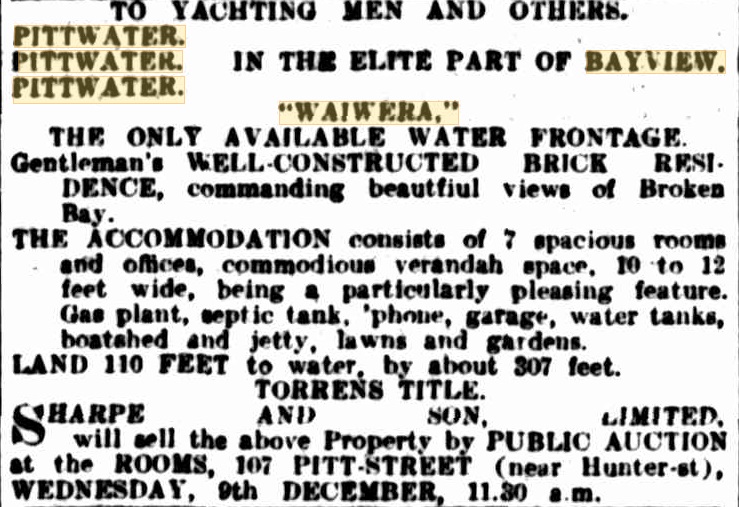
For sale: Advertising (1925, December 2). The Sydney Morning Herald (NSW : 1842 - 1954), p. 23. Retrieved from http://nla.gov.au/nla.news-article16258364
On December 22nd 1925 property went from Annie Isobel Forsyth to Ethel Margaret Andrew, wife of William Peter Colvin Andrew, Gentleman, of Wahroonga and one of the founders of the Elanora golf course with the Playfairs.
William Peter Colvin Andrew of Sydney Company and Sir Sydney Snow of Sydney Knight as joint tenants – February 23rd, 1937.
They sold to Doris Moore Northcott - Doris was born in 1892, to William Northcott and Jessie Alma Northcott.
Doris Moore Northcott sold to Paul Dowling of Bellevue Hill – company director – June 19th:
Dr. and Mrs. Walter Wearn in their "Waitangi," spent last week-end at Pittwater with six-months-old Margaret, who has bathing togs and is taken swimming. As her cot is now on board, they have mostly given up racing. Dr. Vickers took his infant out when only three weeks' old.
Mr. Paul Dowling, manager of the N.S.W. Bookstall, and a confirmed bachelor, whose cruising parties comprise male guests only, has a bitter pill to swallow in his ship's name. Changing names is a trying matter, so he grins and bears his "Faerie."
Dr. and Mrs. Furber and their sons, Professor Dakin, Mr. Windeyer, Mr. Laidley Dowling, J. M. Hardie, and the various members of the Nossiter clan, are others who have parties on the water. GILDED CRAFT and FLOATING FLATS (1934, January 27). The Australian Women's Weekly (1933 - 1982), p. 21. Retrieved from http://nla.gov.au/nla.news-article51428347
Paul Dowling sold November 29th, 1945 to his relative, Brendan Dowling
STATE PLANNING AUTHORITY ACT, 1963
Notification of Resumption
IT is hereby notified and declared by His Excellency the Governor, acting with the advice of the Executive Council, that in pursuance of the provisions of section 17 of the State Planning Authority Act, 1963, so much of the land described in the Schedule hereto as is Crown land is hereby appropriated, and so much of the said land as is private property is hereby resumed, under the Public Works Act, 1912, as amended, for the purposes of the State Planning Authority Act, 1963, together with all mines or deposits of coal, ironstone, kerosene shale, limestone, slate or other minerals under the said land (excepting any such mines or deposits as were reserved to the Crown in the original Grant of the said land) and that the said land is vested in the State Planning Authority of New South Wales.
Dated at Sydney, this 10th day of August, 1966.
(l.s.) A. R. CUTLER, Governor. By His Excellency's Command, P. H. MORTON, Minister for Local Government.
Schedule
All that piece or parcel of land situated in Bayview, Shire of Warringah, parish of Narrabeen, county of Cumberland, being part lots 7 and 8 in Deposited Plan No. 982, being the residue of the land in Certificate of Title, volume 6,276, folio 13 after Dealing No. H774802, having an area of 14 1/2 perches or thereabouts and said to be in the possession of Brendan Dowling. (File No. 7/45 IA 1,552) STATE PLANNING AUTHORITY ACT, 1963 (1966, August 19). Government Gazette of the State of New South Wales (Sydney, NSW : 1901 - 2001), p. 3415. Retrieved from http://nla.gov.au/nla.news-article220024351
Waiwera was owned by wealthy pastoralist Sir (David) Roy McCaughey Esq until 1962. They purchased the property in June 1954. His wife, who he married in 1944, was the widow of Harold North-Hunt, who lost his life soon after the Fall of Singapore:
MR. AND MRS. ROY McCAUGHEY shared the celebration of their ninth wedding anniversary with their three wins-for short-horn cattle-at the R.A.S., when they attended the Short-horn Society's buffet dinner at the Pickwick Club last night. Mr. and Mrs. McCaughey will leave in the Orion on April 11 for London to attend the coronation; during their absence Miss Lorna Lippman, of Potts Point, will be hostess at their home Coonong, Narrandera. Social News And Gossip (1953, March 29). The Sunday Herald (Sydney, NSW : 1949 - 1953), p. 22. Retrieved from http://nla.gov.au/nla.news-article18503779
GREAT planning for the Roy McCaugheys, who have bought an old home with a magnificent outlook at Bayview. . . . They intend to tear down the front part of the house and convert the back section into staff quarters. Then they will build a two-storied home facing the water and separated from the staff quarters by an Italian courtyard. A magnificent swimming pool in front of the house will complete their project. They will make the new home their "slightly out of town", residence and keep their flat at the Astor as the "in town" one. Personality Parade (1954, June 23). The Sun (Sydney, NSW : 1910 - 1954), p. 39 (LATE FINAL EXTRA). Retrieved from http://nla.gov.au/nla.news-article229714866
The Main residence, 'Hopton Lodge', was built in 1955.
Mr. and Mrs. Roy McCaughey are off to England in January to buy bulls, the while Plan A for their house at Bayview will be completed. Mere Chatter.. (1954, November 21). The Sun-Herald (Sydney, NSW : 1953 - 1954), p. 70. Retrieved from http://nla.gov.au/nla.news-article12647396
Change of plans for Mr. and Mrs. Roy McCaughey, who were to have gone abroad shortly on a rush trip to attend the cattle sales in Scotland in February. Roy has arranged for a "stand in" to cover the sales for him, as he and Mrs. McCaughey want to be here for the opening of the Royal Agricultural Show. Women's News Fashions and Gossip (1954, December 30). The Sun (Sydney, NSW : 1910 - 1954), p. 17 (LAST FINAL EXTRA). Retrieved from http://nla.gov.au/nla.news-article232002535
'Hopton Lodge' original plans sourced and framed by the Forbes family
Bay view: 1 Pittwater Rd.: B. cott. —D. R. McCaughey, 89 Phillip St., Sydney, O., £25,000; Pittwater Rd.: W.B. cott.—F. Snow, Cuppacumbalang, O., £8000. SMALL CONTRACTS (1954, December 29). Construction (Sydney, NSW : 1938 - 1954), p. 19. Retrieved from http://nla.gov.au/nla.news-article224518741
The Architects were also those responsible for another local project that year:
Montgomery Rehabilitation and Amenities Pavilion
WAR VETERANS' HOME, NARRABEEN, SYDNEY.
Architects: Fowell, Mansfield and Maclurcan. Consulting Engineers: Messrs. Woolacott, Hale and Bond. Master Builder: E. Spring-Brown. The Governor of N.S.W., Lt.-General Sir John Northcott, officially opened the Centre on Sunday, last, November 21, 1954.
.jpg?timestamp=1557020605622)
.jpg?timestamp=1557020529231)
THE MONTGOMERY REHABILITATION AND AMENITIES PAVILION. With the Restaurant stretching alonq the southern end of the bowling green and the curved roof of the Theatre on the west.
A STRIKING INTERIOR. Brightly coloured panels in the oiled Oregon ceiling grid impart an exciting to this interesting interior. note
THE THEATRE. The Theatre, showing the entrance and auditorium end, which is faced with sandstone.
THE SPACIOUS RESTAURANT. The spacious Restaurant, which has a direct view on to the bowling green.
THE SUNNY TERRACE. The zig-zag plate glass windows to the Restaurant, which is cafeteria style open on to a spacious terrace-promenade that looks right along the bowling rinks. Montgomery Rehabilitation and Amenities Pavilion (1954, November 24). Construction (Sydney, NSW : 1938 - 1954), p. 4. Retrieved from http://nla.gov.au/nla.news-article224518321
Joseph Charles Fowell (1891-1970), architect, is said to have been born on 2 August 1891 at Albany, Western Australia, son of Charles Wellesley Fowell, sometime clergyman of the Church of England, and his wife Frances Elizabeth, née Pemberton. Joseph was educated in England at the Dominican Preparatory and Fauconberge Grammar schools, Beccles, Suffolk; his boyhood interests included oil-painting and sailing. At Beccles he was articled to an architect F. E. Banham, but completed his training in London with Travers & Mileham. As an assistant with Gibson, Skipworth & Gordon (later with Atkinson & Alexander and others) he helped to design banks and country houses. In 1914 he became an associate (fellow 1930) of the Royal Institute of British Architects.
On the outbreak of World War I, Fowell was refused entry to the navy (having lost the use of one eye); through persistence, he was eventually commissioned in the Royal Naval Volunteer Reserve on 20 December 1915. He served with the Auxiliary Motor Boat Patrol in the English Channel, the North Sea and the Mediterranean. On 14 August 1919 at the Servite Church, Kensington, London, he married with Catholic rites 39-year-old Ettie Spong Horne.
They came to Sydney late in 1919. Fowell worked as first-assistant in the private practice of Professor Leslie Wilkinson with whom he formed an enduring friendship. In 1926 Fowell became an assistant to H. E. Budden. Kenneth McConnel and Fowell (partners 1928-39) won a competition in 1928 to design B.M.A. House (1933 bronze medal, R.I.B.A.). Their joint design for St Anne's Shrine, Bondi, received the 1935 Sulman award. Fowell was primarily responsible for the design of over forty churches in New South Wales and Victoria, including Catholic churches at North Sydney (1937), Parkes (1939) and Neutral Bay (1941). In enlarging (1934) St Charles's Church, Ryde, he was credited with the first significant architectural expression of Catholic liturgical change. He planned the altar to be free-standing, to join the congregation with the celebrant. His design (1941) for St Philip Neri's, Northbridge, was a further step in liturgical change and influenced later architects. Not content to leave details to others, he designed and supervised the execution of furnishings, sacred vessels and ornaments, and collaborated with sculptors, painters and stained-glass craftsmen.
In 1939 his wife passed away:
FOWELL.-January 15, 1939, Ettie, dearly beloved wife of Joseph C. Fowell, and fond mother of John. Requiescat in pace. Family Notices (1939, January 16). The Sydney Morning Herald (NSW : 1842 - 1954), p. 10. Retrieved from http://nla.gov.au/nla.news-article17548195
FOWELL.—A Requiem Mass for the Repose of the Soul of the late Mis E. S. FOWELL will be celebrated at St. Joseph`s Church, Lindsay Street, Neutral Bay THIS Monday MORNING at (11o’clock The funeral will leave the church at 130 pm for Brooklyn Cemetery Hawkesbury River. Family Notices (1939, January 16). The Sydney Morning Herald (NSW : 1842 - 1954), p. 9. Retrieved from http://nla.gov.au/nla.news-article17548209
At St Joseph's Catholic Church, Neutral Bay, on December 8th, 1939 Fowell married Eileen Stella Hunt (born 1882). A fellow (1931) of the Royal Australian Institute of Architects, he was vice-president (1941-42 and 1946-47) of the New South Wales chapter and was to receive its gold medal in 1962. Intermittently, he was also a member of the Board of Architects.
In 1950 he was a founder of the Blake prize for religious art and was subsequently life president of the Blake Society. Continuing his leadership in design, Fowell remained senior partner of the firm, which was joined by J. L. S. Mansfield (1939), D. C. B. Maclurcan (1946) and O. R. Jarvis (1962); one unusual commission from 1946 involved refitting passenger ships released by the navy. In the 1960s the firm completed large projects such as the Sydney County Council building (1960), and the Gladesville and Tarban Creek bridges (R.A.I.A. civic design award, 1965).
An accomplished draftsman with a fine feeling for line and colour, Fowell studied life drawing under Desiderius Orban in the 1950s. Four of Fowell's water colours, painted in the Mediterranean during World War I, were accepted by the Australian War Memorial, Canberra. He was reserved, astute and introspective. His assistants remembered his white hair, his kindness, and his soft-pencil sketches—smudged with cigarette ash—over their drawings. Survived by his wife and the son of his first marriage, he died on July 3rd, 1970 at his Bayview home and was buried in Northern Suburbs cemetery.
In the magazine 'Ebony' Vol. 21, No. 12 - Oct 1966 - Page 84 - we can see Mr. Fowell at his home at Bayview:
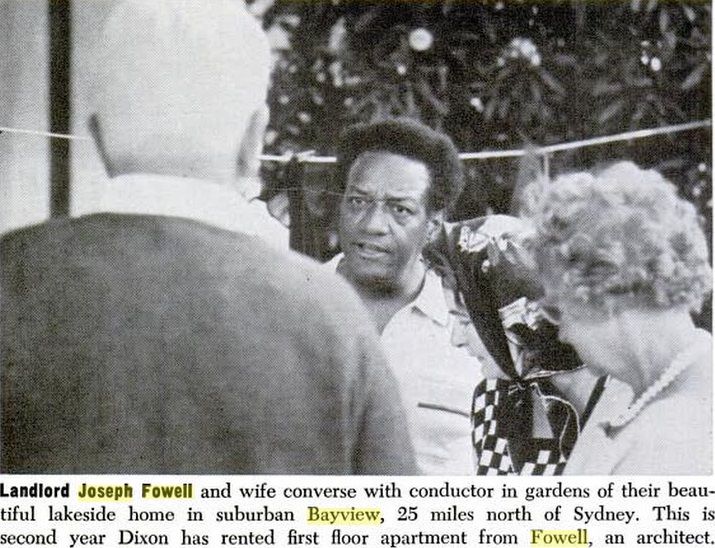
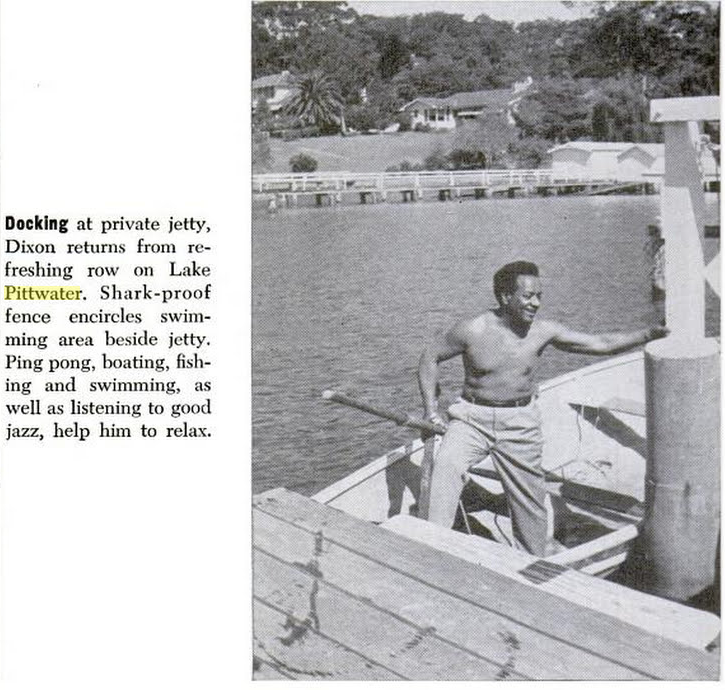
YES! That's Hopton Lodge with a much smaller Palm to the left.
And who is Mr. Dixon to Sydney in 1966?:
.jpg?timestamp=1557018621488)
.jpg?timestamp=1557018663371)
.jpg?timestamp=1557018715375)
A Palm alongside Hopton Lodge's waterfront in 2019
A Palm alongside Hopton Lodge in 2019 - a fair bit taller half a century later.
Last Summer for McCaughey’s at Bayview:
BECAUSE everyone will have had so much poultry and ham by then, Mr. and Mrs. Roy McCaughey are going to entertain friends at a barbecue luncheon party at their sea-side home, Hopton Lodge, Pittwater Rd., Bayview, on New Year's Day. The barbecue at Hopton Lodge is really out of the box — set in a glorious garden and wire screen enclosed — so that not a fly can buzz round the sizzling steaks. SOCIAL ROUNDABOUT (1961, January 4). The Australian Women's Weekly (1933 - 1982), p. 12. Retrieved from http://nla.gov.au/nla.news-article46469324
By the Winter of 1962 the Northam’s owned it:
Gala clothes far glamor cup
Red-white-and-blue spinnaker of Australia's challenger, Gretel, inspired this wardrobe. ALD. and Mrs. Bill Northam, of Darling Point and Bayview, N.S.W., sailed in Arcadia recently to attend the America's Cup races at Newport in September. Here are some of the clothes Mrs. Northam bought for her trip. General Robert Johnson, of Princeton, New Jersey, has lent the Northams his yacht, Argosy, to entertain Gretel's Australian crew, which includes Mr. Northam's son Brian. Gala clothes far glamor cup (1962, August 1). The Australian Women's Weekly (1933 - 1982), p. 3. Retrieved from http://nla.gov.au/nla.news-article46457810
ARRIVING from Rumson, New Jersey, America, on October 5 are Mr. and Mrs. Arthur Clathan, who will stay with the Bill Northams at their lovely house on the waterfront at Bayview for one week. There are a number of sightseeing trips planned for them as well as visits to some of their friends who live in Sydney. After a week at Bayview they will go on to Melbourne for a stay and then, they hope, to the Barrier Reef.
AND, speaking of the Northam family, Mrs. Northam was so excited about a letter she received from their son, Rod, who is at present in England. He has just finished a business course at Sussex University and is off on a tour of the north of England before crossing over to Europe on a business trip to Hamburg, Zurich, and Rome, spending a month in each place. He will later go to America to work and (in the Northam tradition) hopes to be in Newport in time for the America's Cup. SOCIAL ROUNDABOUT (1966, September 21). The Australian Women's Weekly (1933 - 1982), p. 22. Retrieved from http://nla.gov.au/nla.news-article44026410
The Northams sold to the Goddards and the Goddards to Mr. Delmege.
Thankfully the Forbes family purchased the property before it could disappear from the landscape of Pittwater.
Interestingly the two owners who have held the property the longest are both Australian Olympic Medallists in the sport of sailing - Sir Northam and Mr. John Forbes.
The 'Waiwera' Decades: Owners + building Insights
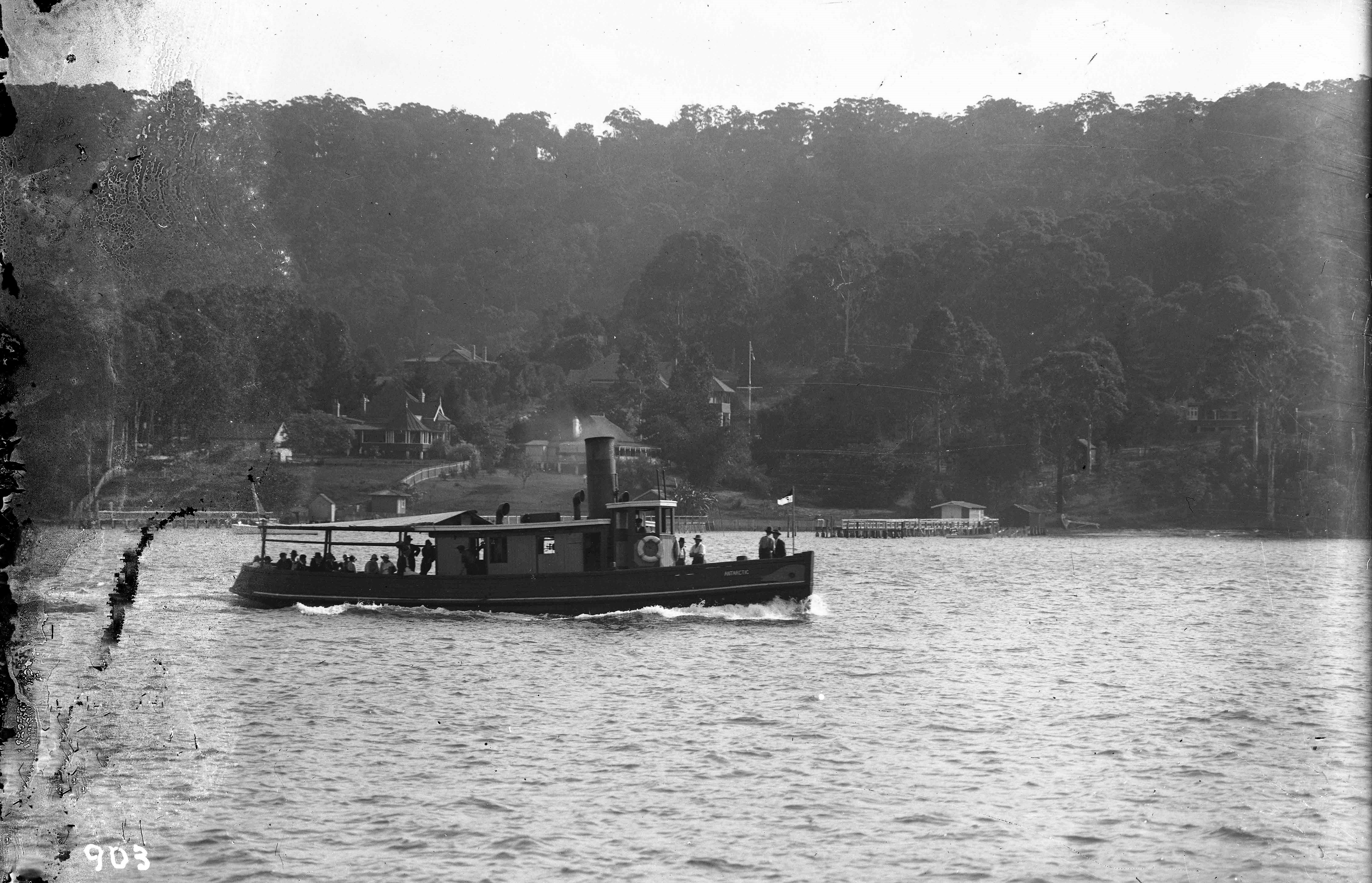
Tugboat ANTARCTIC during the 1924 Pittwater Regatta, courtesy Australian National Maritime Museum, Image no.: 10670, photo taken by William J Hall or his father William Frederick Hall - Waiwera is in the background - section from enlarged to show detail:
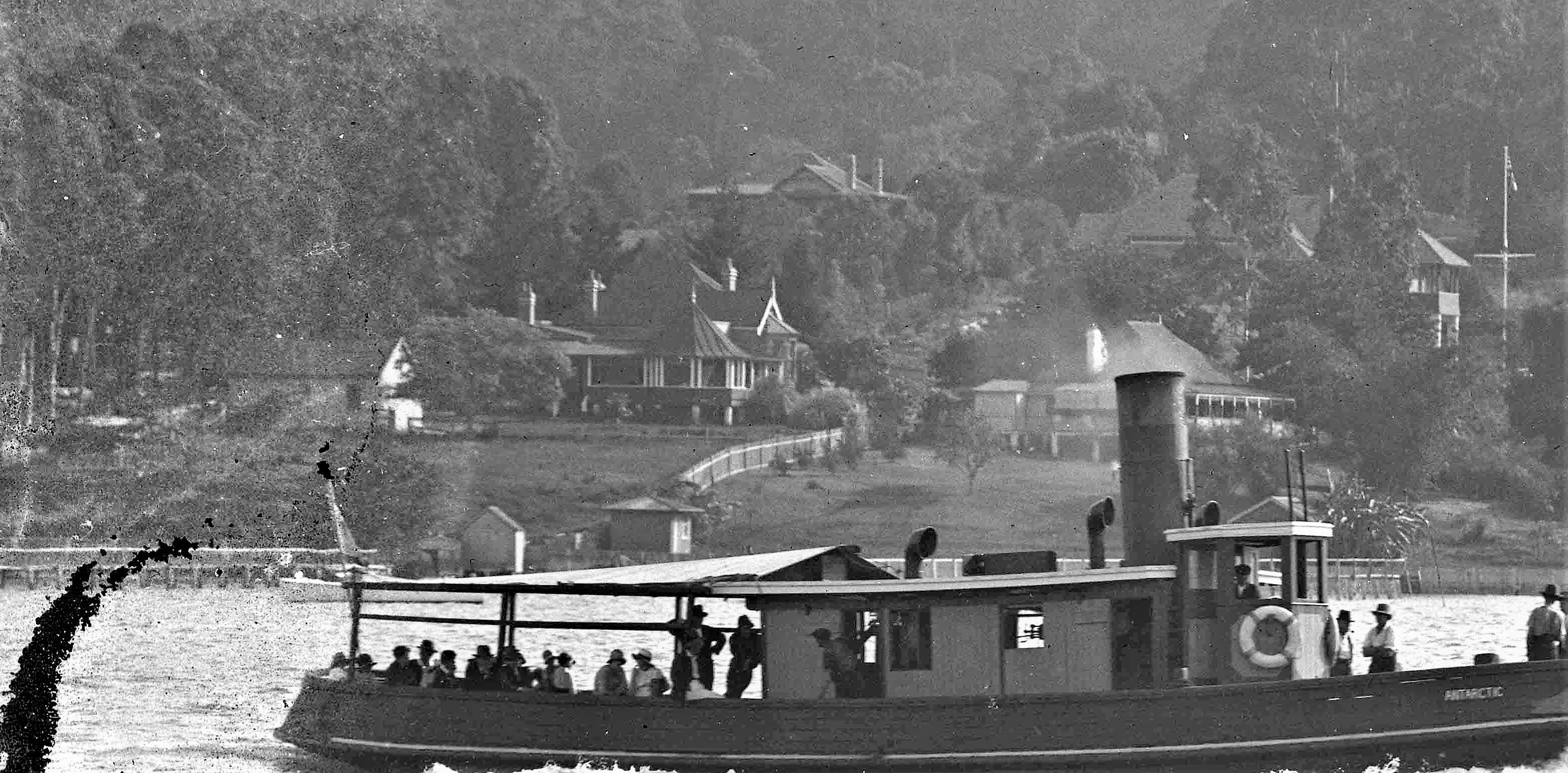
Waiwera is a locality situated in the north of the Auckland Region in New Zealand. The name is of Māori origin and means "Hot Water". Its main claim to fame are the hot water springs which were well known in pre-European times and reputedly visited by Māori from as far away as Thames. - Wikipedia
Oscar Granowski
An Engineer who arrived in Australia from Germany in 1885. He married in Sydney in 1889 GRANOWSKI OSCAR WILHELMINA ADOLINE A SYDNEY
[Notice under Section 11 of the Bankruptcy Act, 1887.]
In the Supreme Court of New South Wales. (1,444)
IN BANKRUPTCY.
Re Oscar Granowski.
NOTICE is hereby given that a Sequestration Order has this day been made against the abovenamed Oscar Granowski, of No. 167, Cleveland-street, Sydney, engineer, on his own petition.—Dated at Sydney, this 15th day of April, a.d. 1889.
ARTHUR HENRY,
Registrar in Bankruptcy. IN BANKRUPTCY. (1889, April 18). New South Wales Government Gazette (Sydney, NSW : 1832 - 1900), p. 3053. Retrieved from http://nla.gov.au/nla.news-article223993924
In re Oscar Granowski : The bankrupt did not attend, and the meeting was adjourned sine die. In Bankruptcy. (1889, May 11). Evening News (Sydney, NSW : 1869 - 1931), p. 6. Retrieved from http://nla.gov.au/nla.news-article108894896
The couple were already in Queensland:
NOTICE is hereby given that the PARTNER SHIP lately subsisting between us, the undersigned, ALBERT LANFEAR, GEORGE NICOL, and OSCAR GRANOWSKI, carrying on business as Ice Manufacturers at Brisbane under the name, style, or firm of "Lanfear & Nicol" (West End Ice Works), has this day been DISSOLVED by mutual consent so far as regards the said Oscar Granowski, who retires from the firm. All debts due to or owing by the said late firm will be approved and paid by the said Albert Lanfear and George Nicol, who will continue the said business under the present style or Arm of '"Lanfear & Nicol."
As witness our hands this Nineteenth day of June. 1891. ' ALBRERT LANFEAR: GEO. NICOL. OSCAR GRANOWSKI.
Witness-Arthur S, Curtis, clerk to Messrs. Chambers;, Bruce, M'Nab, Solicitors, Adelaide street, Brisbane. Classified Advertising (1891, June 20). The Brisbane Courier (Qld. : 1864 - 1933), p. 2. Retrieved from http://nla.gov.au/nla.news-article3527598
Law Courts.
Supreme Court. Civil Sittings.
Before his honour Mr. Justico Cooper and juries of four. .
Mr.Feez (instructed by Messrs. Bernays and Osborne) for plaintiff, the Attorney General and. with, him Mr. Rutledge (instructed by Messrs/Macpherson and Feez) for the defendant.
This was an action for defamation of character. Plaintiff, Oscar Granowski, consulting engineer, alleged that defendant, William Barker Shaw, in a conversation with Mr. Harry Baynes, in the hall of Menzies' Hotel, Melbourne used certain slanderous language concerning him. Plaintiff claimed £1,000 damages.
Defendant in his statement of defence submitted that if the words were used they used in Melbourne where he (defendant) was permanently domiciled, and the action should have been instituted there. He made a general denial of the use of the words. As an alternative, he pleaded that if the words were used they were used in good faith and without malice.
After some argument on the jurisdiction of the court, evidence was given for plaintiff as follows :— .
Harry Baynes, a member of the Graziers' Butchering Company, deposed to having employed plaintiff, and prior, to 1895, he looked upon him as a thoroughly practical man in connection with meat works. In July, 1895, witness was in Melbourne. On July 5 be saw defendant in the hall at Menzies' Hotel. Defendant shook hands with witness and said, "That's a nice thing that , you have done in recommending that man Granowski. He doesn't know his business, and knows nothing whatever about meat works. If you had wanted to do us an injury you could not have done it better than by recommending that man to us. The man is a. —— scoundrel, and it cost me £200 out of my own pocket to get rid of him. And only that I know you. Baynes, I should think you recommended this man to us to ruin the company."
There was other talk, but that was the gist of the conversation. Defendant spoke loudly, and was a little excited. Anyone passing could have heard. There were several people in the hall at the time. "Witness felt very sore about the matter, having recommended the man. The statement somewhat shook his belief in plaintiff. On his way back witness when in Sydney, in consequence of what defendant had said, called on Barr, Johnson, and Co., the erection whose meat works defendant had supervised. About a month after arriving in Brisbane he saw plaintiff, and he saw him several times before plaintiff knew about what defendant said. Plaintiff spoke to witness about the matter, and then witness told him what defendant had said.
Cross-examined by Mr. Byrnes: It was about July 6 when witness told Granowski. He had strongly recommended him to the Gladstone Meatworks Company. Defendant did not say, " You are a nice man to recommend an engineer to us whom you have not employed yourself." Defendant asked if plaintiff was such a good man why he had not employed him? Witness told him his 6rm did not like the machine he was agent for. Witness's firm had paid Granowski on different occasions about £100. Mr. Shaw spoke in his ordinary tone of voice. Witness thought plaintiff was in the employ of the Gladstone meat works. He believed there was a gentleman with Mr. Shaw.
Oscar Granowski, plaintiff, gave evidence regarding the nature of the work in which he was employed since his arrival in Australia in 1885, being chiefly as engineer in connection with the erection and management of refrigerating machinery and premises. He also recounted the circumstances of his employment by the defendant's company, the Gladstone Meat Works. Defendant was chairman of directors. Subsequently a dispute arose between defendant and witness over the recommendation of Haslam refrigerating machinery. Defendant wanted plaintiff to recommend the Haslam machine, but plaintiff declined to do so. Defendant warned him not to oppose him, and said he was not used to being opposed. Witness next day recommended the acceptance of the lowest tender. Defendant became very angry, and threatened to ruin his reputation. Subsequently, the directors offered to pay him £700 and he was to have nothing more to do with the works. In connection with the Gladstone meat works he was asked to draw up plans, showing an expenditure of £12,000, on which the company was going to get £15,000 from the Meat and Dairy Board. Witness declined, but subsequently drew the plans, and handed them over, believing he would get them back. Defendant said something about relations with a Minister of the Crown and getting the thing through.
Cross-examined by Mr. Byrnes: Plaintiff said his relation with the Graziers' Company commenced in 1893. He received about £70 altogether from the company. He was a native of Germany, and was a naturalised British subject. At the Townsville works he was at the head of the establishment as refrigerating expert.
Mr. Byrnes : "When you referred to relation with a Minister of the Crown, did you mean to impute that, something improper was about to be done?
Witness:. What is improper? Is it improper to do something against the law?
His Honour: Yes.
Witness: Then I say yes.
Mr Byrnes: Did Mr. Shaw mention the name of the Minister? .
Witness: Yes he did,, and also his co-directors.
Mr. Byrnes: Who was the Minister?
Witness: I decline to answer unless compelled.
Mr. Byrnes pressed for an answer.
Witness: It was the Hon. R. Philp'
Mr. Byrnes: You consider, something was about to be done contrary to the law.
Witness: I understood that something was to be done which was contrary to' the law. I understood that I was requested to do something which would enable the company to make the application contrary to the law.
Mr. Byrnes: But notwithstanding that you lodged the plans as requested ?
Witness: Yes.
Mr. Byrnes: Although you knew they were contrary to the law ?
Witness: I did not know they would not come back to me. The directors insisted on it.
In farther cross-examination, witness was asked if he intended to suggest that defendant wanted to get £15,000 from the meat and dairy funds on plans for works estimated to cost £12,000. He replied by saying, "I was told to make plans to show £30,000, and the money to be expended was not shown."
The case for the plaintiff was shortly afterwards closed.
Mr. Byrnes applied for a nonsuit on the ground that toots committed outside the jurisdiction of the colony must be inquired into at the place where they were committed.
His Honour ruled against Mr. Byrnes on the question of nonsuit.
Mr. Byrnes then addressed the jury, opening the case for the defence. .
Evidence was called for the defence, as follows:—
William Barker Shaw, defendant, said he lived in Albert Park, Melbourne, Victoria. He had been resident in Victoria since 1856, but he had interests in Queensland and Now South Wales. He gave evidence relating to certain differences between himself and plaintiff. With regard to the plans for the Meat and Dairy Board the directors wanted of plaintiff, in the first place, a sketch or ground plan of the works. The suggestion that they wanted him to submit u plan to the Meat and Dairy Board, in order to get a larger loan than they were entitled to, was absurd. He denial that he said he had sufficient pull with the Government, and could work his way, or that he helped a Minister of the Crown and that Minister would have to do something in return. He never had any transaction with Mr. Philp of any kind. The only Minister of the Crown he saw was Mr. Barlow, when he waited on him simply as chairman of the company. The loan of £15,000 had been approved, but so far it had not been availed of. The company had already spent £20,000 on the works. The question of ordering refrigerating machinery did not arise until months after plaintiff had left the employ of the company.
When he met Mr. Harry Baynes in the hall at Menzie'a hotel, it was the first time he had seen him since the appointment of Mr. Granowski. When they had shaken hands witness said, "You are a nice man to recommend us an engineer, whom you have not employed yourselves." Mr. Baynes said, " We have employed him." Witness said,' "You did not employ him to erect your South Brisbane freezing rooms." What Mr. Baynes replied did not remember. Nothing more was said.
When witness came to Brisbane in November and December he first heard of the complaint of slander, which it was alleged had taken place in July previous. At this stage, owing to the absence through illness of a juryman, Mr. Mactaggart, the case could not be proceeded with in the ordinary course.
It was agreed to adjourn the case till May 1, but to allow of two witnesses for defendant to leave for Melbourne again, it was decided that their evidence be heard. The further cross-examination of the defendant was adjourned, and the evidence of the two witnesses was taken to the following effect:—
Thomas H. Houghten, a consulting engineer, said he was present in the hall at Menzies Hotel with defendant on the day referred to. The conversation referred to lasted during only a few moments. Witness heard no name mentioned. He did not hear defendant say, "He (Granowski) does not know his business, and knows nothing about meat works. If you had wanted to do ns an injury yon could not have done it more than by recommending that man." He did not hear defendant say "the man is a scoundrel; it has cost me £200 out of my own pocket to get rid of him, and only that I knew yon, Baynes, I would think you recommended that man to rain the company." If he had said that witness must have heard it, as he was standing close beside defendant. He did not hear the name of Granowski used at all on that occasion. Witness had heard Granowski's name previously, and if the name had been used he would have noticed it. The name was not unfamiliar. Defendant was not excited when he was speaking.
Examined by. Mr. Feez: Witness was at present consulting engineer of the Gladstone Meat Company. He received plaintiff's position after the dispute when he left the company. Witness did not know that Mr. Shaw (defendant) recommended him. Witness had arrived at Melbourne from Sydney on the day of the alleged slander. He had not been appointed engineer to the meat works then. He was appointed engineer about last August or September.. The case was then adjourned till May 1. Law Courts. (1896, April 24). The Week (Brisbane, Qld. : 1876 - 1934), p. 11. Retrieved from http://nla.gov.au/nla.news-article183092441
Birth.
GRANOWSKI.—On September 12, at her residence, Villiers street; New Farm, the wife of Oscar Granowski, of a son. Family Notices (1896, September 15). The Telegraph (Brisbane, Qld. : 1872 - 1947), p. 4. Retrieved from http://nla.gov.au/nla.news-article172146602
The ordinary monthly committee meeting of the Brisbane Chamber of Commerce was held yesterday, there being present Messrs. A. J. Carter (chairman), A. H. Chambers, T. Welsby, A. D, Walsh, A. F. Luya, J. D. Campbell, J. Macdonald, T. Leahy, C. E. Bernays, J. K. Stewart. Messrs. Oscar Granowski, H. J. Diddams and Co., James Clark, Duncan Sinclair, Helidon Spa Company, Queensland Canning Company, and Captain R. S. Taylor were elected members of the chamber. Apologies for absence were read from several members. BRISBANE CHAMBER OF COMMERCE. (1898, December 6). The Brisbane Courier (Qld. : 1864 - 1933), p. 3. Retrieved from http://nla.gov.au/nla.news-article3683741
Mr. and Mrs. Granowski left last week for Sydney, where they will in future reside. SOCIAL GOSSIP. (1903, April 11). The Queenslander (Brisbane, Qld. : 1866 - 1939), p. 838 (Unknown). Retrieved from http://nla.gov.au/nla.news-article21811495
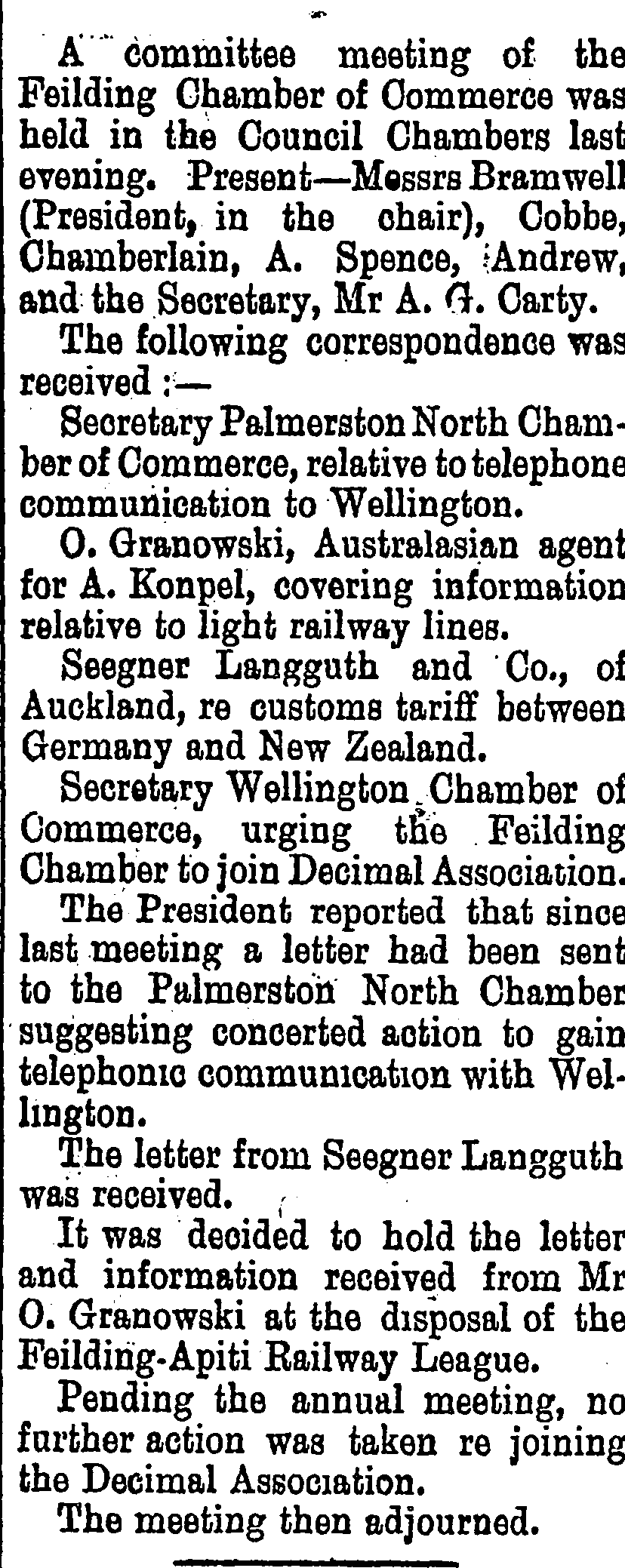
Retrieved CHAMBER OF COMMERCE. FEILDING STAR, VOLUME XXV, ISSUE 18, 7 JULY 1903 - New Zealand newspapers. He sent letters throughout New Zealand over the next few months speaking about the process of welding rails together by the use of 'thermit'.
By early 1906 he had established his family in a house at Turramurra. Mr O Granowski - Residence 07/02/1906, Turramurra New South Wales Australia. He prospered, enough to get robbed and take members of his family for a visit to his birthplace:
Burglaries on the North Shore Line.
WHAT THE POLICE FOUND. TRUNK BURIED IN THE SAND.
Frederick King, 42, a labourer, was charged before Mr. Wilshire, S.M., at the North Sydney Police Court, with burglary in the houses of Oscar Rowe, Springfield-road, Killara; Oscar Granowski, 'Dembowalouka.' Kuringai Chase Avenue, Turramurra; and Mary Ann Murphy, 'Ko-dfmiris,' Woonona, Avenue, Wahroonga. The value of the goods stolen from Howe's was £20, from Murphy's £100, and from Granowski's £50. The articles consisted of silverware, electroplate, jewellery, and money. Senior-constable Jordan's story was that at about 7 p.m. on March 1... After the owners of the property had identified their portion of it, King was committed for trial. Burglaries on the North Shore Line. (1906, March 30). Evening News (Sydney, NSW : 1869 - 1931), p. 7. Retrieved from http://nla.gov.au/nla.news-article114223552
Gresser Kurfuerst, I G M S., G. Rott, for Bremen and ports. Passengers …. Mr O. and Mrs. Granowski, Messrs. Oscar and R. Granowski … SHIPPING INTELLIGENCE. HOBSON'S BAY. (1911, March 29). The Argus (Melbourne, Vic. : 1848 - 1957), p. 12. Retrieved from http://nla.gov.au/nla.news-article10890193
And obviously wired money or had it placed here prior to departing:
In the Supreme Court of New South Wales.
(No. 1,144 of 1869.)
IN BANKRUPTCY.
Re Oscar Granowski; ex-parte Oscar Granowski.
TAKE NOTICE that the Sequestration Order made herein, on the fifteenth day of April, one thousand eight hundred and eighty-nine, has this day been discharged.—Dated this nineteenth. day of April, a.d. 1911.
JOHN WILLIAMSON & SONS,
Solicitors for Oscar Granowski, 163 King-street, Sydney. IN BANKRUPTCY. (1911, April 26). Government Gazette of the State of New South Wales (Sydney, NSW : 1901 - 2001), p. 2322. Retrieved from http://nla.gov.au/nla.news-article221618458
And came back again:

Advertising (1912, July 6). The Sydney Morning Herald (NSW : 1842 - 1954), p. 25. Retrieved April 8, 2019, from http://nla.gov.au/nla.news-article15345757
In 1915 - Granowski, O., C.E. (Machinery Inspector), 387 Kent St, and is still doing the same in 1918, when anti-German sentiment was running high and even though relatives served as Australians in that conflict.
It is worth remembering that he relinquished Waiwera and sold the cottage in 1918 and, as recorded in the court case report above, had become a naturalised Australian citizen decades before this. Although the authorities had trouble finding that Certificate, it is easily found in the National Archives of Australia records. The failure earlier may have been due to him going by 'Oscar' when his first name was 'Frederich' - imagine going through this, over and over:
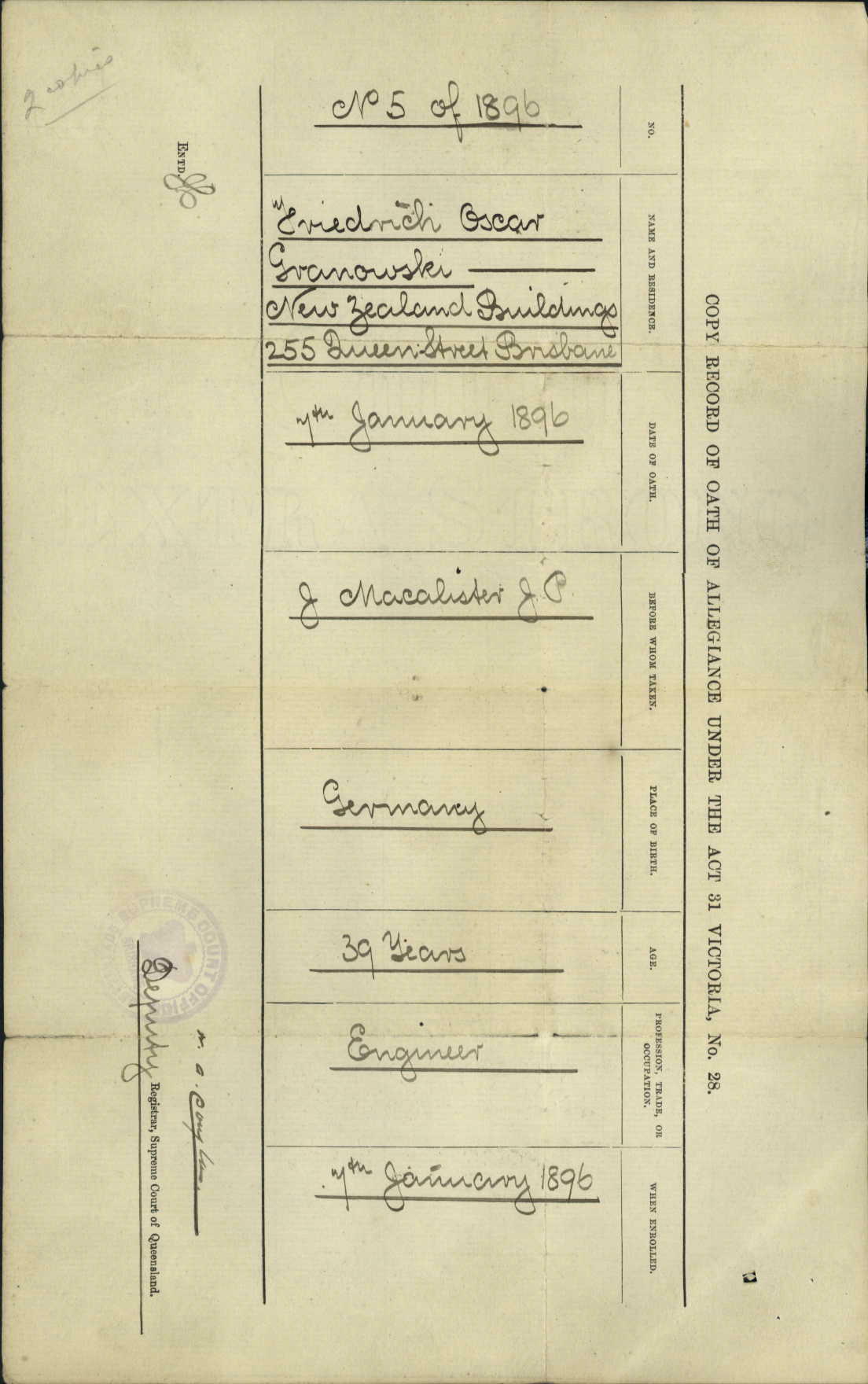
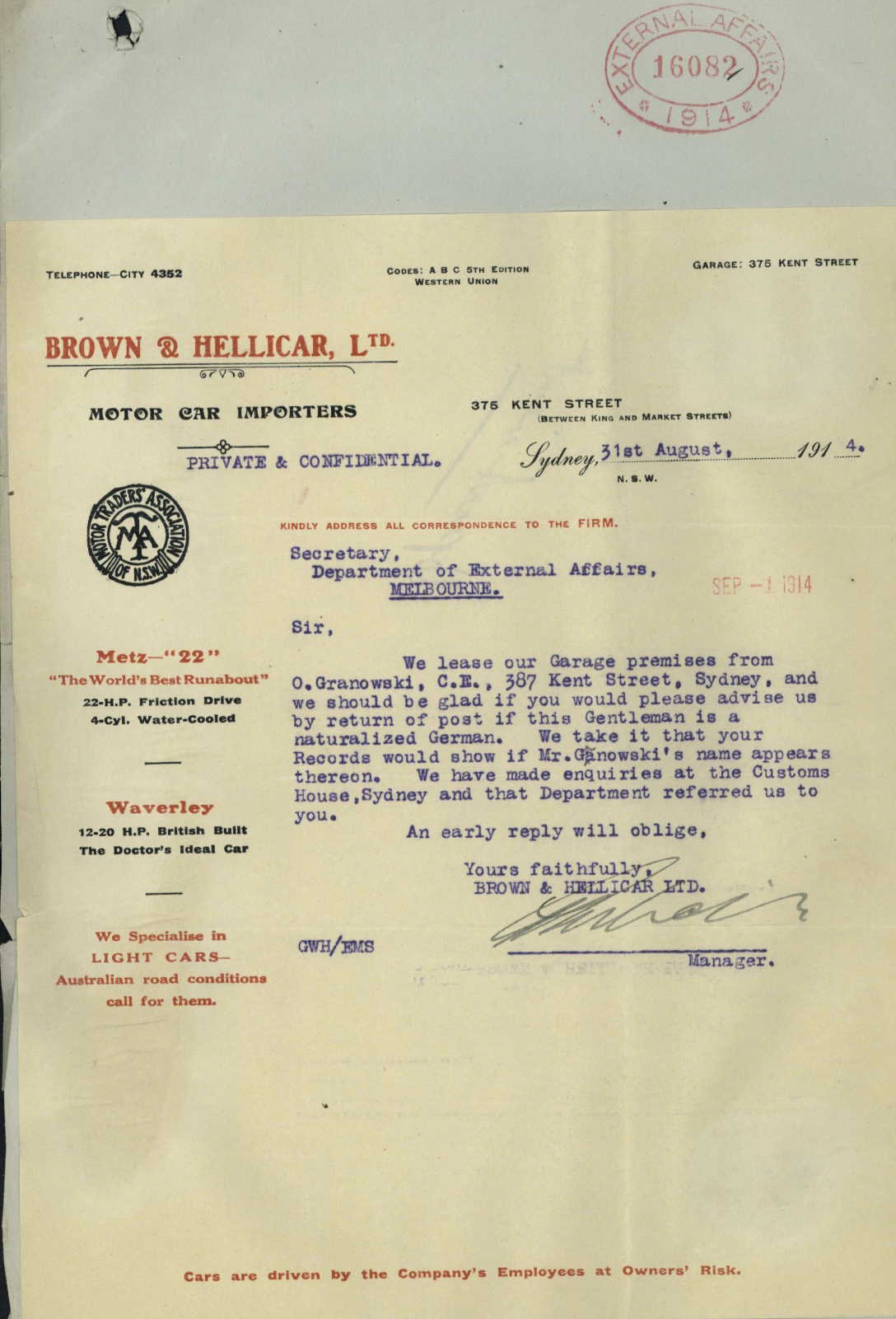
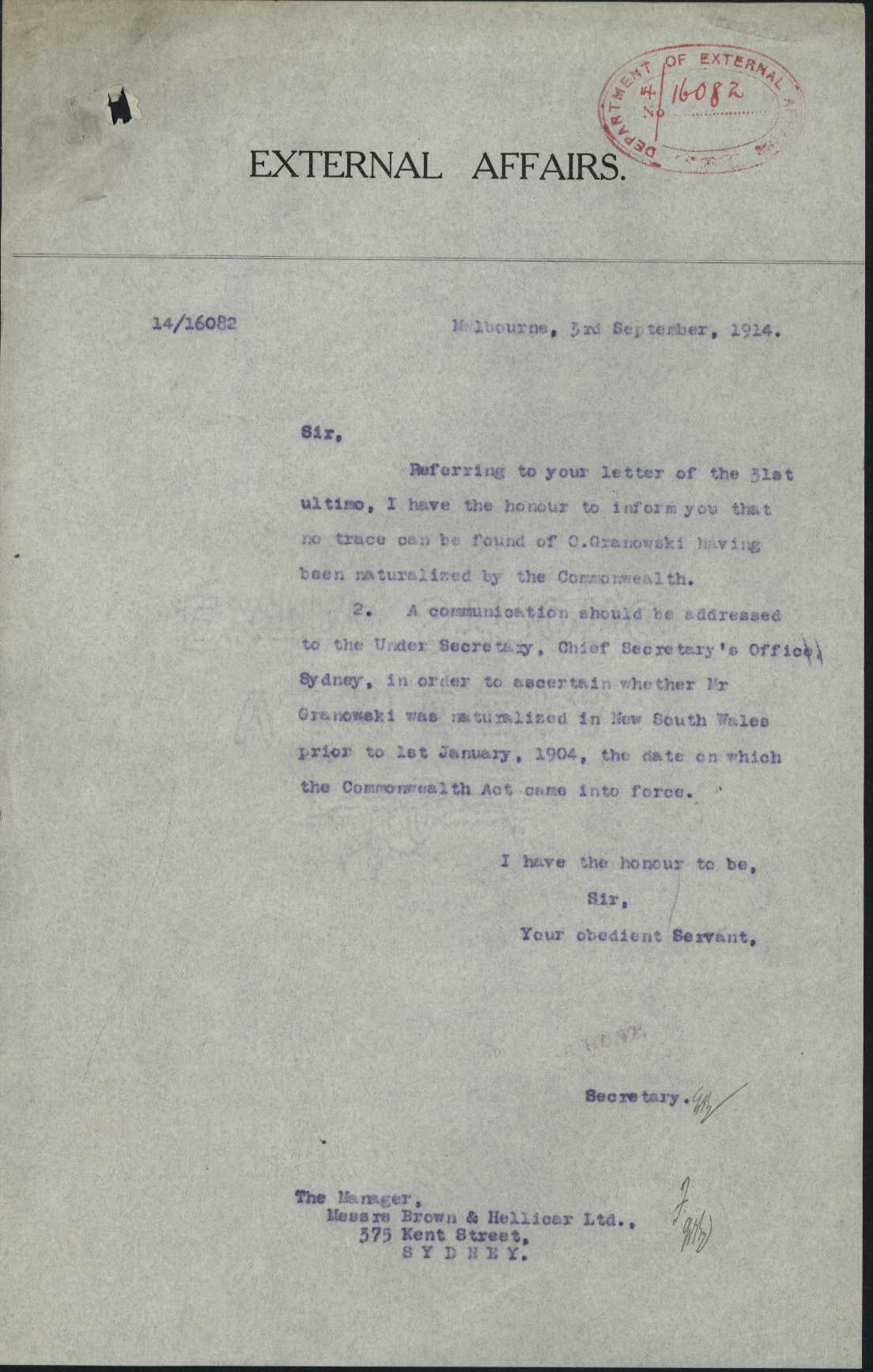
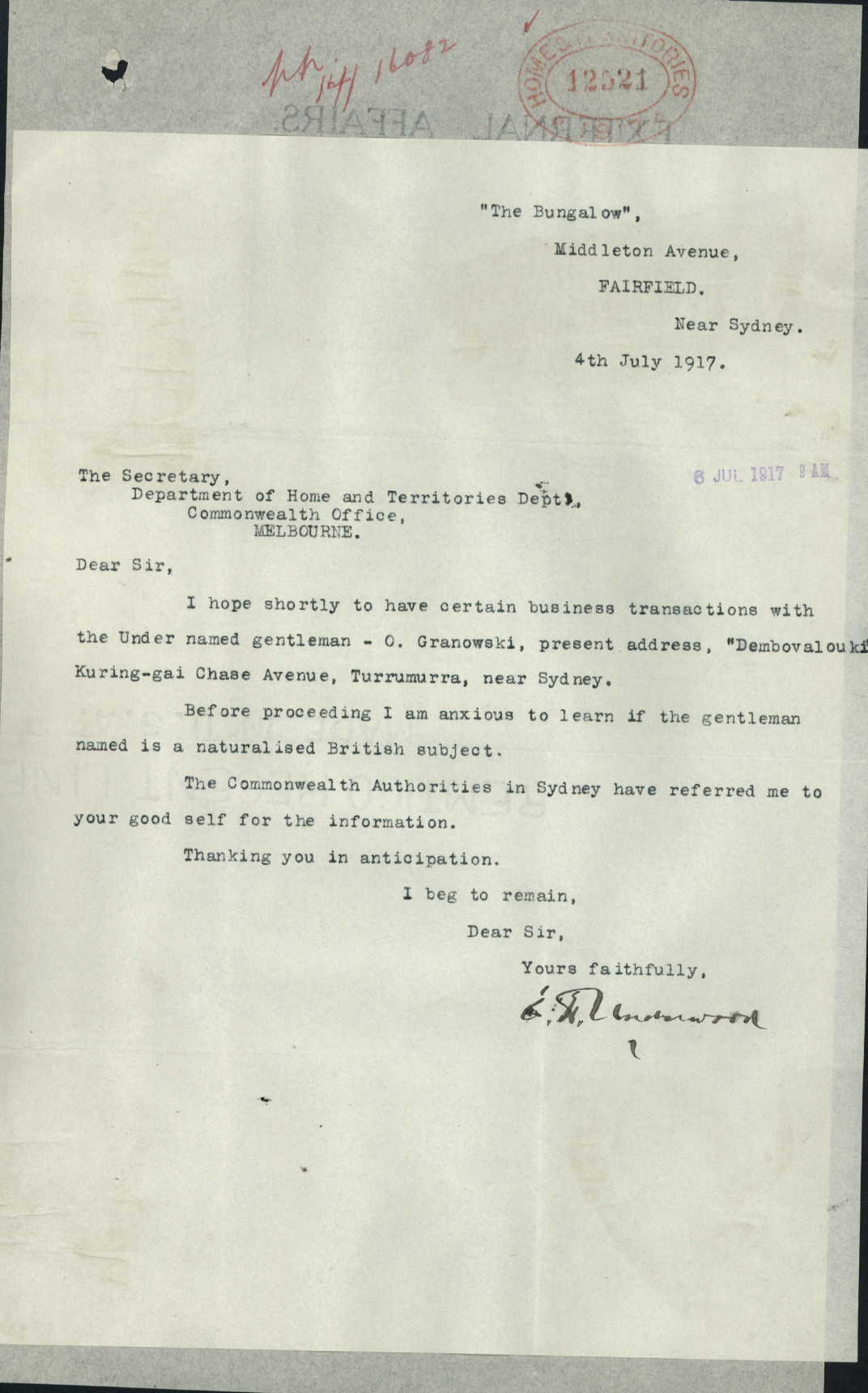
Margaret Tink recalled that there were Granowskis a bit further along the road at Bayview in the 1930s, hopefully his descendants in another Bayview Summer House.
GRANOWSKI OSCAR CLEM : Service Number - NX128174 : Date of birth - 21 Jan 1922 : Place of birth - DUBBO NSW : Place of enlistment - NSW : Next of Kin - GRANOWSKI MARY
Financial assistance to Oscar Granowski - Mortgage by Mrs L Granowski to the Commonwealth - 1917 - Australian Archives
Alleged Granting of Patents to Alien Enemy Firms
According to ' Hansard,' Dr. Maloney said in the House of Representatives last week: — The other day I asked a question about the granting of patents to alien enemy firms, particularly Australia Thermit Ltd., which has been declared by the Attorney-General to be an alien enemy company. A letter I have received explains the circumstances very clearly. In that letter it is stated — 'In 1915 a Bill was brought in which enabled me to apply for the voidance or suspension of German patents held by Hans and Karl Goldschmidt, of Essen, Germany, for. welding rails and other metal pieces.' I duly made my application, which was heard before the Commissioner of Patents, being Represented by J. H. Mackey, barrister, Melbourne, and was successful, the Government (Hughes, Attorney-General) shortly after declaring suspension of these patents, and what is more, declared by proclamation that Hans and Karl Goldschmidt were alien enemies. Also, that the company, Australian Thermit Limited, Sydney, was an alien company, and wiped them out. This company is, or was, a Sydney company, run by Oscar Granowski, who was a principal shareholder and a German. The dominating interests in this company were held by H. and K. Goldschmidt, who had already been declared alien enemies. Later, on, during the end of 1915, or beginning of 1916. these very Germans applied for the renewal of two German patents, taken out, of course, in Australia, and were granted an extension of seven years to 1923.' Surely if this Parliament and Government are to obtain kudos for preventing enemy aliens from owning and controlling patents, we ought to prevent such persons from obtaining extensions of patents in the way described in that letter. If these people are worthy to hold patents, why were the original patents taken from them, at great expense? In reference to this matter, I should like to quote from the Australian Official Journal of Patents ' for 1916, volume 24. in which is given a list of renewal fees paid, and on that list are the following: 1909. 16,318. Goldschmidt, H. and K., butt-jointing rails. 8th April, 1923. 1910. 17,334. Goldschmidt, H. and K„ , squaring rail ends. 26th March, 1923. The Oscar Granowski mentioned in the letter from which I have quoted is the agent for these men, who live, I think, in Essen, or some other German town. What is the use of declaring these men alien enemies, and then granting them extensions of patents? I hope that the Government, even in the dying days of this Parliament, will make inquiries, and do something— that they will not adopt a laissez faire method, and thus allow more occurrences of the kind. Alleged Granting of Patents to Alien Enemy Firms (1917, March 23). Graphic of Australia (Melbourne, Vic. : 1916 - 1918), p. 4. Retrieved from http://nla.gov.au/nla.news-article153077973
He lost land when railways were being built:
Notification of resumption of land
UNDER THE "PUBLIC WORKS ACT, 1912.
IT is hereby notified and declared by His Excellency the Governor, acting with the advice of the Executive Council, that so much of the land hereunder described as is Crown Land has been appropriated, and so much thereof as is private property has been resumed, under the "Public Works Act, 1912," for the following public purpose, namely, the construction of a line of railway from Dunedoo to Coonabarabran, in the State of New South Wales, and is vested in the Minister for Public Works, as Constructing Authority on behalf of His Majesty, for the purposes of the "Dunedoo to Coonabarabran Railway Act, 1911." Dated the second day of February, one thousand nine hundred and sixteen.
G. STRICKLAND,
Governor.
by His Excellency's Command,
J. H. CANN,
Minister for Public Works.
Description of Land referred to.
All that piece or parcel of land situate in the Land District of Coonabarrabran, parish of Moorangoorang, county of Napier, and State of New South Wales, being part of portions 4 and 1, and part of the land comprised in conditional purchase 12-17 : Commencing at the intersection of the eastern boundary of portion I aforesaid with the north-western boundary of the Dunedoo to Coonabarabran Railway bearing 359 decrees 26 minutes 58 seconds and distant 45 chains 2'3 links from the south-eastern corner of portion 4 aforesaid; and bounded thence by part of that north-western boundary bearing 235 degrees 44 minutes 30 seconds 1 chain 24'2 links; thence on the north-west by lines bearing 41 degrees 42 minutes- 20 seconds 2 chains G"2 links 55 degrees 41 minutes 30 seconds 11 chains 3'7 links to the south-western side of a reserved road 1 chain wide: thence by part of that south-western side bearing 127 degrees 2(5 minutes 58 seconds 52'7 links to the north-eastern boundary of the aforesaid railway; thence by part of that north-western boundary bearing 235 degrees 44 minutes in seconds 11 chains 96 links, to the point of commencements-by the said several dimensions all a little more or less, containing an area of 2 roods 12 perches or thereabouts, and numbered 97a and 98a on plan of the aforesaid railway, and said to be in possession of Oscar Granowski.
Also, all that piece or parcel of land, situate in the land district, parish, county, and State aforesaid, being part of portion 1, and part of land comprised in conditional purchase 12-1/: Commencing at a point on the south-eastern boundary of the Dunedoo Coonabarabran Railway bearing 159 degrees 33 minutes 50 seconds and distant 42 chains 07 links from the south-eastern corner of portion 4; and bounded thence by part of that south-eastern boundary bearing 55 degrees 41 minutes 30 seconds 13 chains 80 1 links to tho south-western side of a reserved road 1 cli tin wide; thence by part of that south-western side bearing 127 degrees 2(> minutes 58 seconds 3 chains 080 links; thence on the south-wes' by lino< as follow : Rearing 235 dogives K minutes 3() seconds 8 chains 2 1 links 202 degrees 18 minutes 21 seconds 7 chains 82 0 links, to the point of commencement be the said several dimensions all a little more or less, containing an area of 3 acres 3 roods 10 porches or thereabouts, and numbered 98n on plan of the afore said railway, and said to be in possession of Oscar Granowski.
Also, all that piece or parcel of land situate in the land district, parish, county, and State aforesaid, being part of portion 1, and part of the land comprised in conditional purchase 12-17: Commencing at the ill tor sort ion of the south-eastern side of a road 1 chain wide with an eastern boundary of portion 1 aforesaid bearing 359 degrees 2'» minutes 58 seconds and distant 4 chains 7 links from tho easternmost south-easterly corner of portion 1 ; and bounded thence on tho south-west by a lino bearing 288 degrees 37 minutes 7 seconds 10 chains 51*9 links; thence on tho south-east by a line bearing 23*3 degrees 41 minutes 30 seconds 2<> chains 2*9 links to tho north-eastern side of a reserved road 1 chain wide; thence by part of that north-eastern side bearing 307 degrees 20 minutes 58 seconds 1 (iliain 53 links to the northwestern boundary of the Dunedoo to Coonabarabran Railway; thence by part of that south-eastern boundary by linos as follow: Hearing 55 degrees 44 minutes 30 seconds 26 chains 257 links 15 degrees 5(5 minutes 10 seconds 47*9 links; thence on the northeast by a line bearing 108 degrees 37 minutes 7 seconds 11 chains 5*4 links to an eastern boundary of portion 1 aforesaid; thence by part of that eastern boundary forming also part of the western boundary of portion 13 bearing 179 degrees 2(5 minutes 58 seconds 1 chain 59 links, to the point of commencement;—be the said several dimensions all a little more or less, containing an area of 3 acres 3 roods 2 perches or thereabouts, and numbered 101n on plan of the aforesaid railway, and said to be in possession of Oscar Granowski.
Also, all that piece or parcel of land situate in the land district, parish, county, and State aforesaid, being part of portion 1, and part of the land comprised in conditional purchase 12-17: Commencing at a point on the north-western boundary of the Dunedoo to Coonabarabran Railway bearing 225 degrees 7 minutes 52 seconds 10 chains 812 links from the north-eastern corner of portion 1 aforesaid; and bounded thence by part of that north-western boundary bearing 245 degrees 12 minutes 14 seconds 1 chain 09 of a. link; thence on the south-west by a line bearing 312 degrees 41 minutes 30 seconds 7 chains 50 links to the left bank of Castlereagh River; thence by part of that left bank upwards bearing 82 degrees 15 minutes 47 seconds 1 chain 14 links; thence on the north-east by a lino bearing 1(52 degrees 44 minutes 3<) seconds 7 chains 29 links, to the point of commencement ; be the said several dimensions all a little more or less, containing an area of 2 roods 30 perches or thereabouts, and numbered 101a on plan of the aforesaid railway and said to be in possession of Oscar Granowski. |"R. and T. 1916-59] [4267] NOTIFICATION OF RESUMPTION OF LAND UNDER THE "PUBLIC WORKS ACT, 1912." (1916, February 18). Government Gazette of the State of New South Wales (Sydney, NSW : 1901 - 2001), p. 1083. Retrieved from http://nla.gov.au/nla.news-article229424917
Francis Harold Devoy, summoned before the Coonabarabran Bench by Sergeant 3rd class Williams and Constable Robson, Coolah and Binnaway Police, charged with stealing a yellow and white steer (recovered), the property of Frederick Oscar Granowski, has been committed for trial at Mudgee Sessions. Admitted to bail. Apprehensions. (1916, August 23). New South Wales Police Gazette and Weekly Record of Crime (Sydney : 1860 - 1930), p. 427. Retrieved from http://nla.gov.au/nla.news-article251743244
Eric 0. Anderson and Samuel Collins, Kempsey. (Transferred from Eric O. Anderson and Alexander Wade) Oscar Granowski, Mooree Station, via Merrvgoen STOCK ACT, 1901. (1915, March 17). Government Gazette of the State of New South Wales (Sydney, NSW : 1901 - 2001), p. 1663. Retrieved from http://nla.gov.au/nla.news-article226909882
However his son named for him was also an Engineer and had a lot more success - in fact the company he founded is still going:
W.Granowski Pty Ltd was founded in 1928 originally as O.Granowski Pty Ltd in the Melbourne suburb of Richmond by Oscar Granowski. Oscar was a creative engineer from Sydney who designed many forms of machine tools and other industrial equipment. Early in its life, the business became involved in the rapidly developing field of blast cleaning and produced large quantities of air blast equipment. Throughout the Second World War, the company produced 80% of the air blast machinery required for Australia's war effort. In 1959 the business expanded to a larger site in Bayswater, where we are currently located. Melbourne engineer Warwick Granowski joined the company in the late 1960¡¯s and directed the growing business into a strategic alliance with the American Wheelabrator Organisation. This alliance brought the company onto the international stage and provided access to the rapid overseas development of blast machinery. During this time, the Granowski organisation developed many different designs of machines, from 45 litre rotary barrels to large blast machines requiring a number of impellers.
The design and manufacture of blast cleaning machinery is only one area of surface preparation W.Granowski Pty Ltd is involved in. Other major activities include: design and manufacture of industrial degreasing and Hot Wash machines, sand reclamation and other foundry machinery, and distribution of abrasives within Australia. To Australian heavy industry, W.Granowski supplies:
* Airless shot blast machines
* Air blast machines
* Wet air blast cabinets
* Blast rooms - Visit: http://www.abrasivesunion.com/companies/show_detail/1349
This small item about his son not only points out that brilliance runs in the family but that a generation on, his father's experience during WWI, although an Australian citizen since 1896, stuck to the point of their homeland now being 'Poland' - the place invaded by Germany at the commencement of WWII:
QUEENSLANDER's INVENTION
Mr. Oscar A. Granowski, a young Queensland engineer has invented a machine for the manufacture of hygienic paper containers. The use of these paper' cups for packing foodstuffs, and as drinking utensils, is increasing daily: (says "The Herald" Melbourne).
Two years ago, Mr. Granowski conceived the idea of a single machine to cover the manufacture' of paper containers from' white cartridge board to the completed cup, packed in cartons. As five or 'six machines were necessary to do this hitherto, the cost of production was reduced about 50 percent and more-'than double the output. The main feature of the idea, which is now an accomplished fact, is use of electricity and the elimination of the human element. Mr. Granowski realised that operating costs were the greatest drawback to the universal use of the containers, with the result that, the machine can be operated easily by one person. The cups, in various stages of manufacture, are produced in a continuous stream at the rate of 30- a minute. The efficiency and economy of the machine can be gauged by the output — 14,000 cups in an eight-hour working day.
The Inventor comes from' an engineering family. His father, Mr. Frederick Granowski, was born in Poland, and was also an engineer. He came to Australia and settled in Brisbane. Mr. Oscar Granowski is 35. He was educated at Sydney Church of England Grammar School and Sydney University, where he graduated, as Bachelor, of Engineering. PAPER CONTAINERS (1931, October 13). The Telegraph (Brisbane, Qld. : 1872 - 1947), p. 4. Retrieved from http://nla.gov.au/nla.news-article190687691
GRANOWSKI (nee Louise Schreiterer).—On the 10th May, to Mr. and Mrs. Oscar A. Granowski, El Tovar, Kooyong—a daughter (Judith Louise). Family Notices (1929, June 1). The Argus (Melbourne, Vic. : 1848 - 1957), p. 15. Retrieved from http://nla.gov.au/nla.news-article4010382
Frederick 'Oscar' Snr. passed away in 1925:
In the Supreme Court of New South Wales.
PROBATE JURISDICTION.
In the Will of Fredrich Oscar Granowski, late of Turramurra, near Sydney, in the State of New South Wales, civil engineer, deceased.
NOTICE is hereby given that all persons entitled to make any application under the Testator^ family Maintenance sand Guardianship of Infants Act, 1916, and all creditors and other persons having any debt or claim upon or affecting the estate of the abovenamed deceased, who died on or about the 23rd day of March. 1925, and probate of whose will was, on the 11th day of June. 1925, granted by the Supreme Court of New South Wales, in its Probate Jurisdicnon, to Adolfine Granowski, the widow of the said deceased, and Bruno Granowski and Victor Granowski, two of the sons of the said deceased, the executrix and executors named in the said will, ... Dated this 25th day of June, 1926.
HAMILTON MOORE AND CO.
Proctors for the Executrix: and Executors,
Australasia Chambers. 2 Martin-place; Sydney. PROBATE JURISDICTION. (1925, June 26). Government Gazette of the State of New South Wales (Sydney, NSW : 1901 - 2001), p. 2813. Retrieved from http://nla.gov.au/nla.news-article223035878
LATE MR. F. O. GRANOWSKI. Probate has been granted of the will of the late Mr. Fredrich Oscar Granowskt, of Kuring gai Chase-avenue, Turramurra, civil engineer, who died on March 23rd last, aged 69 years, leaving an estate of the net value of £29, 376, the whole of which, subject to a gift of £150 to his sister Olga, the testator devised and bequeathed to his widow (Adolphlne Granowski) and his four sons, Bruno, Victor, Oscar, and Rudolf. LATE MR. F. O. GRANOWSKI. (1925, June 16). The Sydney Morning Herald (NSW : 1842 - 1954), p. 6. Retrieved from http://nla.gov.au/nla.news-article16224551
Miss Hildegarde M. Schreiterer, second daughter of Mr. and Mrs. Paul Schreiterer, Mosman,. to Mr. Rudolf A. Granowski, youngest son of Mr. and Mrs. Oscar Granowski, Turramurra. ENGAGEMENTS (1923, November 11). The Sun (Sydney, NSW : 1910 - 1954), p. 18. Retrieved from http://nla.gov.au/nla.news-article222678472
GIBSON-GRANOWSKI – Barbara Hildegarde only daughter of Mr and Mrs R Granowski of Wahroonga to Edward William youngest son of the late Mr L J Gibson and Mrs Catherine Gibson, of Summer Hill. Family Notices (1948, October 7). The Sydney Morning Herald (NSW : 1842 - 1954), p. 12. Retrieved from http://nla.gov.au/nla.news-article18093979
"Missing, since the 13th ultimo, from his home, Kuringgai ' Chase road, Turramurra,—ALBERT SCHMALZ, about 20 years of age, 5 feet 9 or 10 inches high, slim build, fair complexion, brown hair and eyes, a tooth in front of upper jaw gold-filled; dressed in a double breasted grey tweed suit; a native of Switzerland. Information to Mrs. Adolfine Granowski, at the above address." Missing Friends. (1927, October 5). New South Wales Police Gazette and Weekly Record of Crime (Sydney : 1860 - 1930), p. 565. Retrieved from http://nla.gov.au/nla.news-article252093970
The brothers named their sons after each other:
Poll scandal shows need for strict secrecy of ballot
Truth's exclusive story last week exposing a grave scandal in the dumping of thousands of unopened ballot papers from the last Federal election in a Sydney paper pulping company caused wide repercussions. The Minister for the Interior (Mr. McBride), in answer to questions in the House of Representatives, promised a full investigation.
However, explanations by the N.S.W. Electoral Commissioner, Mr. Evans, and the Divisional Re-turning Officer for War-ringah (Mr. Barlow) have not assured the public that strict precautions have been taken to safe-guard the secrecy of the ballot. The whole episode is a scandal and calls for a complete overhaul of the present methods employed in taking the ballot at a Federal election. The seriousness of the matter is shown by the fact that Truth, from the few hundred ballot papers in its possession, found more than 20 on the rolls and entitled to vote. But their votes, part of 80,000, were sent to be pulped. Troth can only hazard a guess at what percentage of valid votes would have been found had the 80,000 been properly checked. Truth's inquiries this week established that a poll clerk's vote was among those wrongly excluded from the count. In two other cases persons whose votes were among thousands found were -plain their 'failure' to vote. A drastic tightening-up in the hand-ling and disposal of ballot papers was ordered by the Minister for the Interior (Mr. McBride) following Truth's disclosure. Mr. McBride said that in the case of absentee or postal votes which had been rejected from the count for one reason or other, ballot papers would in future be separated from the envelopes to remove any possi-bility of associating the ballot with a particular elector. Truth this week investigated the cases of 27 electors whose votes were ignored in the poll and in 15 instances found that the persons were entitled to vote and had re-corded what appeared to be valid absentee votes. The votes cast for the Senate election by these people were also disregarded. In another six cases, it was found that votes had been validly rejected, in five cases
Mr. J. W. Bee.
not through the fault of the electors, out because of errors in the electoral rolls for North Sydney, Mackellar and Warringah. Typical of the cases investigated was that of Mrs. Isabel Weir, 14 Carrington Ave., Mosman, whose absentee vote, recorded at Katoomba, was not included in the poll. Mrs. Weir said she and her husband voted after the Leader of the Opposition (Mr. Chifley had breakfasted with them at the hotel where they were holidaying. Mrs. Weir's vote was excluded although she has been on the roll at her present address for five years. The poll clerk whose vote wasn't counted was Mr. Jasper Williamson Bee, 19 Shellbank Ave., Cremorne, who voted absentee for Warringah.
Explanations Sought
Mr. Oscar Granowski, 8a Mandalong Rd., Mosman, was another surprised man when told that his absentee vote recorded at Coogee had been discarded unopened. 'My name was on the roll when I voted in December and again at the State election in June,' he said. The two electors who were asked to explain their 'failure' to vote was Sister Chloride Mellowship, nurse, of 7 Sydney Rd., Manly, and Mr. Adam Gordon Clarke, of 128 Holt Ave., Cremorne.
Sister Mellowship said she had been on the Warringah roll for nearly three years and at the Federal election voted ab-sentee at Mosman. About two months after the election, she said, she got a 'please explain' from the electoral authorities asking why she hadn't voted. Mr. Clarke, an employee of a city stockbroking firm, said he was 'very hostile' about the matter. 'Doesn't Make Sense' Typical of the cases investi-gated by Truth was that of Mr. Frank Dorling, also of Holt Ave., Cremorne, who has lived in the district for 30 years and at his present address for 19 years. Mr. Dorling's vote, recorded at Windang, was discarded for no apparent reason. Another man whose vote was discarded although he was on the electoral roll, is Mr. Robert Colin Andrews, carrier, of 201 West St., Crow's Nest. 'I know of no reason why my vote should not have been counted — it just doesn't make sense to me,' said. Mr. Andrews.
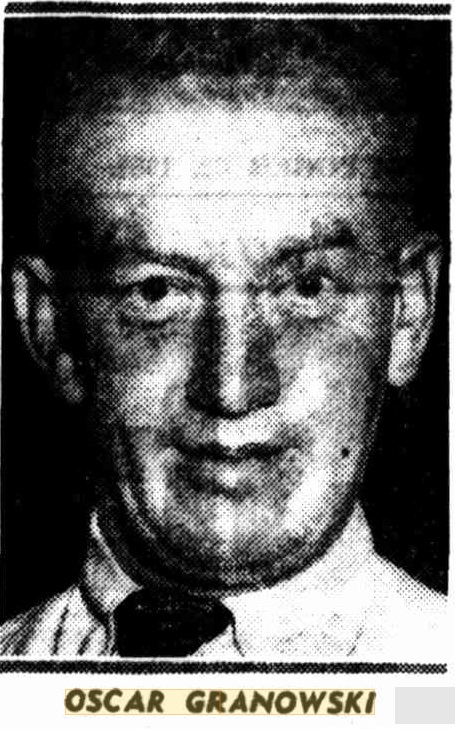
OSCAR GRANOWSKI
Poll scandal shows need for strict secrecy of ballot (1950, October 22). Truth (Sydney, NSW : 1894 - 1954), p. 2. Retrieved from http://nla.gov.au/nla.news-article167982485
Meanwhile, on the roads to Bayview, tenders to finally lay some gravel and tar were being called for:
Main Road N.o. 164 , (Pittwater Road), from William St., Brookvale, to Lismore Avenue, Deewhy, and from Hay St., Collaroy, to Narrabeen Bridge. (Approx. 27,000 sq. yds. of resurfacing). 2. Main Road No. 174 (Bay View Road), from Pittwater Road, Mona Vale, to Cabbage Tree Road, Bay View. (Approx. 7200 sq: yds.). 3. Main Road No. 162 (Gordon Road, from Pittwater Road. Mona Vale, to Samuel St. (Approx. 5300 sq.- yds.). —B.H.P. By-Products Pty. Ltd., £1,277/11/1 TENDERS CALLED (1941, April 23). Construction (Sydney, NSW : 1938 - 1954), p. 6. Retrieved from http://nla.gov.au/nla.news-article222860912
George Alfred Forsyth and wife Annie Isobel Forsyth from 1918
Mr. G. A. Forsyth.
Mr. George Alfred Forsyth, an ex resident of Penrith, died at Manly on Saturday last, at the age of 54 years. Deceased was a director and secretary of Alexander Forsyth and Co., .Ltd., the pioneer rope manufacturers of the State. He was the fourth son of Alexander Forsyth, the founder of the business. He lived in Penrith for some thing like 15 years, and resided at Kenilworth, Mt. Pleasant. He also had an irrigation farm at Emu Plains, which has since become the prison farm. Mr. Forsyth was well liked in the district, being of a very affable disposition. He left Penrith about eight years ago, and for some time had been residing at Bayview. He leaves a widow, but no children. Mr. G. A. Forsyth. (1923, August 18). Nepean Times (Penrith, NSW : 1882 - 1962), p. 4. Retrieved from http://nla.gov.au/nla.news-article104680522
His father wasn’t Alexander but Archibald: FORSYTH GEORGE A 15615/1923 ARCHIBALD SARAH MAN
OBITUARY
MR. G. A. FORSYTH.
The death occurred at Manly on Saturday of Mr. George Alfred Forsyth, who was director and secretary of Alexander Forsyth and Co., Ltd., the pioneer rope manufacturers in the State. Deceased was the fourth son of Alexander Forsyth, founder of the business, and was a well-known figure in commercial circles, in which he enjoyed much popularity. He resided at "Waiwera," Bayview, and was 54 years of age. The funeral took place yesterday at Long Bay cemetery, when Rev. W. J. Cakebread officiated. Those present at the graveside were: Mrs. Forsyth (widow), Mr. W. F. Forsyth (brother), Mr. F. A. Thorpe (brother-in-law), Mr. Colin Thorpe (nephew), Messrs. W. J., W. P., and J. M. Forsyth (cousins), Dr. Muckle, F. O. Orridge, W. Moore, de Stoffell, C. J. Saunders, F. Bean, E. C. Grant, P. Clune, Levi, E. H. Wagson, M. G. Webster, O. Kindopost. - Over 100 employees of the firm met the cortege at the cemetery gates and preceded the hearse in the procession. OBITUARY (1923, August 15). The Daily Telegraph (Sydney, NSW : 1883 - 1930), p. 10. Retrieved from http://nla.gov.au/nla.news-article246063182
NEW ROPE MAKING ESTABLISHMENT-
An important branch of industry has just been started at the Surry Hills, in the erection of buildings and machinery for the manufacture of rope A few months ago Mr. Archibald Forsyth secured about two acres and a half of land a little beyond the upper end of Bourke street upon which some substantial brick buildings and a von extensive rope walk have been put up. One of the buildings is 112 feet by 42 feet, and another 64 feet by 30 feet, the rope walk, which is enclosed with ironbark palings and roofed with Tasmanian timber, is 1056 feet in length , there is also an engine house, the chimney of which is 46 feet in height. At present only a part of the spinning machinery, which has been imported from New York is at work, the machinery for rope making, which has been sent out from Glasgow, is being fixed, and will be in operation in the course of a few days, the engine, which is of twenty-horse power, and the boiler, are the manufacture of Messrs P N Russell and Co. The raw material used for the manufacture is Manila hemp, a quantity of which is now going through the preliminary processes. Rope of the various sizes in general use will shortly be produced at this establishment, and Mr. Forsyth confidently expects to be able to compete in price with the importers of the article, in which case there can be little doubt that the orders for colonial rope will keep the factory busily employed, and that the enterprise will be successful. The Sydney Morning Herald. (1865, July 28). The Sydney Morning Herald (NSW : 1842 - 1954), p. 4. Retrieved from http://nla.gov.au/nla.news-article13116692
Annie Forsyth Wyatt was the eldest of eight children of George Trotter Evans, an English-born railway superintendent, and his second wife Isabella Anne, a daughter of Archibald Forsyth. Isabella Anne was born in 1857 in Victoria. Her father was the youngest son of a Scottish farmer, John Forsyth and he became a successful businessman through establishing a lumber yard for building products in Victoria and then moving to Sydney where he opened the first colonial rope factory in 1865 at a time when all rope was coming in on ships.
And as all ships needed rope the business thrived. Visit:
http://www.pittwateronlinenews.com/Annie-Wyatt-Reserve-Palm-Beach-History.php
Ethel Margaret Andrew, wife of William Peter Colvin Andrew, Gentleman, of Wahroonga and one of the founders of the Elanora golf course with the Playfairs.
William Peter Colvin Andrew of Sydney Company and Sir Sydney Snow of Sydney Knight as joint tenants –by February 23rd, 1937. They were the joint executors of the Will of Ethel Margaret Andrew, who passed away on November 17th, 1935.
Sydney Snow, born on December 17th 1887 at Ballarat, Victoria, was the third child of Melbourne-born John Snow, draper, and his English wife Emily Lark, née Piper. Ethel Margaret Andrew was his sister.
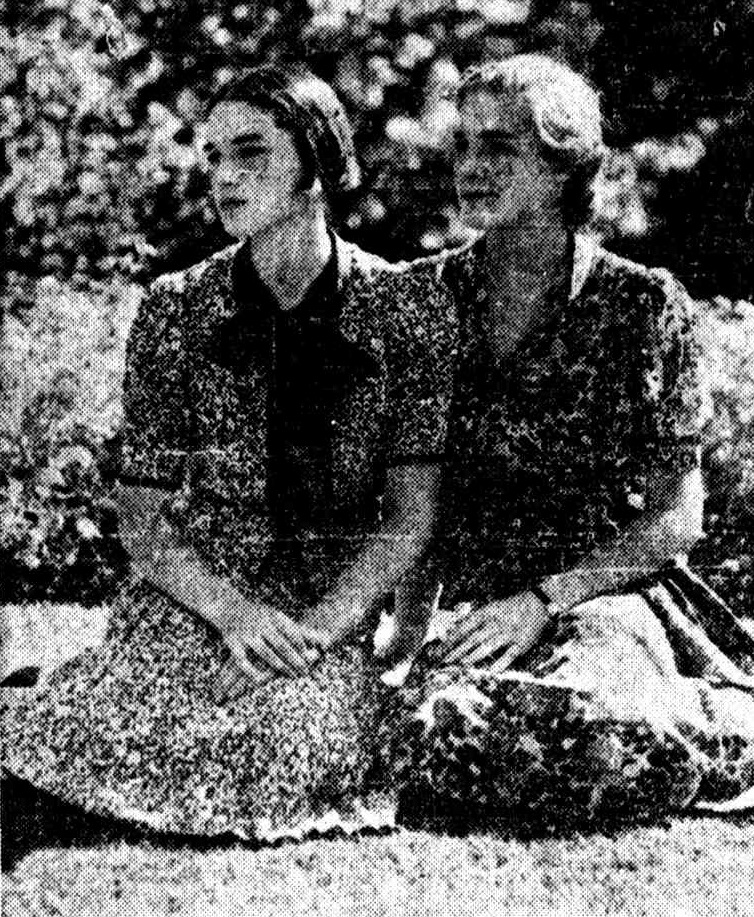
The daughters of Sir Sydney and Lady Snow, MISSES MARY (right) and BETTY SNOW, photographed in the garden of their home in Wahroonga. During the summer months much of their time is spent at their lovely cottage at Bayview. The Misses Snow will leave on March 23 in the Orcudcs, with their parents, for a trip to England. No title (1938, March 3). The Sun (Sydney, NSW : 1910 - 1954), p. 27 (LATE FINAL EXTRA). Retrieved from http://nla.gov.au/nla.news-article229868634
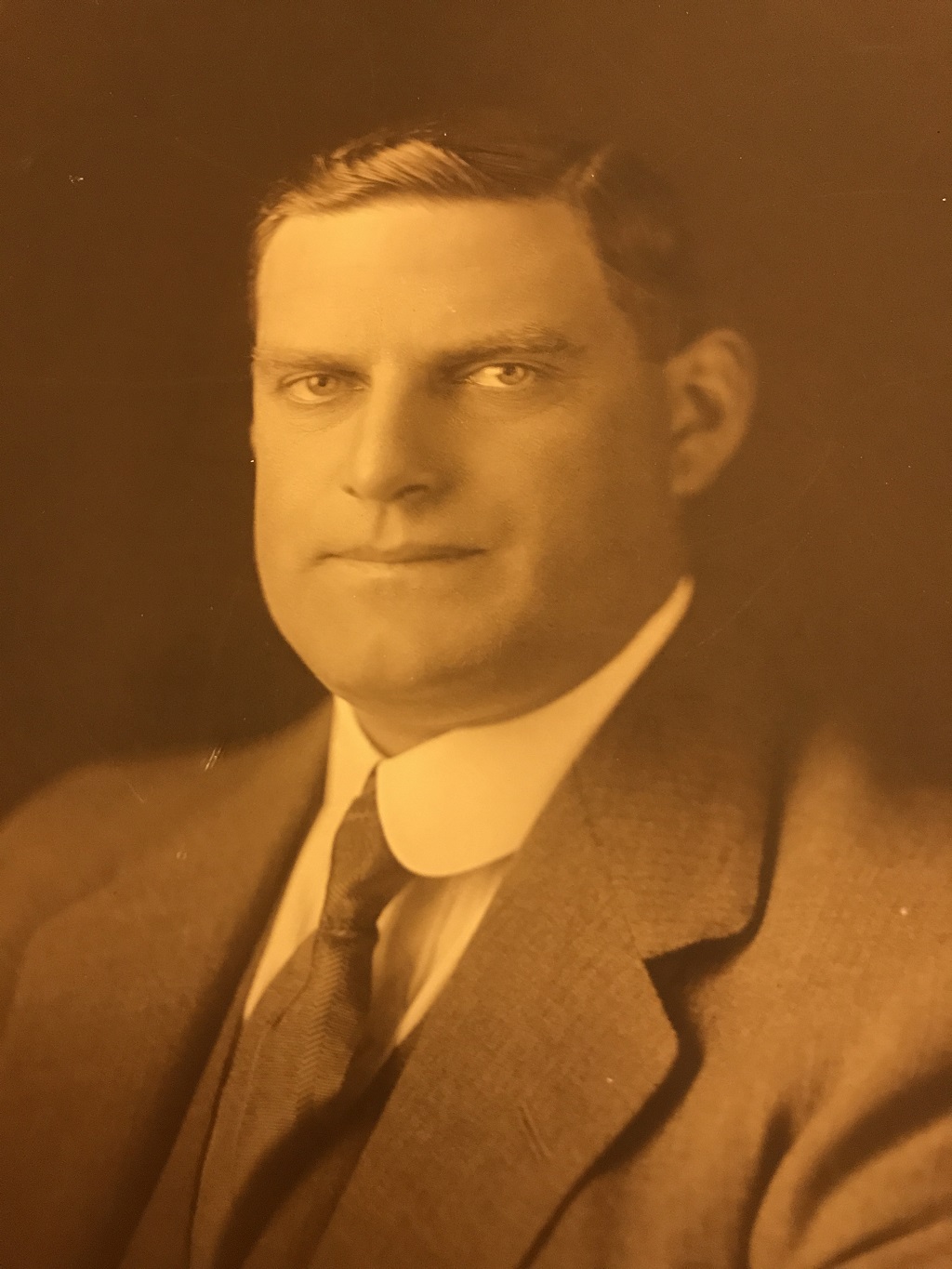
Sydney Snow - Family photograph
Barbara and Elizabeth Tink related the family history of urgent surgery in England (the operation was not performed here then) and a journey while very ill by boat to catch one of the first KLM planes operating from Asia to Europe.
Their mother Margaret:
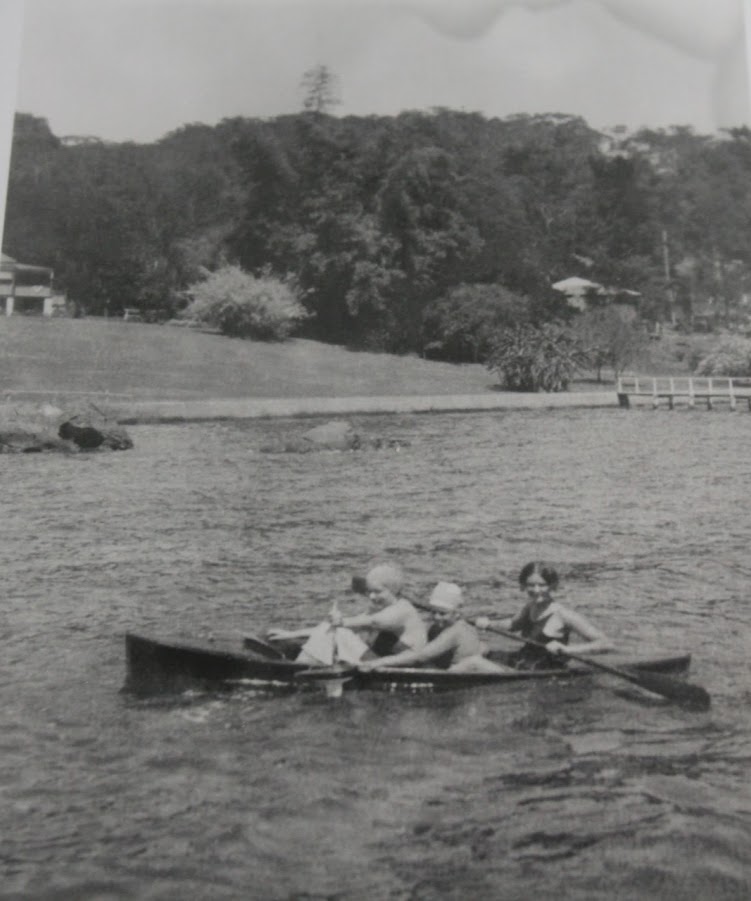
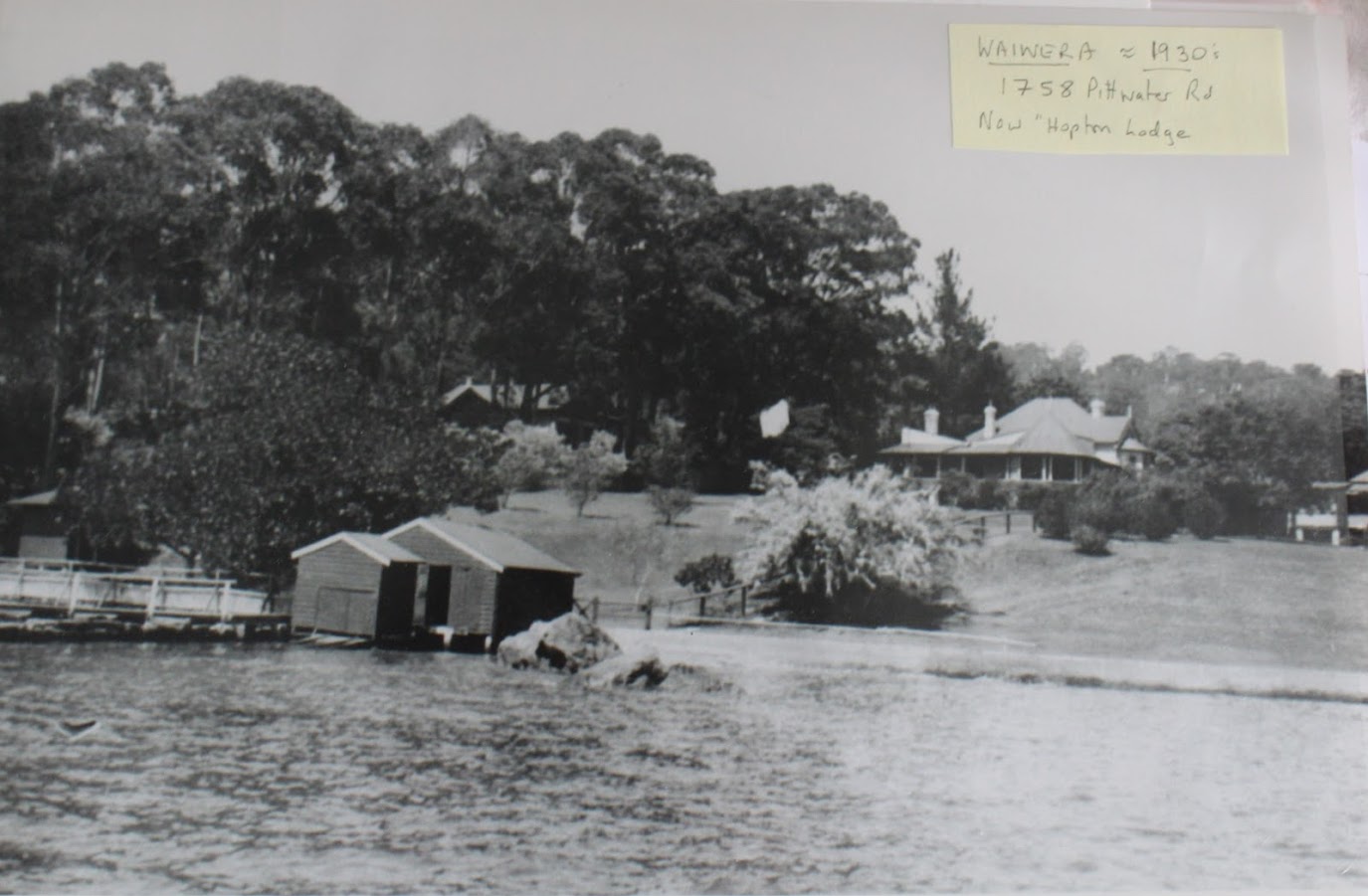
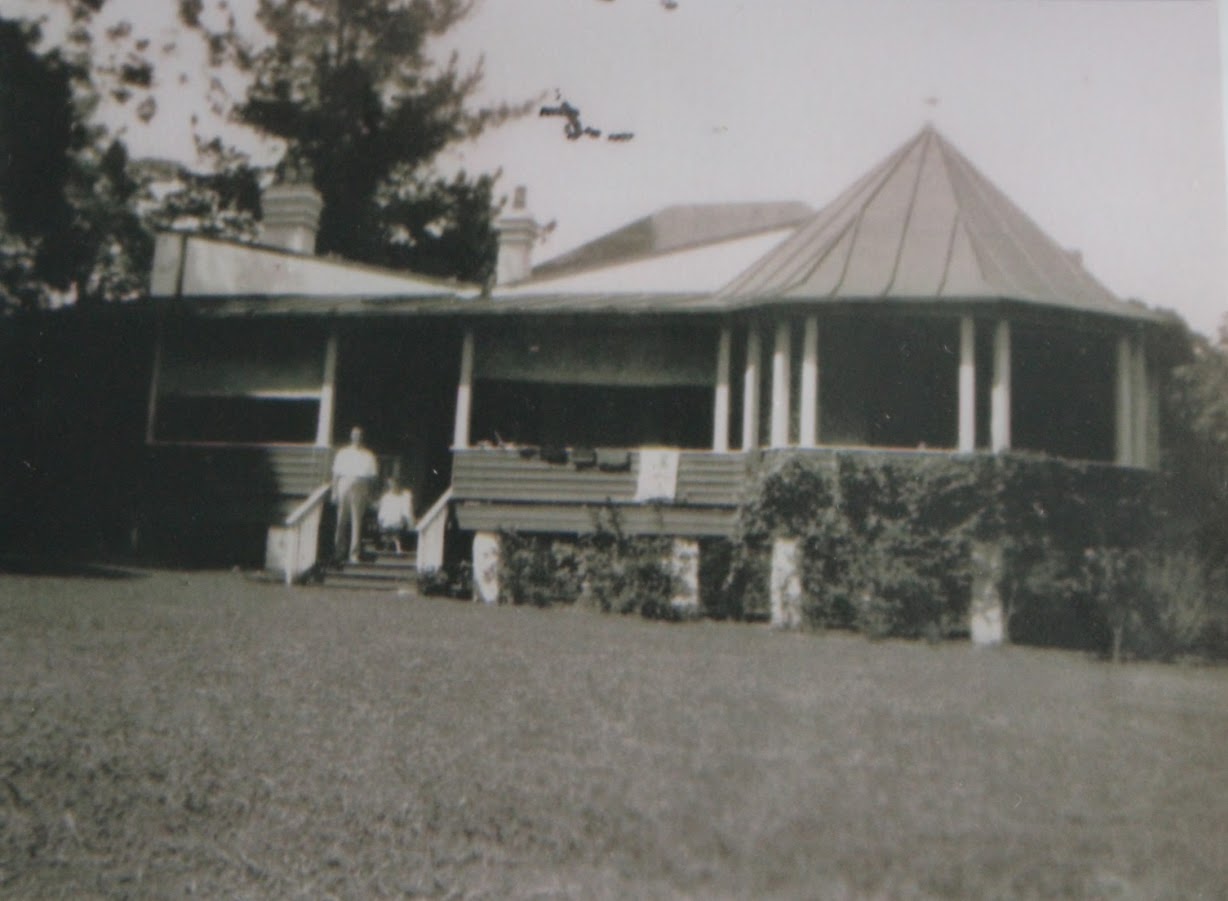
Doris Moore Northcott
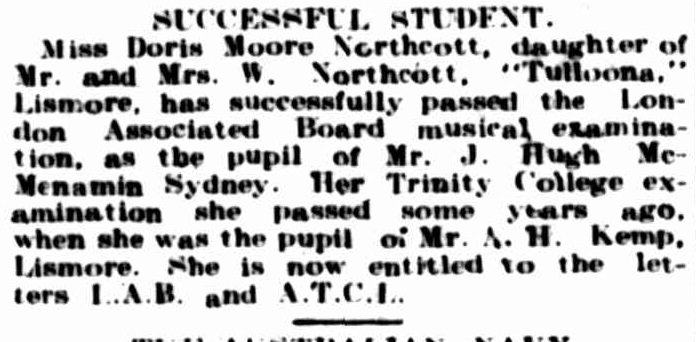
SUCCESSFUL STUDENT. (1911, September 16). Northern Star (Lismore, NSW : 1876 - 1954), p. 4. Retrieved from http://nla.gov.au/nla.news-article72432234
OBITUARY.
MR. WILLIAM NORTHCOTT.
The death occurred suddenly early yesterday morning at the Hotel Ryan, Lismore, of Mr. William Northcott, at the age of 66 years. He was, perhaps, one of the best known figures in Lismore and district, where he had acquired extensive interests in town and country property. As a youth he lived at Stroud, later going to Murrurundi, and afterwards residing at Quirindi, where he married, and for some time carried on a general store business. From Quirindi he came to Lismore, and was for many years engaged in the saddlery trade in Woodlark-street, and later in Moresworth-street in premises now occupied by Tanner and Son, which business deceased disposed of in 1902. Always, a keen business man, particularly in land matters, he turned his quickness of perception and speculative faculties to good account by consistently thorough methods, accumulating after an active life a goodly store of this world's goods. After leaving the saddlery business Mr. Northcott devoted his attention, almost exclusively to grazing until some three years ago, when he went to reside with his wife, and members of his family in Sydney. A week or ten days ago he returned to Lismore on a visit, to his friends, as well as for business reasons, and, as usual, made his home at the Hotel Ryan. At about 4.30 yesterday morning he awakened Mr. Jauncey, manager of the Commonwealth Bank, who occupied a near-by room, and asked him to call a doctor, at the same time complaining of feeling unwell. Dr. Shannessy attended the sufferer, but he grew worse, and died before 5 o'clock, death being due to heart failure. A widow, four daughters and two sons survive. The daughters are Mrs. Warby (Queensland) and Misses Linda, Annie, and Doris (Sydney) and the sons Messrs. Stanley (Inverell) and Carl (Lismore). The funeral will take place this afternoon, moving from the Methodist Church at 2.30, o 'clock for the new general cemetery. OBITUARY. (1917, May 16). Northern Star (Lismore, NSW : 1876 - 1954), p. 4. Retrieved from http://nla.gov.au/nla.news-article226494568
LATE MR. W. NORTHCOTT. The late Mr. William Northcott of Marubern-road, Mosman, died at Lismore on May 15 last Probate has been granted of his will, the estate being valued at £29,563, which was nearly all realty. The beneficiaries under the will are members of testator's family. LATE MR. W. NORTHCOTT. (1917, October 13). The Sydney Morning Herald (NSW : 1842 - 1954), p. 15. Retrieved from http://nla.gov.au/nla.news-article15757859
Paul Dowling
HOUSING AND TRANSPORT
Sir,-Mr. McGirr's statement (31/7/1945) on unoccupied houses at Palm Beach indicates an apathy on the part of some owners to the critical housing position, but the reason is mainly the appalling transport facilities to Palm Beach and adjoining districts.
If there was proper supervision of queues, reasonable terminal facilities, suitably appointed types of buses for long journeys, and the running of buses at times more suitable to the residents' requirements, most of these homes would be permanently occupied, and the housing position relieved to that extent.
As an Instance of the lack of transport for people permanently re-siding in this district, the Bayview - Church Point residents only have one direct bus to Wynyard, which leaves at 5.30 a.m., and when requests are made to the Transport Department for an additional direct bus to the city at a convenient time, the reply Is that It cannot be granted, owing to the omnibus and start position.
Surely some additional services can be made available for this and the adjacent districts by the diversion of omnibuses from areas with alternative means of transport. Until the trans-port position is remedied, houses will continue to be only occupied part time.
P. DOWLING.
Bayview.
HOUSING AND TRANSPORT (1945, August 6). The Sydney Morning Herald (NSW : 1842 - 1954), p. 5. Retrieved from http://nla.gov.au/nla.news-article17948749
OBITUARY. MR. JEROME DOWLING.
Mr. Jerome Dowling, whose death occurred on the 21st inst.', at his residence, 77 Liverpool-road, Dulwich Hill, aged 76 years, had not enjoyed good health for the past two years, and for two months prior to his death was a patient sufferer. Rev. Father R. Macken, C.M. (Provincial) attended him and administered the last Sacraments. A native of Cork, Ireland, he has been in Australia for about 52 years. Prior to coming here he was associated with the wool industry at home. Two of his brothers are members of the medical profession, Dr. Arthur Dowling, Haydock, St. Helens, England, and Dr. Frank Dowling, Bolton, England. Mr. J. Dowling was one of the best known men in Sydney sporting circles, being one of the founders of the Rosebery Racing Club, which later affiliated with the A.J.C. He was chairman of directors since the death of Mr. James Murtagh (about 12 years ago) and a representative on the Board of Management of Associated Clubs for some years. His son, Mr. J. B. Dowling, is now acting Chairman of Directors and also on the Board of Management of the A.J.C. Deceased was a staunch Catholic and noted for his generosity towards the poor, taking a keen interest in numerous charitable organisations. Lewisham Hospital and St. Vincent's Hospital have lost a life-long friend and supporter. Requiem Mass was celebrated at St. Vincent's Church, Ashfield, on Saturday morning by Rev. Father M. Hall C.M., following which the funeral left for Waverley Cemetery and was attended by some hundreds of mourners. The Very Rev. Father R. Macidn, C.M., officiated at the interment, which took place in the family grave. The chief mourners were Mrs. L. M. Dowling (widow), Messrs. J. B., F. E., Jack and Will Dowling (sons), Mesdames R. Maguire and H. H. Bingham (daughters), Mrs. J. B. Dowling (daughter-in-law), and Mr. H. H. Bingham (son-in-law), Eric, Alan and Joan Dowling (grandchildren), A. K. Kelaher (brother-in-law). Others present included representatives of Tattersall's Club, Messrs. W. W. Hill (chairman), S. E. Chatterton (treasurer), H. C. . Bartley, G. Chiene, B. Jolly, J. H. O'Dea, F. G. Underwood (members of committee) and T. T. Manning (secretary), Ex-Supt. John Roche (rep. Sir Joynton Smith), Rosebery Racing Co., reps. Geo. B. Murtagh, R. S. King, M. Gearln, F. Morris, J. Mooney, A. Hutohison, C. Fox, J. Thornton, H. Hamilton, V. Sutton, D. I-Ioarne, P. Nolan, also Messrs. G. G. Walton, T. Ringrose, Dr. Geo. Greenwell and Richard Greenwell, F. McGrath, senr., and F. McGrath, junr. ,M. Tuffey, W. Dalley, A. T. Pittar, Alban Geo (Chairman, Kensington Club), H. Samuel, M. J. Buchanan, A. E. Grounds, Guy Lawson Dr Jaclt Gearln, W. P. Donohoe (secretary Victoria Park Club). John Underbill (secretary, A.J.C.), Tom Kingsley (Owners and Trainers' Association), J. Samuols, I. Rossi, J. 0. Glenn, E. D. Clarice, W. C. Aldritt, T. Little, J. N. Slioosmlth, Mrs. C. A. Cross and -daughter, T. Hannan (Moorefield Club), Jan .Barium (N.S.W. Trotting Club), I-I. Jonlciiifi (secretary, Kensington and Roseberry Clubs), Dr. J. G. Bell.Allen, Davo I-Ioarno, .lini Murtough (chairman, Ascot Club), IQ. L. Johnson, D. Brennan, J. C!oylo, J. Howorth, H. Donnolly, Alf Miller, Jan. McLood, J. Rufinoll, T. McIIugh, Mrs. Bingham, P. O'Loary (secretary, City Tatt.'s Club), Mr. Ralph Sillar, W. Graham Davidson, Paul Dowling (managing director, N.S.W. Bookstall Co. Ltd.), … OBITUARY. (1937, January 28). Catholic Freeman's Journal (Sydney, NSW : 1932 - 1942), p. 21. Retrieved from http://nla.gov.au/nla.news-article146401891
Paul Dowling sold November 29th, 1945 to his relative, Brendan Dowling who sold to Roy McCaughey in 1954.
The front, street facing facade of Waiwera cottage in 2019


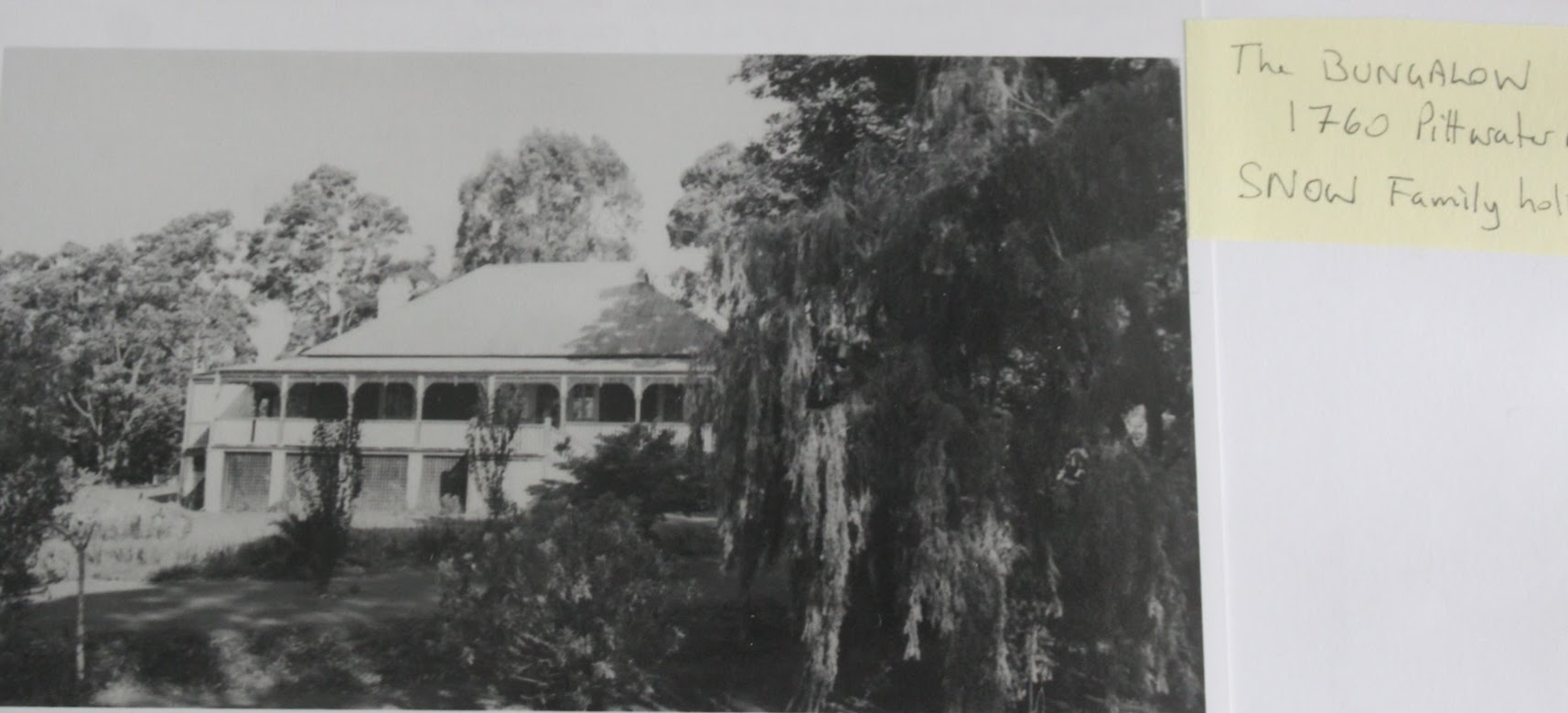
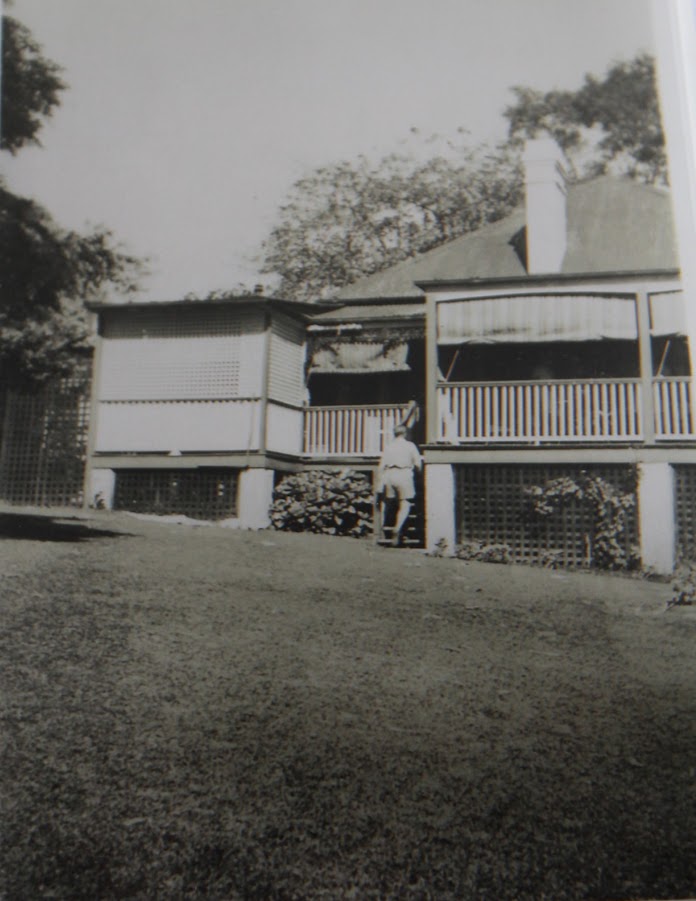
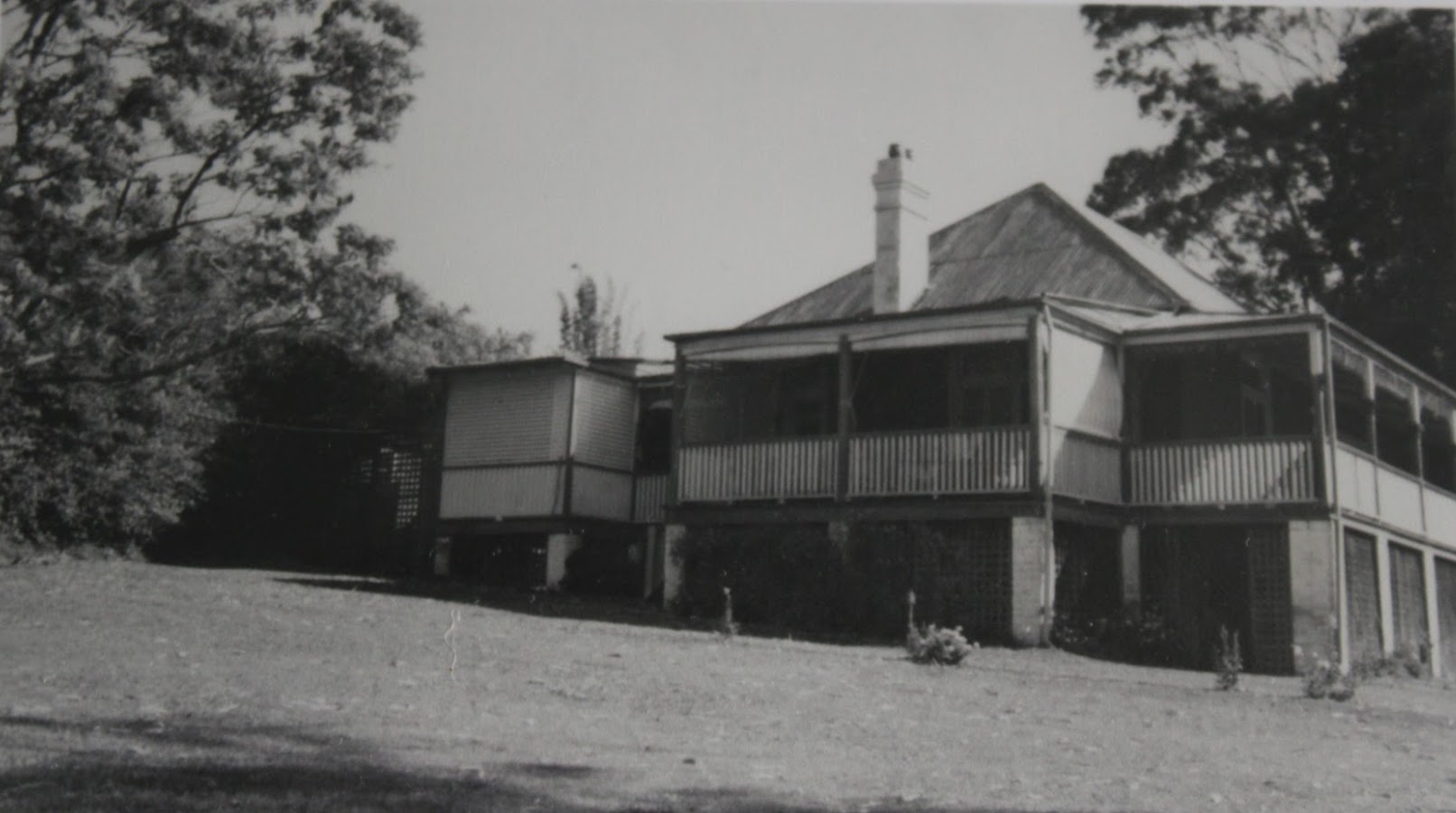
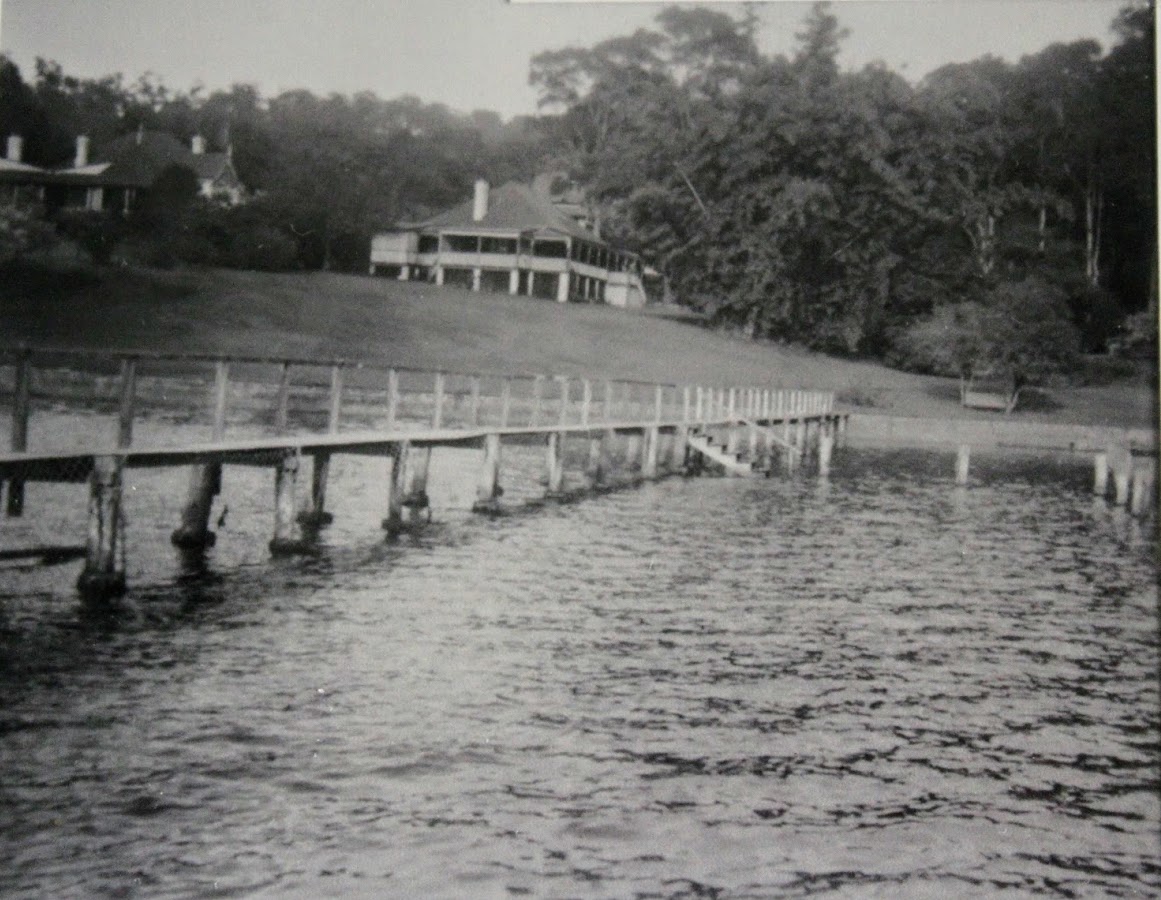
The 'Hopton Lodge' Decades: Owners And Insights
The name Hopton was brought to England in the great wave of migration following the Norman Conquest of 1066. The name is derived from the Old English words "hop" + "tun" and literally means "farmstead in a small enclosed valley or enclosed plot of land."Lodge definition: A lodge is a house or hut in the country or in the mountains where people stay on holiday.
In 1954, when the Roy McCaughey's bought Waiwera, Australia had a new queen and was in between the old world and the new. Those who had lost much during WWII, including a husband of just months in Gweldoline Patricia Camille McCaughey (born Phelan, North Hunt born 1904) during the Fall of Singapore, were part of what is called 'the Service Generation' - their sacrifices during that conflict led to a focus on building up a nation depleted in resources and in people in order to win peace.
They also wanted to re-establish good things for all and this meant embracing new ideas and ways to help others as well as doing this through the methods and observing the genteel customs they had been trained in while growing to adulthood and in time to be sent to war - how could they do anything other than what they had been taught to do, especially in a time when the Cold War was beginning.
Gweldoline Patricia Camille McCaughey, 'Patricia', was among those who just escaped from Singapore as the bombs of Japanese invasion were falling. She had married a widower, Harold North-Hunt, born 1894 in Leicester, Leicestershire, on February 14th, 1941. He was taken prisoner by the Japanese and sent to Changi PoW Camp. He died at Middleton Hospital Singapore on May 20th 1942 of Coronary Sclerosis. His wife did not find out about his passing until Notice officially arrived.
A few insights from the local papers of that situation for those who fled:
MALAYAN WOMEN "GET TOGETHER"
News From Far East Shared
More than 150 members of the Malayan Women’s Association met yesterday at a “get together” tea-party held at David Jones, George Street. Among them were Mrs. Pat North-Hunt, of Singapore, and Mrs. G. Thamsan, of Ipoh, who were evacuated from Singapore to the Netherlands East Indies on February 1. They were anxiously questioned by many of the women in the hope that, they may have had recent news of those left in Malaya.
One of the happiest women present was Mrs. Grieve, of Singapore, who received a cable from her husband on Monday announcing that he had been safely evacuated from Singapore.
The fate of husbands who were last known to be fighting in Singapore was the general topic of conversation and the women were able to compare notes with each other.
Several men from Malaya also attended the party, for which the chairwoman was Mrs L. A. Thomas. Among the guests of honour was Mrs. Hubert Fairfax, State secretary of the Country Women's Association. MALAYAN WOMEN "GET TOGETHER" (1942, February 25). The Sydney Morning Herald (NSW : 1842 - 1954), p. 6. Retrieved from http://nla.gov.au/nla.news-article17789586
What 'Pat' did while waiting for news of her husband was do what she could for others:
LIFE OF SYDNEY
From Malaya
MRS. L. E. WHITE, of Sungei Kusial, Kelantan, Malaya, has arrived in Sydney with her small son after being evacuated from Singapore to Ceylon. She is the guest of her mother, Mrs. F. Elder, at Northbridge. No word had yet been received of Mr. White, who remained in Singapore.
* * *
From Singapore
A BEAUTIFUL seventeen-piece set of dinner mats of fine embroidered linen was sold by lucky number competition at the Air Training Corps after noon held at Prince's yesterday. The dinner mats were brought to Australia by Mrs. G. P. C. North-Hunt, one of the hostesses at yesterday's party, when she escaped from Singapore six weeks ago. Mrs. North-Hunt is the wife of Registrar-General of Statistics and Director of Supply of the Straits Settlements and the Federated Malay States. Mr. North-Hunt remained in Singapore. Yesterday's party was to raise funds to provide equipment for the Air Training Corps. LIFE OF SYDNEY (1942, April 18). The Daily Telegraph (Sydney, NSW : 1931 - 1954), p. 7. Retrieved from http://nla.gov.au/nla.news-article247922883
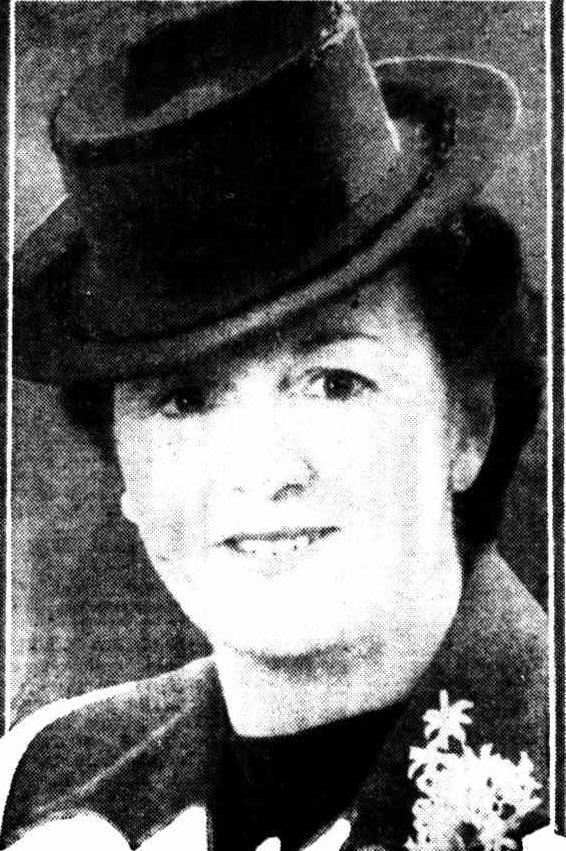
Mrs. North-Hunt, formerly of Singapore, has settled in a flat here at Dorchester House. — Dorothy Welding. The Jottings OF A LADY ABOUT TOWN (1942, July 5). Truth (Sydney, NSW : 1894 - 1954), p. 29. Retrieved from http://nla.gov.au/nla.news-article168967245
SURE to be one of the most popular lucky number competitions on Red Cross Day, on June 18, is the lovely satin embroidered with silver thread, which has been donated by Mrs. North-Hunt, of Singapore. She bought the material for a Court gown before the war, and it was one of the treasures she brought to Australia when she escaped just before the Japs occupied Singapore. The competition has been named the "bride's competition," and the material would be a boon to any bride-to-be for her wedding gown. Women's News (1943, June 6). The Daily Telegraph (Sydney, NSW : 1931 - 1954), p. 22. Retrieved from http://nla.gov.au/nla.news-article247876548
For Women
All Ready For Red Cross Day
FOUR hundred and fifty thousand badges, ranging in value from 6d to £1, have been prepared for sale tomorrow. Red Cross Dav. Already the as and 2s varieties have been sold out. Lady Walder, who is organising the fair, to be held In Martin-place from 9 am to 5 pm. promises many surprises for housewives in groceries and household ware. Freshly-cut sandwiches will be available to lunch-buyers, nnd have been made possible by gifts of butter from Lady Gowrie Lady Walder. Mrs. Penfold Hyland, and Mrs. r. Hill. In spite of shortages of eggs and butter, the cake stall, under Lady Morshead, promises about 700 cakes. Mrs. W. P. Minell will have 500 pots of home-made Jam to offer at her counter; Lady Gowrie, who has given a large fruit cake for disposal, will pay an informal visit to the fair during the day. Attractive prizes include a roll of hand-made embossed satin, presented by Mrs. North Hunt, formerly of Singapore. Donations totalling £3400 are already in hand, and the proceeds 'are expected to be a record. Some of the Interesting contributions to the Old and New Stall will be displayed at a late cocktail party at the Australia Hotel this afternoon. Goods made by soldier patients at the 113th AGH have been presented to the Red Cross, and will be Sold by them at a special stall. Thirty wounded soldiers will demonstrate the making of the articles.
MISS HELEN PARK, who has been Director of the American Red Cross Service Club since it opened last November, has been transferred to another area, where she will open a new club. Yesterday, the new director, Mr. A. M. CANORA, who recently arrived from America, took over duties at the club. Here they are photographed at the party,' which the canteen captains and the club staff, gave to Miss Park. For Women (1943, June 17). The Sun (Sydney, NSW : 1910 - 1954), p. 5 (LATE FINAL EXTRA). Retrieved from http://nla.gov.au/nla.news-article231722289
Towards the end of 1943, Patricia found out that her husband had died in Changi:
NORTH-HUNT - At Changi Singapore, Harold, Malayan Civil Service husband of Patricia, Sydney. By notification from Singapore dated November 1 1942 received by Colonial Office London. Family Notices (1943, November 2). The Sydney Morning Herald (NSW : 1842 - 1954), p. 10. Retrieved from http://nla.gov.au/nla.news-article17873597
The following year:
WEDDINGS
McCAUGHEY-HUNT The marriage was quietly celebrated in Sydney yesterday of Mr D. R. McCaughey, of Coonong, Narrandera, NSW, to Mrs P. (Pat) North Hunt, formerly of Singapore. WEDDINGS (1944, March 29). The Argus (Melbourne, Vic. : 1848 - 1957), p. 8. Retrieved from http://nla.gov.au/nla.news-article11820828
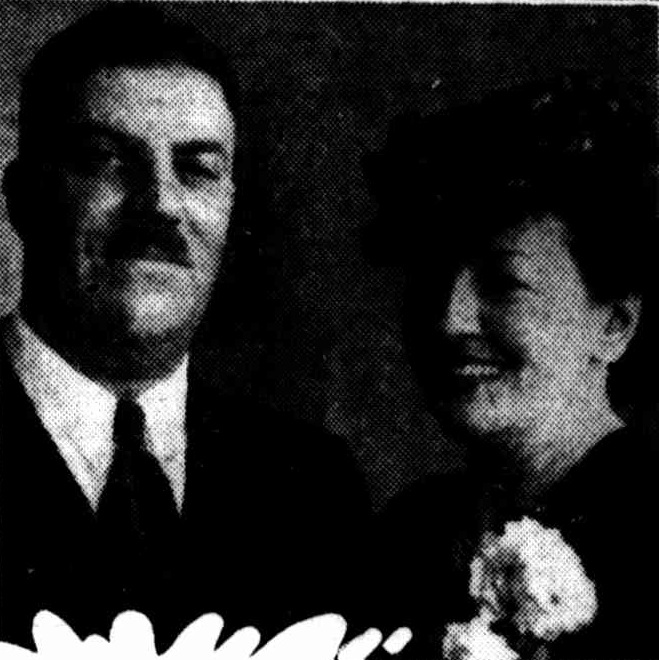
Mr. and Mrs. Roy McCaughey, of 'Coonong,' Narrandera, just after their marriage in Sydney last Tuesday. The bridegroom is the owner of the famous cattle stud, and the bride was formerly Mrs. North Hunt, of Singapore. Women and War Work (1944, April 2). Truth (Sydney, NSW : 1894 - 1954), p. 24. Retrieved from http://nla.gov.au/nla.news-article168761717
Smiths, the journal that made so much $ out of spying on Palm Beach people during the 1930’s and publishing their photographs and antics through its own personal ‘mein’, with more than a touch of acidic jealousy, clearly missed the above image (or wanted one of their own) but adds at least one reason why the Bayview property was attractive to Mr. McCaughey - fishing!
What should be known prior to perusing this little ‘piece’ is Mr. McCaughey was a fiercely private gentleman - According to an old friend, he 'never had a cross word for anyone, but he wouldn't stand any nonsense. The men at Coonong all thought the world of him'. Survived by his wife, he died on 13 September 1971 at St Vincent's Hospital, Sydney, and was cremated. His estate was sworn for probate at more than $1 million. He bequeathed $500 to each man in his employ. [2.]: 2. G. P. Walsh, 'McCaughey, Sir David Roy (1898–1971)', Australian Dictionary of Biography, National Centre of Biography, Australian National University, http://adb.anu.edu.au/biography/mccaughey-sir-david-roy-11407/text19379,
DAVID ROY McCAUGHEY TOPS THE MARKET
CITY people can have quite a wrong idea of the country-man, especially the big romantic-looking cattle- man.
They picture him as the personification of courage, a man who thinks nothing of leading a bull, an immense fierce - looking fire - breathing beast, round a ring at the show, or paddocks out west. Yet is he so courageous when It comes to the test? There is David Roy McCaughey for example, sheep-man, cattleman, big man. He stands about six-feet-one in his socks, broad-shouldered, a well-proportioned, almost a classic example of the Australian country man. He can handle a prize bull better than a toreador. But does that take courage? Seemingly not, if David Roy McCaughey is to be taken as criterion. There is a station out from Jerilderie, NSW. It is called Coree and was owned by David McCaughey, brother of the late Sir Sam McCaughey. In October, 1898 David was presented with a son, christened David Roy who, after growing up, attending Geelong Grammar School and working on Coree, enlisted in the AIF, went to England, was transferred to the Royal Field Artillery, and was training in camp at Exeter when the Armistice arrived. Back in Australia he continued on the land, and about 1924 started Coonong station, about fifty miles south of Narrandera, NSW, with a dozen cows and a bull.
A few years later he made his first importation — one bull and three female beasts. That bull was a Scottish product, Millhills Rosicrucian, David Roy McCaughey paid 4000 guineas for him. He had already, in 1924, paid a record price for a five-and- a-half years old prize ram from the Austin Wanganella stud. The price was 5000 guineas. Admittedly David Roy McCaughey had courage enough to join the AIF, and to pay top prices for good stock. But what of his courage when it comes to a final test? At Sydney Cattle Sales just concluded his Beef Shorthorn bulls dominated proceedings, a fact of importance when it is a national duty to contribute in every way possible to beef production. At those sales, held at Commonwealth Wool and Produce Co. Pyrmont saleyards, David Roy McCaughey established two records. He paid E. L. Killen, of Pine Park, 1700 guineas for the senior champion bull, Coonong Kiltie, which he had himself bred and which he had sold to Killen stud in 1942 for 500 guineas. He also topped sales with Coonong Napoleon, junior champion. which he sold to C P Fairbairn and Co. of Woomargama, for 2000 guineas, highest figure ever paid in Australia for a bull of this breed Another bull, Coonong Marshall, was sold to John Taylor, of Turanville, for 1750 guineas. Altogether Coonong offerings totalled £6121/10/- for eight animals. This fine stud, which originated at Coonong and still bears that name, is today located at Borambola Park, Wagga, a property which also belongs to David Roy McCaughey He resides at Coonong, which today he reserves for stud merinos.
About a month ago David Roy McCaughey was married to Mrs. North-Hunt, widow of the late Harold North- Hunt, who had been Registrar-General of Straits Settlements and Federated Malay States, who, at outbreak of the war, was appointed Director-General of Supply, and whose death occurred in camp at Singapore shortly after the surrender.
In the days before manpower shortage, David Roy McCaughey used to indulge in deep-sea fishing as sport, Narooma, on South Coast, NSW, being his favorite centre. Today his sole relaxation from cattle and sheep-raising is a monthly visit to Sydney, by aeroplane when possible, to attend board meetings of the Commonwealth Wool and Produce Co Ltd. of which he is a director. Altogether, as one of our cattle-kings, David Roy McCaughey makes quite a brave show. But what of his courage, when it comes to a genuine test? He may be game to face a massive Shorthorn bull and handle it as though it were a kitten. But apparently he is not game to face a photographer. TOPS THE MARKET (1944, May 13). Smith's Weekly (Sydney, NSW : 1919 - 1950), p. 11. Retrieved from http://nla.gov.au/nla.news-article235766760
After their marriage there are numerous photographs of the couple that appear for decades - none in 'Smith's though. Those informal images of him appearing in saleyards and at Royal Easter Shows are overtaken by the many events his wife organises as fundraisers for various causes or as a part of a 'society' she may have been a part of in Singapore before World War Two.
In all of these images he looks delighted, as does his wife!
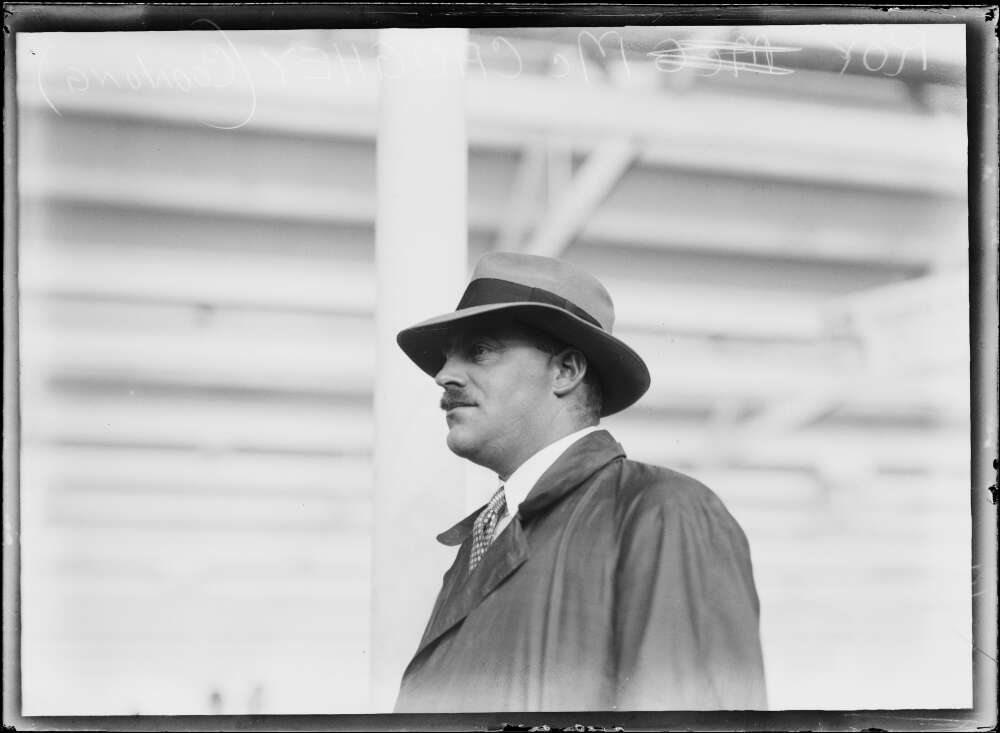
Fishwick, Herbert H & Fairfax Corporation. (1930). Sheep breeder of Coonong station Mr Roy McCaughey, New South Wales, ca. 1930s Retrieved from http://nla.gov.au/nla.obj-162879959
MR. and Mrs. ROY McCAUGHEY gave a cocktail party last night at their flat in Onslow Gardens to show their friends a portrait of Mrs. McCaughey painted by the Australian artist Lyall Trindall. The portrait will hang in the hall of their home, Coonong, Narrandera, which was built in 1878 for Sir Samuel McCaughey, an uncle of the present owner. Mr. and Mrs. McCaughey came to Sydney for the cattle show and have won several prices with their stock. They intend to remain for the ram sales this month. TWO SERVICE WEDDINGS YESTERDAY (1945, May 1). The Sydney Morning Herald (NSW : 1842 - 1954), p. 6. Retrieved from http://nla.gov.au/nla.news-article17934911
Artist and Subject
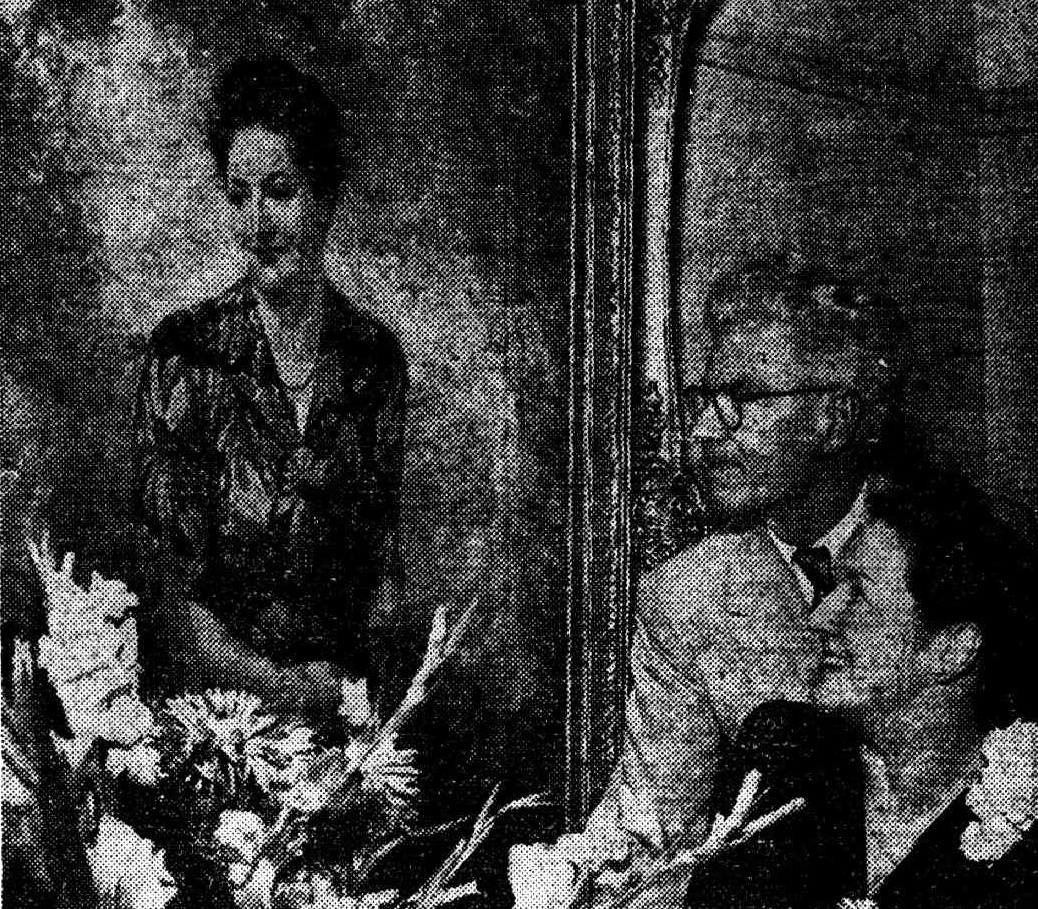
ADMIRING PORTRAIT. With artist Lyall Trindall, Mrs. Roy McCaughey supervises hanging of her portrait, which he painted in her Elizabeth Bay flat. Portrait will eventually hang in Mr. and Mrs. McCaughey 's historic station home at Narrandera. Artist & Subject (1945, May 6). The Daily Telegraph (Sydney, NSW : 1931 - 1954), p. 30. Retrieved from http://nla.gov.au/nla.news-article248009123
The above Artists would later take the McCaughey's to court to sue for payment for a larger payment. The dispute, which was widely covered in newspapers, was judged in the Artists' favour eventually and the portrait, which he had exhibited in the Archibald prize of 1951, had a price of 700 guineas.
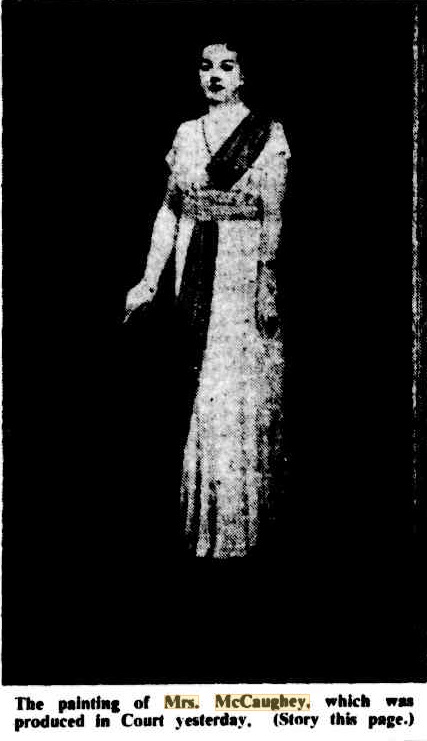
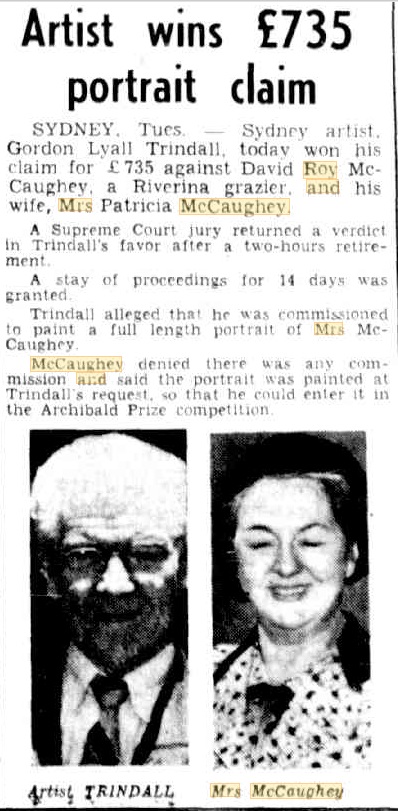
December 1952
NEXT April Mr. and Mrs. Roy McCaughey will sail in the Marella for Malaya, where they will spend three months. Caught sight of them lunching at Prince's a few days ago. Roundabout (1948, February 22). Truth (Sydney, NSW : 1894 - 1954), p. 26. Retrieved from http://nla.gov.au/nla.news-article169380105
Buffet Dinner Party For 250 Guests
"MOST of New South Wales' cattle breeders in town for the Royal Show were among the 250 guests entertained by Mr. and Mrs. Roy McCaughey, of Coonong, Narrandera, at a buffet dinner at Prince's last night.
The restaurant was taken over to hold the private party from 8 p.m. onwards. Schnapper and turkey in aspic, chicken, oysters, roast beef, French salads and spaghetti were served from a large buffet. The party celebrated Mrs. McCaughey's birthday. She wore a lovely pale blue draped dinner gown with diamond clips at the corners of the square neckline and added four rows of pearls. Melbourne visitors among the guests were the host's niece, Mrs. Clive Clark, and Mrs. Trevor Clark. Well-known blind cattle expert, Mr. J. Scrymgeour, of Queensland, was accompanied by his wife and daughter. Mrs. Doug Munro wore a ballerina dress of black crepe and fastened a pearl brooch across the square neckline. Lady McMaster chose a hydrangea blue crepe dress with silver kid leaves on the sleeves and belt, and Miss Thelma McMaster was in a red dinner frock printed in a white leaf design.
Smart In Black
Mrs. Lennox Bode, Mrs. Henry Charles Osborne, Mrs. Strath Playfair, and Mrs. Colin Sinclair all wore black gowns. Mrs. Bruce Walker wore a lovely ivory satin dress sewn with large colored stars and a quilted coat. Miss Margaret Hughes chose a tailored pink cloque gown. Mrs. John Brunton wore a draped blue silk printed in a vivid floral design, and her daughter, Diana, was in a white organza dress with fine shoulder straps. Mrs. Mrs. Otway Falkiner wore a spray of roses with her midnight blue chiffon dress. Also among the guests were the Minister for France and Madame Auge, Mr. and Mrs. Wallace Horsley, Mr. and Mrs Lach Horsley, Mr. and Mrs. Bob Simson, Mr. and Mrs. Charles Moses, Mr. and Mrs. Ernest Turnbull, Mr. and Mrs. Norman Hill.
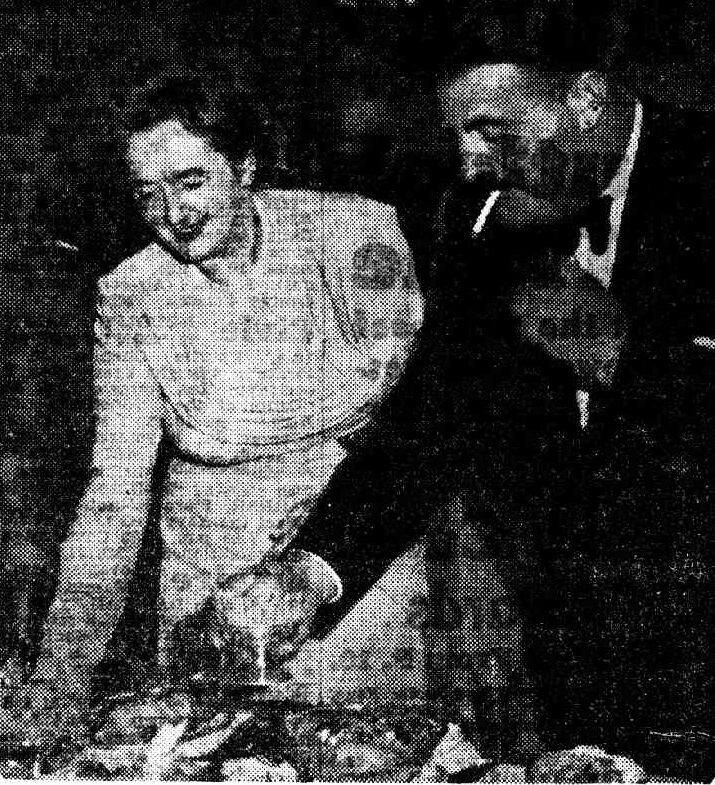
EASTER PARTY: Mr. and Mrs. Roy McCaughey. of Coonong at the dinner they gave for 250 guests at Prince's last night. WOMEN'S NEWS (1948, March 23). The Daily Telegraph (Sydney, NSW : 1931 - 1954), p. 12. Retrieved from http://nla.gov.au/nla.news-article248180421
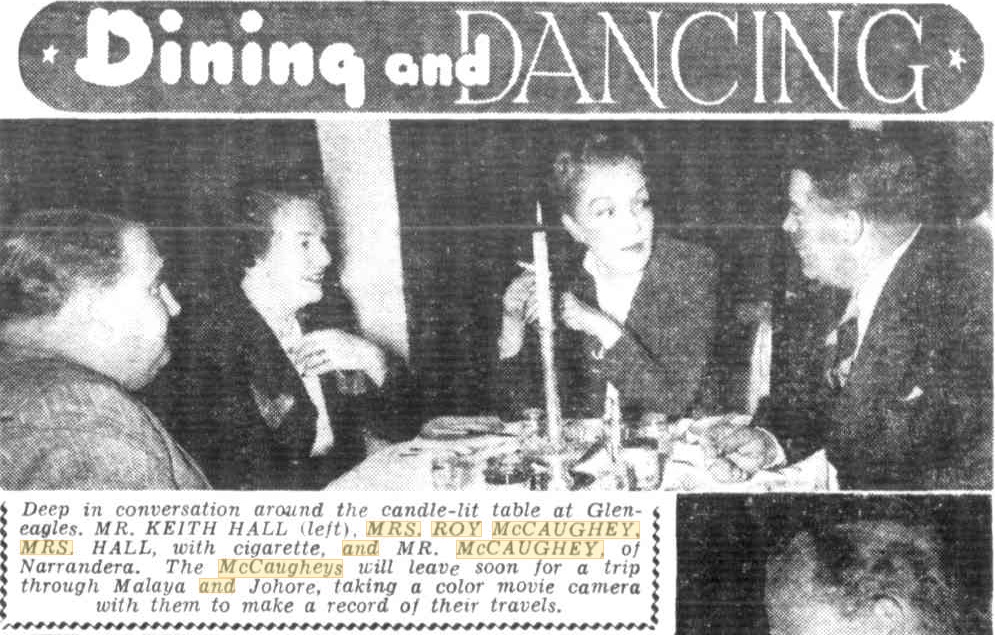
April 18, 1948
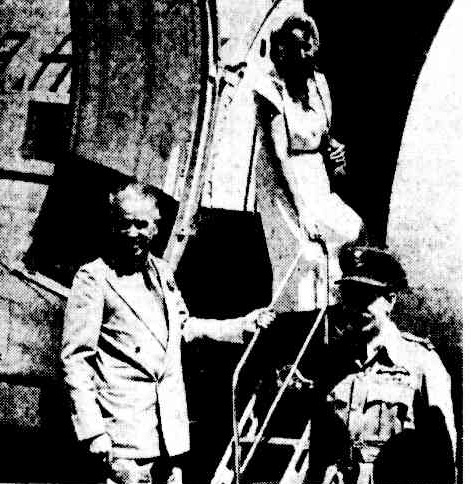
THE Commander-in-Chief, Far East Air Forces, AIR MARSHAL SIR HUGH LLOYD, and LADY LLOYD, With FLIGHT LIEUT. W. FISHER, captain of the R.A.A.F. plane which flew them to Narrandera yesterday morning. Sir Hugh and Lady Lloyd, who arrived from Singapore last week-end, will spend a few days with Mr. and Mrs. Roy McCaughey, who motored to their home, Coonong, on Monday to await their-guests. Sir Hugh and Lady Lloyd will return to Sydney by air to-morrow. WOMEN'S NEWS And FEATURES (1949, December 22). The Sydney Morning Herald (NSW : 1842 - 1954), p. 7. Retrieved from http://nla.gov.au/nla.news-article18144125
The flat in town becomes a mansion on the Harbour:
MYRIAD fairy lights, open-air supper tables, oyster and champagne bars, and strolling musicians were features of two lavish private parties held last night in two of Sydney's most beautiful old homes — Tokay, at Bellevue Hill, and Yarranabbe House, Darling Point.
Mr. and Mrs. Roy McCaughey gave a house-warming party at their Darling Point home for more than 200 guests. Mr. and Mrs. Graham Pratten gave a young people's dance for their only daughter, Jill, at Mr. George Falkiner's home, Tokay, Victoria Road, for 250 guests. Special traffic police directed the stream of cars bringing guests to Mr. and Mrs. Mc-Caughey's party. Fairy lights illuminated the lovely grounds and swimming pool. The hosts moved into their three-storied home only three months ago and for last night's party transformed the lower floor into a bar which opened on to the garden. They have furnished the house with antiques bought in England last year. Black chiffon Mrs. McCaughey wore a black chiffon frock trimmed at the neckline with chantilly lace. She carried a scarf of flame-colored chiffon. Among the first guests to arrive were Dr. and Mrs. Hugh Poate. Mrs. Poate wore a mid-night-blue chiffon frock embroidered and beaded with sequins. Mr. and Mrs. Charles Lloyd Jones also arrived early, Mrs. Lloyd Jones in black lace over pink.
The Consul-General for the United States (Mr. Orsen Nielsen) and Mrs. Nielsen, Lieutenant-General P. H. Berryman and Mrs. Berryman, and Air Vice-Marshal and Mrs. J. Mc-Cauley were among the guests.
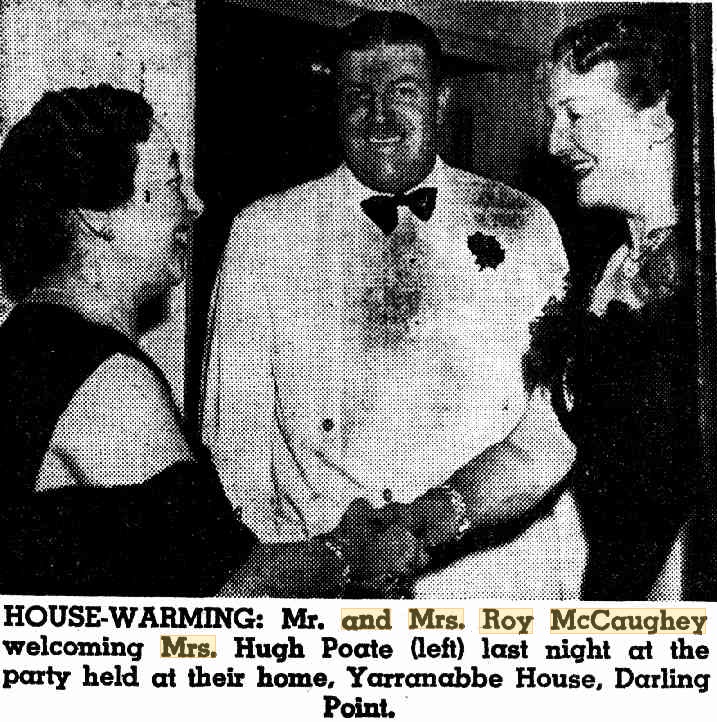
HOUSE-WARMING: Mr. and Mrs. Roy McCaughey welcoming Mrs. Hugh Poate (left) last night at the party held at their home, Yarranabbe House, Darling Point WOMEN'S NEWS (1950, February 25). The Daily Telegraph (Sydney, NSW : 1931 - 1954), p. 25. Retrieved from http://nla.gov.au/nla.news-article248994049
With 200 guests you're going to need some help!
ENGLISH visitors Mr. and Mrs. Walter Hill and their daughter, Vivien, saw Sydney Harbor at its best last night when they were guests at a barbecue which Mr. and Mrs. Roy McCaughey gave in the grounds of their Darling Point home. Mr. and Mrs. Hill and Vivien, who came to Australia in Orion, will continue to Canada in Aorangi on Thursday. Guests included Mr. and Mrs. Douglas Pell and their daughter Angela who have entertained the Hills during their Sydney stay. Sandra's WEEKEND, DIARY (1950, March 26). The Daily Telegraph (Sydney, NSW : 1931 - 1954), p. 46. Retrieved from http://nla.gov.au/nla.news-article248686714
AT the end of last week Mrs. Roy McCaughey gave a party. Oh, it was nothing for the social columns . . . nothing to make hostesses, green with envy. She was entertaining 235 old people . . . guests at the Little Sisters of the Poor Home for Aged and Infirm, Randwick, at a slap-up Jubilee Party with eats, treats, entertainment, and pressies."
One morning about a month ago Mrs. Roy phoned me. "Jubilee, jubilee! Everyone's gone mad on having a whale of a time ... making 1951 a year to end all years," she said. Out of this fragmentary phrase came the idea of passing on some of her blessings to those less blessed, and so the party as arranged. And think of this! a carload of famous stars . . . caring little whether their gesture makes news or not ... are coming to give a show to Randwick's old folk. Their kindness will be a song to remember. News for Women (1951, March 7). The Daily Telegraph (Sydney, NSW : 1931 - 1954), p. 14. Retrieved from http://nla.gov.au/nla.news-article248639103
Hopton Lodge at Bayview was, of course, one of the venues that hosted their fundraisers:
VOTE of thanks should go to the committee arranging "A Night Under the Stars" on February 23-they thoughtfully printed directions on the entree cards. The party will be held at the Bayview home of Mr. and Mrs. Roy McCaughey and the proceeds of the evening will aid Dr. Barnardo's Homes. SOCIAL JOTTINGS (1957, February 20). The Australian Women's Weekly (1933 - 1982), p. 29. Retrieved from http://nla.gov.au/nla.news-article46931471
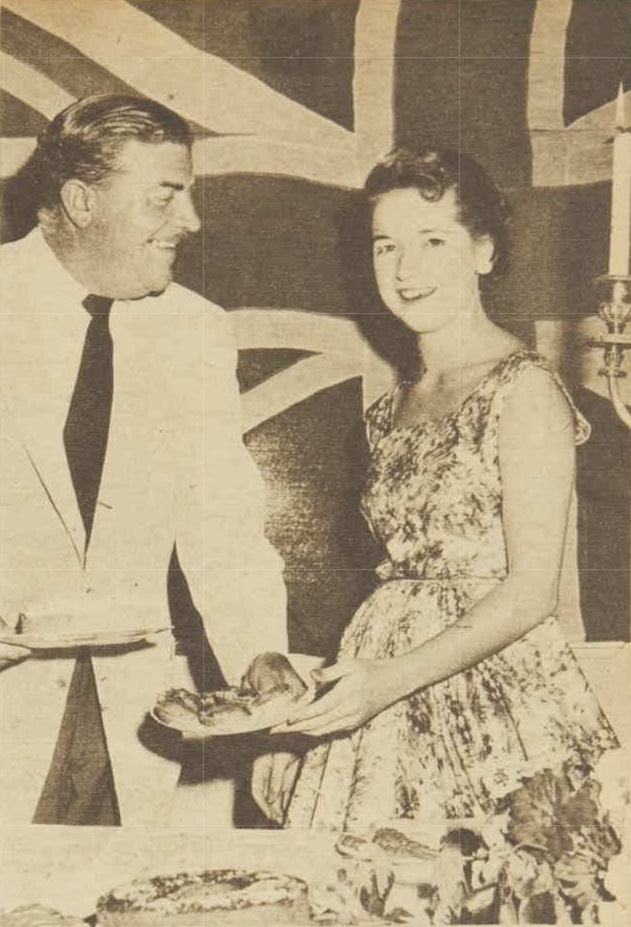
BAYVIEW PARTY. Mr. Roy McCaughey serves supper to Wendy Jackett, who was one of the guests at the "Night Under the Stars" held at Mr. and Mrs. McCaughey'swaterfront home at Bayview. More than 250 guests attended the party, which was in aid of Dr. Barnardo's Home. SOCIAL JOTTINGS (1957, March 6). The Australian Women's Weekly (1933 - 1982), p. 33. Retrieved from http://nla.gov.au/nla.news-article46931761
.jpg?timestamp=1557015467699)
DECORATIVE CORNER in the lovely garden of Mr. and Mrs. Roy McCaughey's home at Bayview, N.S.W. The fishpond it surrounded by pots filled with cacti and hydrangeas, and the wrought-iron holder contains brilliantly colored calceolarias, azaleas.
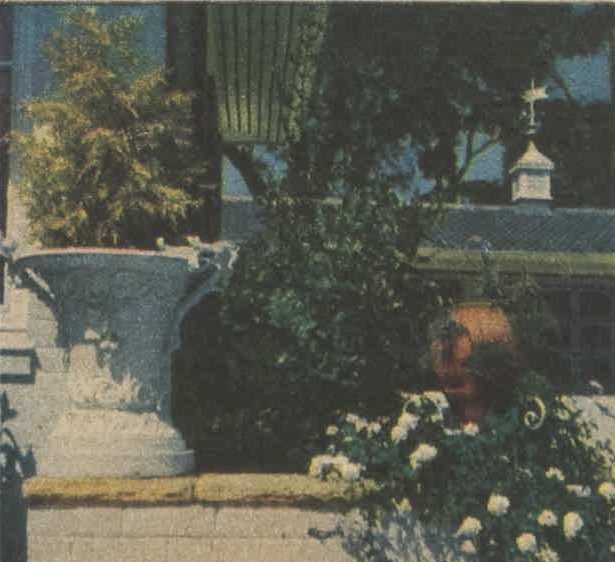
CLASSIC URN (left) filled with golden dwarf cypress add* to the beauty of the steps at Mr. and Mrs. Roy McCaughey's home at Bayview, N.S.W. Spill-over* of pale lilac verbena add to the color. Pot-plants for color (1957, November 20). The Australian Women's Weekly (1933 - 1982), p. 56. Retrieved from http://nla.gov.au/nla.news-article48207963
"I FELT quite homesick when I saw our front door," was Mrs. Roy McCaughey's nostalgic comment in a letter from London after seeing our recent color page featuring the entrance to the McCaugheys' lovely home at Bayview. Mr. and Mrs. McCaughey are due to reach Canada this week in the Empress of Britain, and will go on to San Francisco to board the Mariposa for Sydney. SOCIAL ROUND ABOUT (1960, August 3). The Australian Women's Weekly (1933 - 1982), p. 52. Retrieved from http://nla.gov.au/nla.news-article51194597
The other aspect of the McCaughey's at Hopton Lodge, Bayview, is the persistent wondering whether H.R.H. Princess Elizabeth and the Duke of Edinburgh dined here in the late 1950’s. Later on Princess Diana and Charles would leave from Bayview wharf for a cruise on Pittwater. They had been preceded by Second Royal Visitors to Australia - Princes Albert and George, who came here in 1883 for a visit, boarding a steamer at Newport Wharf for a tour along the Hawkesbury River.
The McCaughey's had been scheduled to host the royal couple on the tour that was cancelled when the Queen's father passed away and subsequently went to the coronation of Her Majesty:
Station hoists prepare for Royal guests
Elizabeth and Philip will relax in beautiful old Riverina homestead
By JOYCE BOWDEN
One of the four private homes in which Princess Elizabeth and the Duke of Edinburgh will stay in Australia is "Coonong," N.S.W., the home of Mr. and Mrs. Roy McCaughey.
The Royal visit will revive the splendor of past hospitality at "Coonong" where, at the turn of the century, its previous owner, the late Sir Samuel McCaughey, often entertained important overseas visitors.
AMONG the plans which Mr. and Mrs. McCaughey will suggest for the Royal visitors' I entertainment will be a bush picnic, complete with billy tea.
Irish born Mrs. McCaughey has lived in Australia for 10 years, but she told me that the bush picnic had never lost its novelty and appeal for her. She is sure that anyone coming from overseas would enjoy it as much as she does.
"My husband and I want to make the Royal couple's stay with us as restful and as happy as possible so that they can relax from their arduous official duties," Mrs. McCaughey told me.
No other guests have been invited to "Coonong" during the Royal visit there.
Princess Elizabeth and her husband will be able to see whatever they wish of the surrounding country and the various features of life on a sheep nation.
"I hope they'll be interested in seeing the whole performance of shearing from the sheci iack to the wool bale," said Mr McCaughey.
There will be a full moon on one of the nights the Royal party will be at "Coonong."
Moonlit lake
"ITS gardens and lake look lovely by moonlight, so I’m delighted," said Mrs. Mc Caughey.
"Very often when we go out on to the plains we see brolgas, or native companions.
I’m hoping they won't be shy at the sight of Royalty, and that Princess Elizabeth will be able to see the birds in their natural setting and 'dancing' their ballets. They are really more graceful than any prima ballerina."
The visit to "Coonong" will give Princess Elizabeth and the Prince an opportunity of seeing Riverina merino country.
The old homestead will remain unaltered for the Royal visit but Mrs. McCaughey is redecorating the suite which Princess Elizabeth and her husband will occupy.
The suite will comprise two bedrooms, one of which will be a dressing-room for the Duke, a private sitting-room, sun Porch, and bathroom.
Keeping in mind Princess Elizabeth's taste for pastels, Mrs. McCaughey has chosen a delicate pearl-green for the walls. The French lacquered furniture will be in the same shade, and so will the padded bedhead which is to be appliqued with white glazed chintz lilies. The bedspread will match the bedhead and will have a border of the white lilies.
The curtains will be in pearl-green silk damask and the chaise longue will be buttoned in orchid-pink. Princess Elizabeth's dressing table will be draped with the same material as the curtains and will have a mirror top. The bed-lamps will have white velvet shades lined with orchid-pink. Lustre lamp bases on the dressing-table will be fitted with white velvet shades lined with the palest orchid-pink.
The built-in wardrobe will be lined with orchid-pink georgette, and the dressing table drawers will be lined with sachets in the same shade. The carpet in the bedroom will be just off-white. Over the white marble fireplace will be an old mirror with a gold leaf frame which has been at "Coonong" since the house was built in 1877.
Crystal brackets will be on either side of the mirror. The bathroom will be cream with pale peach plastic curtains. Pearl-green walls will be used also for the Duke's dressing-room. The carpet there will be off-white. The curtains will have a cinnamon and oyster-green regency stripe. This will tone with two period wing chairs upholstered in dull antique copper-peach satin. Lamp bases will be limegreen and bronze with pale yellow shades.
The sitting-room walls will be the palest yellow. A lime green carpet will cover the floor and the curtains are to be lime-green spotted silk.
The settee is to be covered in olive-green floral glazed chintz which has a design of cameos of deer and a border of pale yellow and copper-peach flowers.
The romantic story of Samuel McCaughey, who came to Australia to make his name and fortune far away from his Irish homeland, will no doubt interest Elizabeth and Philip.
In 1856, at the age of 21, Samuel, uncle of Mr. Roy McCaughey, came from Ballymena, in the North of Ireland, where he had a small property. With two partners he purchased "Coonong," Narrandera, which was then a cattle property. He turned it into a sheep property and later bought out his partners.
Samuel was financed by an uncle, Sir Samuel Wilson, who had come from Ireland and had properties in Victoria.
Samuel's brothers John and David came out to Australia from Ireland after the death of their mother. David was Mr. Roy McCaughey's father. There were also eight sisters at home in Ireland, but only one of them, Mrs. Chesney, migrated to Australia.
Later Samuel bought "Singorimba," "Goolgumble," "Coree," and "Yarrabee," all in the Riverina.
When these stations were running successfully Samuel went to the Darling, where he purchased "Dunlop," "Tooralie," and later "Nocholcche."
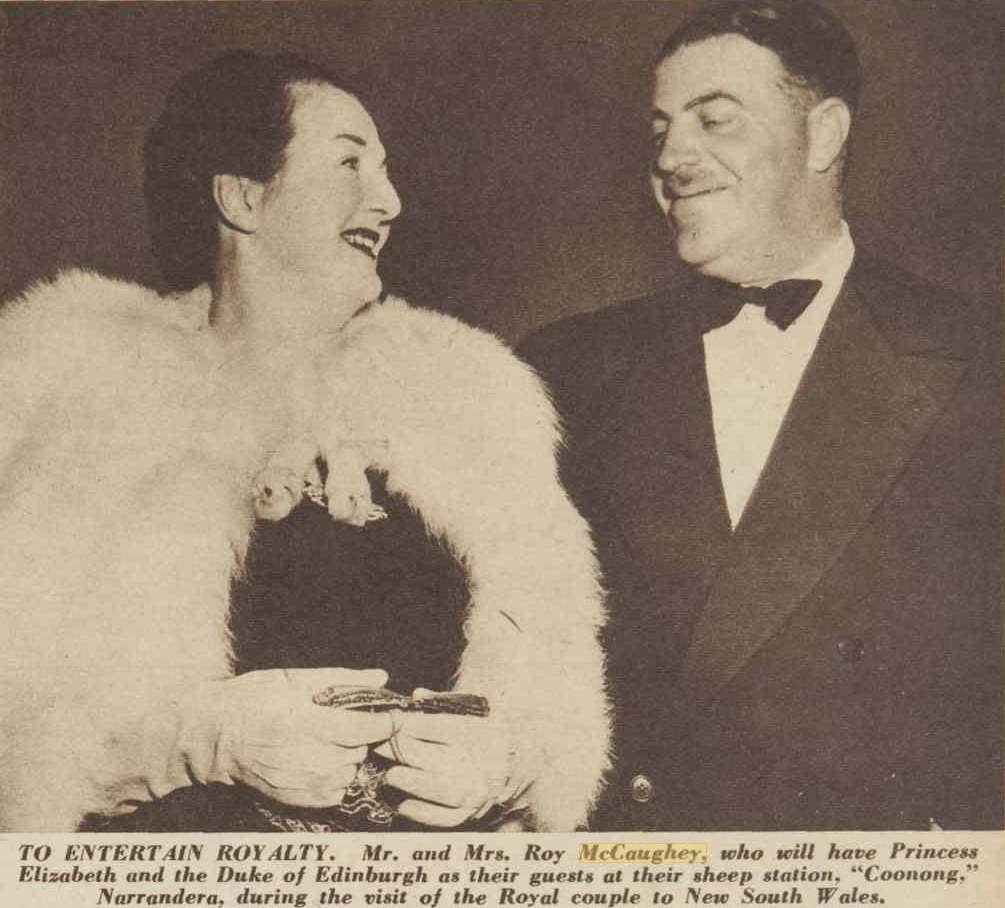
TO ENTERTAIN ROYALTY. Mr. and Mrs. Roy McCaughey, who will have Princess Elizabeth and the Duke of Edinburgh as their guests at their sheep station. "Coonong." Narrandera, during the visit of the Royal couple to New South Wales.
There were three million acres in these three properties alone, and in a good season a quarter of a million sheep were shorn.
In their early days David and John looked after the Darling interests. When Samuel sold out of these properties David took over "Coree," where Mr. Roy McCaughey was born, and John took up "Yarrabee."
Mr. McCaughey's father bought "Coree," Jerilderie, in the middle of the eighties. He married Blanche Gell, daughter of the Hon. Hoskins Gell, of Tasmania.
Huge bequests
SAMUEL, who was knighted in June, 1905, for his philanthropy, remained a bachelor. There were four children, two girls and two boys, in the David McCaughey family; Mr. Samuel McCaughey, named after his uncle, who has now retired; Mr. Roy McCaughey; Mrs. Tom Grantham, of Victoria; and Mrs. Ted Dermer, of Melbourne.
Mr. John McCaughey, who died in the mid-1920's, was twice married. His daughter, Miss Mona McCaughey, lives in Melbourne. His second wife lives in Sydney.
Sir Samuel, who died in July, 1919, was a staunch Presbyterian. He left part of his huge fortune to the Presbyterian Church. Among the many other beneficiaries were Sydney and Queensland Universities, the Burnside Homes, and Scots College. He also left sufficient money to educate 28,000 children of deceased and incapacitated servicemen of World War I. Seven of these children later became Rhodes Scholars.
One of the first irrigation schemes in New South Wales was established on one of Sir Samuel's properties, North Yanco, and the town of Leeton was built on part of it. Now Leeton is one of the biggest fruit and vegetable canning centres in Australian Leeton is also the largest rice-producing area in the Commonwealth. The former homestead has become the North Yanco High School.
In 1942 a charming Irish woman came to Australia from Singapore as an evacuee. She was Mrs. H. North Hunt, who before her marriage was Patricia Phelan, daughter of the late Mr. and Mrs. Walter Phelan, of Cork and Kilkenny.
A few months after her arrival here she and Mr. Roy McCaughey, then a bachelor, were introduced by mutual friends. At that time Mrs. North Hunt had not heard the fate of her husband, whom she had had to leave behind in Singapore.
"I received news at the beginning of 1944 that my husband had been killed, and I decided to return to England to make my home there," said Mrs. McCaughey. "It never occurred to me to think of marriage.
"I was discussing my plans for my return to England at a dinner-party one night and afterwards Roy suggested I remain in Australia and marry him," she added.
They were married on March 28, 1944.
"I think I must have been attracted to the Irish in him," said Mrs. McCaughey with a twinkle in her Irish blue eyes when she told me the story of their romance.
"When I think of Princess Elizabeth and Prince Philip coming to 'Coonong' I think of the first time I went there. I had never travelled such a distance over the Australian countryside before. I was amazed at the great expanse of empty plains and the 'oasis' of the old homestead when we reached it."
Mr. McCaughey bought "Coonong" in June, 1919, on his return from England after World War I.
"Coonong" shears 20,000 merino sheep, all of which are studs.
However, most of the time he and his wife live at another of their properties, Boramboli Park, Wagga.
Here Mrs. McCaughey has her famous Borambola Stud of Scottish beef Shorthorns. My hubsand and I are rivals, but friendly ones, as I have to depend on him for pasture lands!" she said.
.jpg?timestamp=1557017130912)
PRINCESS ELIZARETH and her husband will relax at thin beautiful old homestead, "Coonong," Narrandera, during their visit to New South Wales. Here they will have every opportunity of seeing alt phases of life on a big sheep station. Station hosts prepare for Royal guests (1952, February 13). The Australian Women's Weekly (1933 - 1982), p. 17. Retrieved from http://nla.gov.au/nla.news-article44552612
Australian Book For Queen
A presentation copy of Lady Harrison's book, "Me, Too," will be flown to London for presentation to .Her Majesty, Queen Elizabeth, next week. It is in ivory vellum with the title inscribed in gold lettering.
Special copies are also being prepared for the Governor-General, Sir William Slim, the Prime Minister, Mr. R. G. Menzies, and Mr. D. R. McCaughey, who guaranteed the cost of the second edition.
The book, which, is Lady Harrison's personal account of the Royal Tour, is in the second edition, the first being sold out. It proved very popular in London-the first 100 copies on sale at Australia House being sold in a week. All proceeds from the sale of the books in each State of the Commonwealth will raise funds for crippled children.
The second edition is on sale at all booksellers and at the head office of the N.S.W. Society for Crippled Children, 13 Chalmers' Street, Sydney, at 15/-. Australian Book For Queen (1956, March 10). The Canberra Times (ACT : 1926 - 1995), p. 2. Retrieved from http://nla.gov.au/nla.news-article138120517
MR. AND MRS. ROY McCAUGHEY shared the celebration of their ninth wedding anniversary with their three wins-for short-horn cattle-at the R.A.S., when they attended the Short-horn Society's buffet dinner at the Pickwick Club last night. Mr. and Mrs. McCaughey will leave in the Orion on April 11 for London to attend the coronation; during their absence Miss Lorna Lippman, of Potts Point, will be hostess at their home Coonong, Narrandera. Social News And Gossip (1953, March 29). The Sunday Herald (Sydney, NSW : 1949 - 1953), p. 22. Retrieved from http://nla.gov.au/nla.news-article18503779
From A Special Correspondent in London
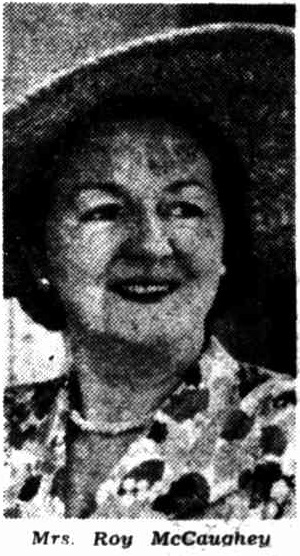 THE Queen has invited Mr. and Mrs. Roy McCaughey, of Narrandera and Darling Point, N.S.W., to a completely private Buckingham Palace reception on June 12 at which the Queen and the Duke of Edinburgh plan to entertain personal friends all over the world. The function is one of the very few non-official non-State parties given by the Queen over the Coronation period and the only private Royal party with an- international yet. non-political flavour. When as Princess Elizabeth she planned to tour Australia early last year, the Queen intended to break her heavy New South Wales programme by a quiet three-day rest visit with the Mc-Caugheys, on their Narrandera property. Mrs. McCaughey will wear to the reception, which will be held at night, a magnificent floor-length gown in chalk-white peau de sole cut on princess lines and embroidered all over with a flower design worked in silver beads. The bustle-like back has a huge stiffened bow across the hips. Australians to be Queen's private guests (1953, May 28). Brisbane Telegraph (Qld. : 1948 - 1954), p. 18 (CITY FINAL). Retrieved from http://nla.gov.au/nla.news-article217137351
THE Queen has invited Mr. and Mrs. Roy McCaughey, of Narrandera and Darling Point, N.S.W., to a completely private Buckingham Palace reception on June 12 at which the Queen and the Duke of Edinburgh plan to entertain personal friends all over the world. The function is one of the very few non-official non-State parties given by the Queen over the Coronation period and the only private Royal party with an- international yet. non-political flavour. When as Princess Elizabeth she planned to tour Australia early last year, the Queen intended to break her heavy New South Wales programme by a quiet three-day rest visit with the Mc-Caugheys, on their Narrandera property. Mrs. McCaughey will wear to the reception, which will be held at night, a magnificent floor-length gown in chalk-white peau de sole cut on princess lines and embroidered all over with a flower design worked in silver beads. The bustle-like back has a huge stiffened bow across the hips. Australians to be Queen's private guests (1953, May 28). Brisbane Telegraph (Qld. : 1948 - 1954), p. 18 (CITY FINAL). Retrieved from http://nla.gov.au/nla.news-article217137351
Queen invites NSW. couple to private party
From Hazel Fully
LONDON, Thursday.— The Queen has invited Mr. and Mrs. Roy McCaughey, of Narrandera and Darling Point, to a completely private : Buckingham Palate reception on June 12 where she and the Duke of Edinburgh plan to entertain personal friends from, all over the world' '"
This will be one of the very few non-official, non-State parties given by the Queen during the Coronation period and the only private Royal party with an 'international yet non-political flavor .'
When as Princess Elizabeth she planned a 'tour of Australia for early last year, the Queen intended to break her heavy NSW program with a quiet three-day rest-visit with the McCaughey 's on their lovely Narrandera property, Coonoong.
Mrs. McCaughey will wear to the reception, which will be held at night, a magnificent floor-length' gown' in chalk white peau de sole cut on princess lines and embroidered all over with a flower, design. in silver beads.. . 5
The bustle-like ' back has a huge stiffened, bow across the hips. The gown is worn with a tiara, long White gloves, matching bracelet, necklace and earrings in sapphires and diamonds ..
Queen invites N.S.W. couple to private party (1953, May 28). The Sun (Sydney, NSW : 1910 - 1954), p. 37 (LATE FINAL EXTRA). Retrieved from http://nla.gov.au/nla.news-article231045445
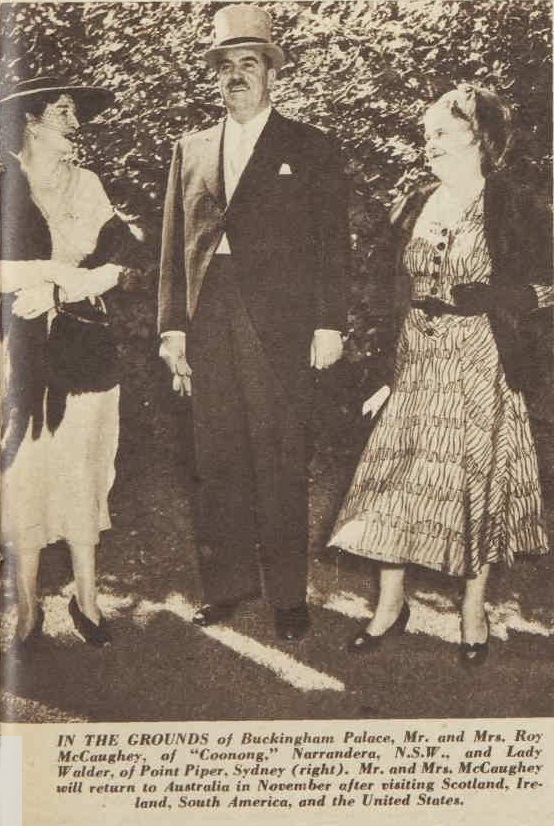
June 1953 - Australian Women's Weekly
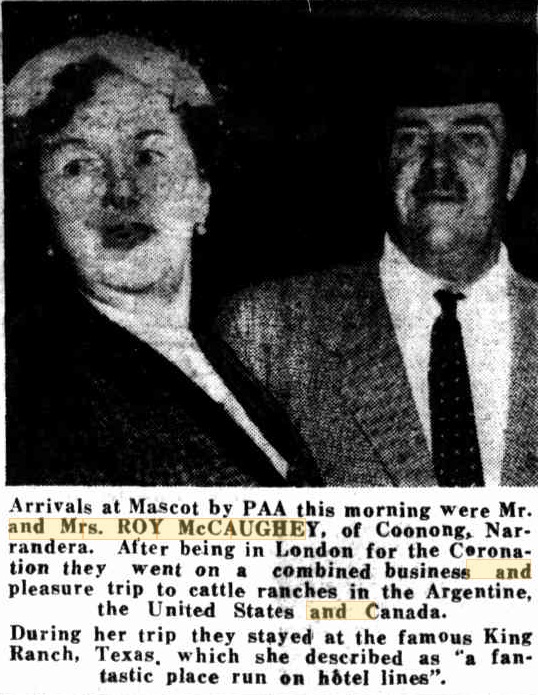
WELL-KNOWN Australian pastoralist, Mr. Roy McCaughey, and his wife, of Coonong, Narrandera, NSW, photographed at Mascot on their return from a combined business and pleasure trip to London for the Coronation and to cattle ranches in the Argentine, the United States and Canada. No title (1953, November 30). Illawarra Daily Mercury (Wollongong, NSW : 1950 - 1954), p. 7. Retrieved from http://nla.gov.au/nla.news-article134002452
The Queen did schedule a visit to Australia as soon as she could and not all events were recorded in the Press in BIG letters:
THE main topic of conversation this week is once again the Royal Tour — with films of the Queen's visit reviving many reminiscences. Here is a story of a little-known ceremony which occurred during the Queen's visit to Canberra— and the significance of which goes back 300 years to Charles II. Charles was keenly interested in science. In 1662 he founded the Royal Society, by granting a Royal Charter, and until this year no monarch had followed his example.
At Canberra on February 16, Elizabeth II founded the Royal Australian Academy of Science. The Prime Minister, Mr. Menzies, thinking to spare the Queen any extra duties, suggested that H.R.H. the Puke of Edinburgh should perform the ceremony, if the charter, which was sent , to England, passed through ] the hands of the Privy , Council in time. Although the normal time for consideration of so important a matter is about eighteen months, the charter to found Australian academy passed all formalities in six weeks and arrived in Australia early to February. ! . On its arrival, the Duke was approached. He immediately discussed the presentation with Her Majesty and they decided that, as the occasion was so historic, the Queen should perform the ceremony herself. ' ; At 4 p.m. on February 16, while the Duke was opening University House, a little behind time, a handful of eminent Australian scientists rose from their seats and quietly made for the cars waiting to take them to the Queen at Yarralumla. After Her Majesty had formally presented the charter, the Duke arrived', from the University and the Academy Council was presented. With a stern face the Duke remarked, 'I saw you rise and leave while I was speaking gentlemen!' As leading scientists Professor M. L. Oliphant, Dr. D. F. Martyn, Dr. A. J. Nicholson and Mr. H, R. Marston fumbled for words, the Duke went on, with a twinkle — 'But don't worry, I knew you were coming here.' Hats off to Mrs. C. M. Guiney and her committee for faultless organising of 'the Gala Preview of 'Queen in Australia' at the State for Red Cross on Wednesday. Even those who wined and dined at a club first managed to be seated before the Governor-General and Lady Slim arrived. Among these were Air Commodore and Mrs. C. B. Wincott, Mrs. John Bovill, the Roy McCaugheys, John Hoppers, Mr. Neville Conroy, the Phillip Yates, the A Lamports, Dr. and Mrs. Ramsay Beavis, Mrs. P. Forter and Mr. A. P. Macterras, father of Charles, [B.B.C. conductor, who wrote the music for the film. Roundabout (1954, June 6). Truth (Sydney, NSW : 1894 - 1954), p. 13. Retrieved from http://nla.gov.au/nla.news-article172057187
There were many 'sightings' of the Queen at Narrabeen and Palm Beach that year too:
Ladies-in-waiting Confuse Crowds.
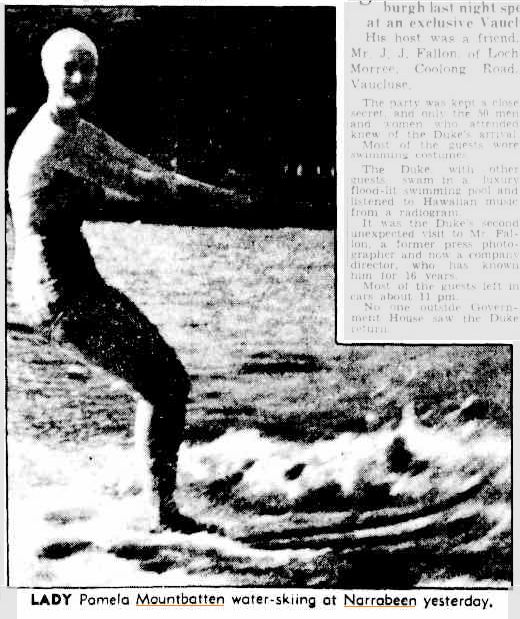 Cars containing the Queen's Ladies in-Waiting confused crowds yesterday who rushed to see the Queen pass. The people thought the Queen would be in the cars. The Ladies-in-Waiting are Lady Pamela Mountbatten and Lady Alice Egerton. Both went driving-Lady Pamela to Narrabeen Lake to water-ski, and Lady Alice to Palm Beach. Hundreds thought Lady Pamela was the Queen when they saw her driving to Narrabeen Lake. She drove to the lake in a Royal tour Daimler. Two men went with her to the lake, and also Miss Elizabeth Northcott, daughter of the Governor of N.S.W.,Sir John Northcott.
Cars containing the Queen's Ladies in-Waiting confused crowds yesterday who rushed to see the Queen pass. The people thought the Queen would be in the cars. The Ladies-in-Waiting are Lady Pamela Mountbatten and Lady Alice Egerton. Both went driving-Lady Pamela to Narrabeen Lake to water-ski, and Lady Alice to Palm Beach. Hundreds thought Lady Pamela was the Queen when they saw her driving to Narrabeen Lake. She drove to the lake in a Royal tour Daimler. Two men went with her to the lake, and also Miss Elizabeth Northcott, daughter of the Governor of N.S.W.,Sir John Northcott.
ARMY DRIVERS
The party used two cars driven by Army personnel. Crowds rushed to the road-side, waving flags and cheering when they saw the two cars approaching. Both cars were black and both bore silver crowns. About 150 people were waiting outside Dalwood Homes, in Wakehurst Park-way in case the Queen passed. They groaned with disappointment when they saw that neither the Queen nor the Duke of Edinburgh was in the cars. Groups of people further along the road caught only a glimpse of the occupants, and thought they had seen the Queen. When told they had not seen the Queen they decided to wait in case she also passed.
Mr. W. Ledsan, president of the Dolphin Water Ski Club, met the party at the lake. Lady Mountbatten then changed from a light cotton print frock into a white swim-ming costume and she and Miss Northcott climbed into a motor boat. Mr. Ledsan drove the motorboat to the end of the lake, where the water was calm. Half an hour later the boat returned towing Lady Pamela on water-skis. Water-ski experts, among a crowd of 200 who watched, said Lady Pamela was a proficient water-skier. She was on the lake for nearly an hour.
PALM BEACH TRIP
Lady Alice Egerton, meanwhile, was in a party of two Royal cars that went to Palm Beach. With her were the Queens secretary, Sir Michael Ademe, her assistant secretary, Colonel Martin Charter is, the Minister in charge of the Royal tour, Mr. Eric Harrison, and the Commonwealth Director, Lieutenant-Colonel F. H.Berryman. Crowds cheered, waved, and tooted motor horns as the cars passed them on the way to Palm Beach. When they saw the Queen was not in the cars they also decided to wait for the Queen. A rumour spread that the Queen's car would come next. At Palm Beach the party went to the home of Mr.Sam Walder. All the party surfed later except Lady Alice, who sat on the beach. Mr. Walder's home is near the home of Mr. J. Carroll, where it was rumoured last week that the Queen and Duke would rest. Ladies-in-waiting Confuse Crowds. (1954, February 8 - Monday). The Sydney Morning Herald (NSW : 1842 - 1954), p. 4. Retrieved from http://nla.gov.au/nla.news-article18408639
In 1956, the Duke of Edinburgh opened the Olympic Games in Melbourne, and opened the 1962 British Empire and Commonwealth Games in Perth, while on a tour through Western Australia, New South Wales and the ACT. In 1965 he opened the Royal Australian Mint, and in 1968 went to Australia to open the Duke of Edinburgh Study Conference.
Queen Elizabeth Queen Mother visited in 1958 to attend the British Empire Service League Conference in Canberra. She travelled to the Australian Capital Territory, Sydney, Melbourne, Tasmania, Adelaide and Perth, as well as many provincial and country areas during the time of her visit 14 February – 7 March.
HER MAJESTY QUEEN ELIZABETH, THE QUEEN MOTHER
The Queen Mother, Queen Elizabeth, arrived in Australia on February 14 after visiting New Zealand. Her Majesty. who last came to Australia 31 years ago with her late husband, King George VI (then Duke of York) arrived in Sydney on Friday, February 21, and was received with great acclamation by the population. Departing from Sydney on Tuesday last to continue her tour of Australia, the Queen Mother will leave for England on March 7 by air, travelling via Cocos Islands, Mauritius, Nairobi and Malta. The above portrait is taken from a Cecil Beaton photograph. HER MAJESTY QUEEN ELIZABETH, THE QUEEN MOTHER (1958, February 28 Friday). Le Courrier Australien (Sydney, NSW : 1892 - 2011), p. 4. Retrieved from http://nla.gov.au/nla.news-article225602736
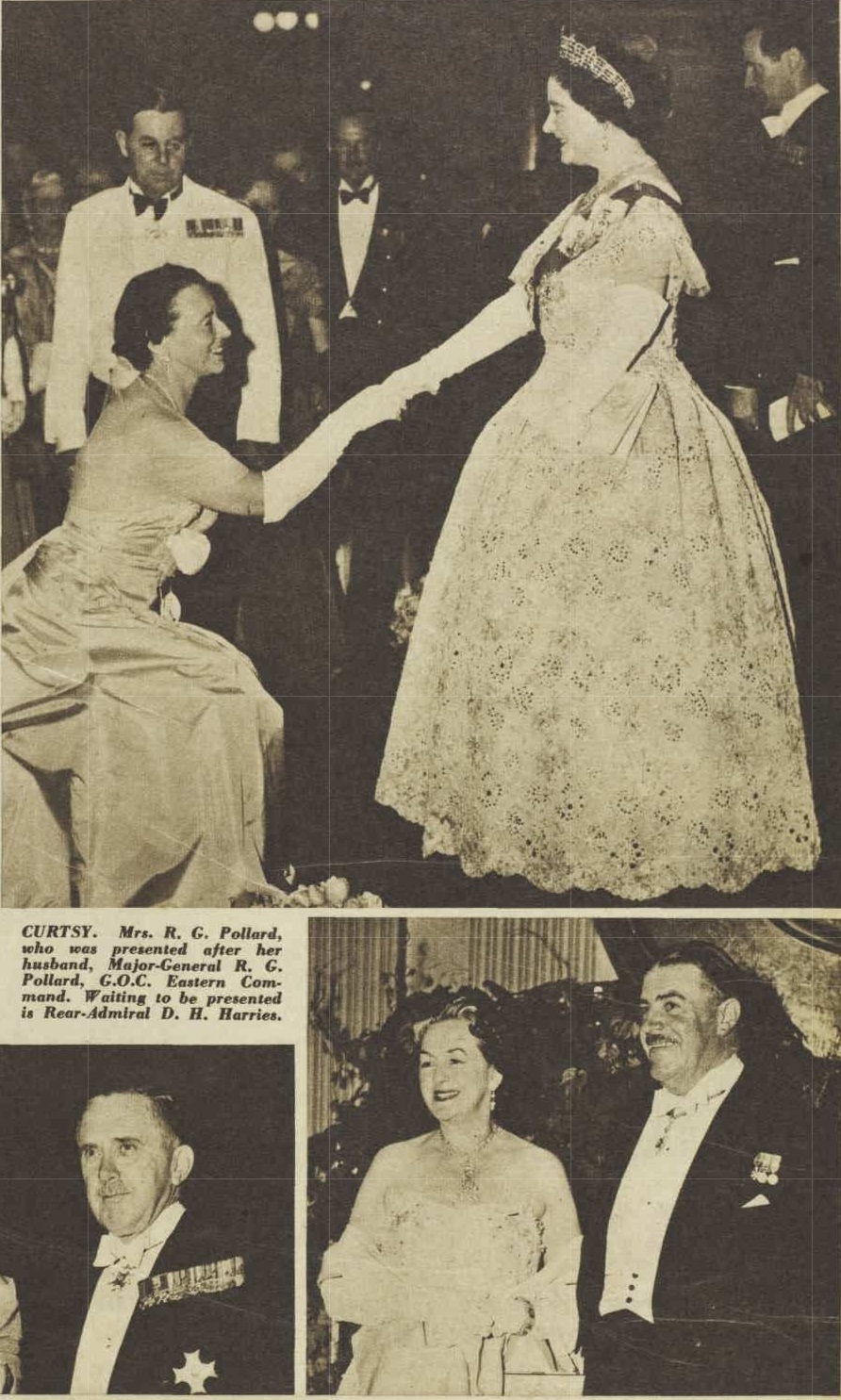
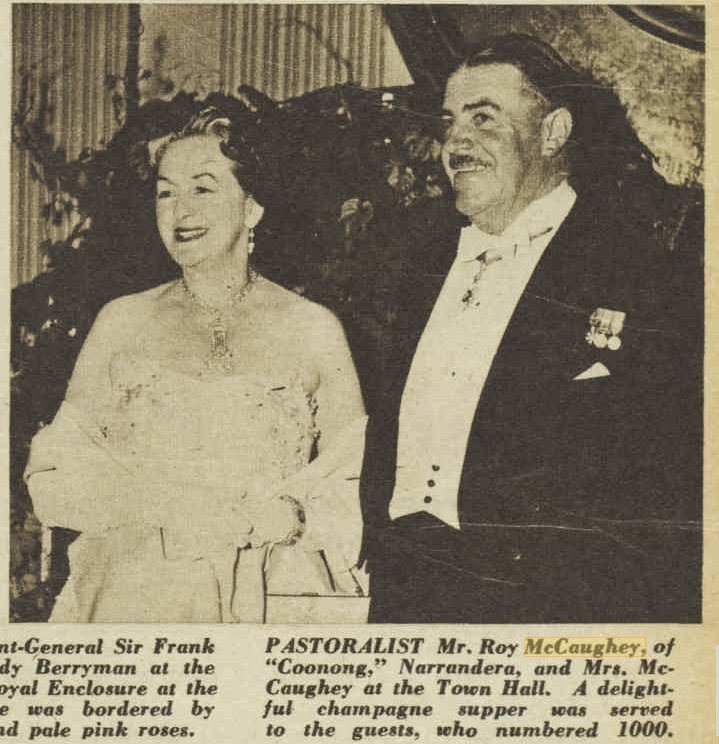
QUEEN MOTHER AT STATE RECEPTION (1958, March 5). The Australian Women's Weekly (1933 - 1982), p. 15. Retrieved from http://nla.gov.au/nla.news-article51598993
Planned as a less formal tour than the one in 1954, the Queen and Prince Philip returned in 1963, touring all the states and territories, with the primary purpose being to lead the Canberra jubilee celebrations commemorating the 50th anniversary of the naming of the capital. During this trip she also toured the Royal Flying Doctor Service of Australia base in Alice Springs. In preparation for this tour, Sir Roy Dowling, the Queen's Australian Secretary for the visit, was warned about Northern Territory mosquitoes. Dowling was warned, "You could be placed in an extremely embarrassing situation if the Queen's skin was marked and if the press published pictures and stories about those marks. Cities and towns visited included Sydney, Canberra, Darwin, Kununurra, Perth, Adelaide, Brisbane, Coolangatta, and Koolan Island.
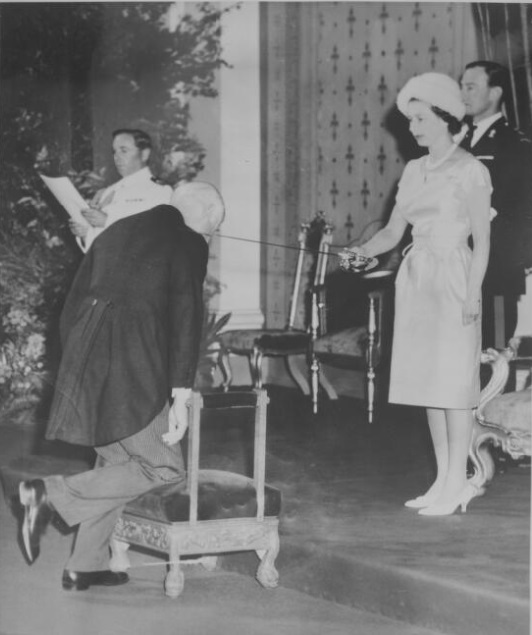
1963, English, No linguistic content, Photograph edition:Queen Elizabeth II investing Roy McCaughey at the Investiture ceremony at Government House, Sydney, New South Wales, 4 March 1963 – was a Monday. State Records of NSW
Samuel McCaughey (1892-1955) and Sir David Roy McCaughey (1898-1971), graziers, were born on 27 November 1892 and 2 October 1898 at Coree station, Jerilderie, New South Wales, third and fourth children of David McCaughey (d.1899), a grazier from Ireland, and his native-born wife Lucilla Louisa Blanche, née Gell. Survived by his daughters, Samuel McCaughey died of leukemia on 29 January 1955 at Manly and was cremated with Presbyterian forms.
MacPHERSON, David Leslie - (Sergeant); Service Number - 408910; File type - Casualty - Repatriation; Aircraft - Mitchell Bomber N5-132; Place - MacDonald, Northern Territory; Date - 4 February 1943
McCAUGHEY.—On the 25th April, 1916, at Maidavale, London, Elizabeth Margaret, wife of John McCaughey, "Yarrabee," N.S.W.
LATE J. McCAUGHEY'S FUNERAL
NARRANDERA, Friday.
The funeral of the late John Mc-Caughey, formerly of Yarrabee Station, Narrandera, took place here after the arrival of the mail tram from Sydney to-day. The remains were followed by a large number of motor cars to the Presbyterian portion of the cemetery, and buried beside those of his brother, Sir Samuel McCaughey. The Rev. W. Carlyle Moulton Officiated at the graveside, and, after the burial service. gave a brief address. In which he referred to the sterling characters of the brothers, Sir Samuel, David, and John McCaughey, and the value of their work as pioneers. Such men, he said, had made the British nation what It is to-day. The chief mourners at the funeral were: Messrs. Roy McCaughey, of Coonong Station; Samuel McCaughey, of Coree Station; A. Stewart (Sydney), and N. Ross, all nephews. Amongst many others present were: Messrs. James Ashton, M.L.C. F. Chomley (Yanco). brother-in-law; F. Chesney (Goulburn), M. Robinson, J. T. Mc-Kinney, F. Young, and J. Salenger, all of Sydney. LATE J. McCAUGHEY'S FUNERAL (1928, June 22). The Sun (Sydney, NSW : 1910 - 1954), p. 11 (FINAL EXTRA). Retrieved from http://nla.gov.au/nla.news-article223218256
Sir David Roy MCCAUGHEY, ,of Coonong, Nerrandera, New South Wales, Australia, b. 2 Oct 1898, Coree Station, Jerilderie, New South Wales, Australia Image, d. 13 Sep 1971, St Vincent's Hospital, Sydney, NSW. Australia
McCaughey is an Irish surname. Spelling variations include: McHaughey, MacCaughey, McGaughey and O'Coffey, among others. Modern spelling comes from ... the original Mac hEochaidh. Meaning: "Son of Eochaidh (pronounced Owey)".
His father passed away when he was still an infant:
Very general regret will be expressed at the news of the sudden death of Mr. David McCaughey, of Coree Station, near Jerilderie, N.S.W., which occurred at Coree on Thursday, 9th February. The deceased gentleman was ill only three days. On the previous Friday he returned to the station from a visit to Sydney, and was then in his usual excellent health. He spent the next two days driving round the station. It is stated, though the fact may have no significance, that on the Monday morning before breakfast he went to his garden and ate some grapes and other fruits. He was taken ill, and Dr. Robinson was sent for from Jerilderie, who, on seeing the patient, at once feared serious results. He advised another medical practitioner being sent for for consultation, as he feared peritonitis. The doctor did everything possible in the meantime, but the inflammation still increased, and the patient died on Thursday morning.
The deceased gentleman was a member of the well-known McCaughey family, being a brother of Mr. Samuel McCaughey, of Coonong, N.S.W., and Mr. John McCaughey, of Yarrabee Park. He came out to the colonies in 1874, and joined his brother at Coonong, and has been engaged in pastoral pursuits ever since. Shortly after his arrival in New South Wales he purchased Coree Station. He has always taken an active interest in pastoral matters, particularly in the direction of breeding, and was an exhibitor at most of the leading shows. He was also a prominent member of the Sheepbreeders' Association. At the time of his death Mr. McCaughey was forty-nine years of age. He leaves a widow and four children.
Jerilderie Thursday morning
David McCaughey came to this colony about 1874, joined he brother at Coonong shortly afterwards and purchased Coree Station within ten miles of Jerilderie, where he has resided ever since. He has always taken an active part in pastoral -pursuits, exhibiting sheep at different shows about the colonies. During late years he has gone more particularly into breeding Vermont sheep. His death look place this morning at 7 a.m., the cause of death being peritonitis. He had only recently returned from Sydney, and when he passed through Jerilderie on Friday his health was excellent. The following two days he spent driving round his station. On Monday morning before breakfast he went into the garden and ate some grapes and other fruits. He took ill immediately afterwards, the illness continuing; till Wednesday night Dr Robinson was sent for from Jerilderie, who, seeing the patient, at once feared serious results, and advised another medical officer being sent for oppsultation, as he feared peritonitis. Dr Robinson did everything in the meantime, but unavailingly ; as inflammation, still increased, and he died at the time stated. Deceased, whose life is said to be insured for £10,000, leaves a wife and four children. His age was 49 years. LATEST PARTICULARS. (1899, February 10). Narandera Argus and Riverina Advertiser (NSW : 1893 - 1953), p. 3. Retrieved from http://nla.gov.au/nla.news-article99248651
Peritonitis is an inflammation of the tissue covering the abdominal organs and abdominal walls. The inflammation is commonly caused by bacterial infection. Peritonitis is a life-threatening condition that needs urgent medical attention.
SIR SAMUEL McCAUGHEY
One of the most readable Australian biographies I have come across in a long while is Samuel McCaughey, by Patricia McCaughey.
Mrs. McCaughey is the wife of Sir Samuel's nephew and successor, Roy McCaughey, of Coonong. Like the McCaugheys, she comes from Ulster, but in an engagingly frank introduction she admits that she had never heard of Sir Samuel until she came to Australia in 1942. At that time she was Mrs. Harold North-Hunt, wife of a senior Malayan Civil Servant. She was evacuated from Singapore, expecting to go to England. Eventually the ship she was in fetched up at Fremantle. The following year she was informed of the death of her husband, and a year after that she married D. R. McCaughey.
Since she made her home at Coonong it was inevitable that she should hear much of her husband's uncle and realise the strength of his influence, not only in the organisation of Coonong, but in Australia's pastoral affairs. 12 Stations Readers or The Farmer and Settler had their memories refreshed regarding Sir Samuel McCaughey's achievements in an article by James Jervis, published last September. In that article he was described as 'the man with a million sheep' and references were made to his very important sheepbreeding experiments and his development of irrigation.
Mrs. McCaughey has done much to round out the picture of the man who once owned 12 vast stations, and who introduced Vermont sheep and was strong-minded enough to cut his losses as soon as he found them unsatisfactory. He would have been keenly interested in the success of myxomatosis, for he fought rabbits all his life and in 1905 went to Paris to consult the famous Louis Pasteur on extermination methods. Mrs. Mrs. McCaughey writes that Pasteur was hopeful. 'I have killed all the rabbits on a certain vineyard in France. How large is your property?' he asked. Shock For Pasteur When McCaughey told him, Pasteur raised his hands in consternation. 'It is beyond me. It is as big as the whole of France,' he exclaimed. As a matter of fact, his estimate was not far. out! Another interesting side of Samuel McCaughey's activities was his love of engineering and his inventions for improving his farm machinery. His station, Toorale, was the first to have electric light in its shearing shed; while another of his properties, Dunlop, was the first to use machinery for shearing.
In his emphasis on water for property improvement he pioneered artesian bores. He also designed ploughs and earth scoops. But sheep men will be particularly interested in the details of Sir Samuel McCaughey's breeding experiments. All his operations were on a big scale and his purchases of stud sheep were among the most spectacular of the lot. Millionaire When the Ver m o n t s proved unsatisfactory for his hot Riverina properties he did not waste any time before re-stocking with more suitable strains. Such bold expenditure brought like returns. Sir Samuel died in 1919 and left £1,725,000, of which nearly £1,500,000 went in bequests to universities, schools and churches, with a special bequest of £458,000 for soldiers and their dependants. Sydney University also received £458,000. This was money for education and research on the grand scale. Mrs. McCaughey has had the advantage of being able to study her subject in the library at Coonong, which contains all the records its founder so methodically compiled — and they are voluminous. In this investigation work she was assisted by the Rev. Archibald Crowley, of Urana. While in England in 1948 she also studied the McCaughey background in Ulster. Mrs. McCaughey has produced a fascinating book about a many-sided character. She has not only taken full advantage of ample and colorful material; her chapters are eminently readable. — Michael Harvey. Books and Comment (1955, June 17). The Farmer and Settler (Sydney, NSW : 1906 - 1955), p. 20. Retrieved from http://nla.gov.au/nla.news-article123147234
Her book is available online in full now at: https://asrp.files.wordpress.com/2015/12/mccaughey-the-book.pdf
Her Introduction:
Until I came to Australia in 1942 I had never heard of Sir Samuel McCaughey. In fact, I knew of Australia only by hearsay, and very little at that. Certainly it had never entered my head that I might come to live in this country—until on one never-forgotten day the captain of the ship which I thought was taking me to England announced to his astounded passengers: 'In one hour's time we'll be in Fremantle!'
I had been living in Singapore with my husband, Harold North-Hunt, a senior Malayan Civil Servant who held the posts of Registrar-General of Statistics, Births, Marriages and Deaths, Controller of Restricted Imports and Exports, Controller of Rubber and Director-General of Supplies. When the Japanese advance on Singapore suddenly became a hideous certainty, I was hurriedly evacuated with a group of other women on February 5th 1942, ten days before the fall of Singapore, in an Old Dutch cattle ship, the Rochussen. Our orders were that each of us was to take a mattress and four days' supply of tinned food; luggage was out of the question.
I tied my jewellery and papers in a bag round my waist. There was no time to get my passport, so my husband hastily wrote out and signed a form for me which he hoped would serve in lieu of this, and we said good-bye to each other on the wharf, with no idea of when, if ever, we would be reunited. We knew that the ship was to make for Batavia, and then, we hoped, I could get a passage from there to England.
The Rochussen had just unloaded a cargo of pigs at Singapore, there was no time to clean the ship, and we women huddled on deck in conditions that were unimaginably filthy. Soon after leaving Singapore we were bombed for fifty minutes by Japanese planes, but somehow we escaped being hit, and six days later, after a horror-voyage which I prefer to forget, we reached Batavia.
Here we were transferred to the Glenartney, a British ship which had been on its way to Singapore carrying ammunition and big guns for the Prince of Wales and the Repulse; on the news of the sinking of these warships she had been halted at Batavia. We refugees set out on her for England—as we believed; most of us came from the Old Country. Just after leaving Batavia seven Japanese bombers circled overhead, and knowing the cargo we carried (the guns and ammunition had not been unloaded), we were convinced that our journeys end had come almost before we had started.
However, by the mercy of God the planes did not attack us, and we continued on our way, believing that each day of this black-out voyage was bringing us nearer to our people in Britain. The captain's announcement, after we had been some four weeks at sea, that we would reach an Australian port in an hour's time seemed too incredible for us to take in.
Nevertheless the outline of the coast gradually took shape, and I saw Australia for the first time. But I was not to set foot on it until we reached its far eastern seaboard, the spy-conscious authorities refused to accept my makeshift passport, and would not allow me to land. Although the thought of stepping ashore on dry land seemed inviting, I was too ill and apathetic to care very much when I was told that I would have to go on to Sydney, where they hoped to be able to clear up my position. One part of Australia did not mean anymore to me than another at that time.
So it was Sydney where I first set foot in Australia, and as it turned out it is New South Wales where I have made my home.
I passed through times of acute anxiety and suspense about the fate of my husband before I finally learnt, in 1943, that he had died while a prisoner in Japanese hands in Singapore. But from the day of my arrival in Sydney I met with such kindness and understanding and generosity that I have come to love the country and its people.
In 1944 I married an Australian, David Roy McCaughey, and the nightmare years of wartime grief and strain are passing from my mind. Although I must always love Northern Ireland, the land of my birth, I have adopted my husband's country, and have come to consider myself an Australian, as concerned in her welfare and as proud of her achievements as if I were native-born.
To my mind, the greatest achievement in Australia is the taming of this wild continent, in many parts so harsh and unfriendly to man; a churlish, hostile land, resisting settlement, withholding the bounty she possesses, and needing to be coaxed to fertility. Yet this is a land which has shown she can respond magnificently to men of courage and vision, to pioneers who cherish a faith in her potentialities and who have the energy for sustained hard work.
As time went on I began to hear more and more about that great Irish-born pastoralist. Sir Samuel McCaughey, my husband's uncle. Although he had died twenty three years before I arrived here, his name seemed to crop up whenever anyone mentioned Australia's pastoral development. I came to realize that he had possessed all the fine pioneering qualities in abundance.
He gave them generously to Australia, and his adopted country responded a hundredfold to his efforts. I learnt that Sir Samuel McCaughey was indeed one of the makers of Australia, and one of the greatest forces in the development of the sheep-breeding and wool-producing industry of the country. It was largely due to his experiments (carried out regardless of cost) and sound judgment that the average yield of wool from a single sheep was increased during his lifetime from about five to nine pounds—and much superior wool at that. His labours in irrigation and in opening up the outback, added to his princely benefactions, greater than those of Cecil Rhodes, have increased the debt Australia owes to him.
I feel that the example of this doughty Ulsterman can be an inspiration to coming generations; that is why I have wanted to publish this book. I first began to visualize Samuel McCaughey as a person when, just after our marriage, my husband drove me to his home at Coonong in the Riverina district of New South Wales. This was the first property which Samuel McCaughey had owned in Australia.
The solid homestead of concrete-faced brick had been built by him and here he had made his home for nearly forty years. As we motored from Sydney towards the west the miles seemed endless and unvarying. It was the end of a droughty summer and the paddocks were brown and bare as the road we travelled on. I thought of the young Samuel McCaughey journeying through these areas by horse transport some ninety years earlier. What an undertaking it must have been to travel inland at that period, over ill-made roads! Yet I realized that the first pioneers, making their way through trackless bush, knowing nothing of what lay beyond, experienced a far greater ordeal. They were assuredly men of stout hearts and confident faith to venture so far from civilization into the unknown.
As we motored on through what seemed to me immense distances, there stretched limitlessly around us the great Australian loneliness, as Ernestine Hill has so truly called it. Kangaroos bounded away through the paddocks at our approach and emus stalked disdainfully among the distant trees. Flocks of galahs streaked the air with their lovely grey and pink plumage; occasionally a mirage gave promise of a nonexistent lake, but for scores of miles at a stretch the only signs of human habitation were the fences beside the never-ending road. I felt infinitely remote from anything I had ever known.
Yet my husband assured me that this was considered a settled district. ‘Wait till you see the real outback,' he said. But like so many newcomers to Australia my imagination refused to take it in.
At length we came onto Coonong property and at intervals we passed through gates which divided the paddocks. Now and then I glimpsed some sheep, dusty forms scarcely discernible against the brown paddocks. Then suddenly we entered a long drive leading to the homestead which we could not yet see. Unbelievably it was lined with magnificent poplars and willows, all well-watered by a system of irrigation. It formed an incongruous belt of green in the midst of the arid country stretching away on every side.
Then the homestead came in sight—a kindly, green oasis of lawns and lakes, trees and flowers, encircling a gracious white house surrounded by deep verandahs. Although ever since it was built it had been a bachelor establishment, it had the air of a well-loved home, and I took to it immediately,
At Coonong the sense of Sir Samuel's personality possessed me powerfully; I was continually conscious of him. As I walked through the garden or sat by the lake, as I moved about the house, it was almost as if he were beside me in person. It might have been because he and I had both been born in Northern Ireland that I felt this sense of his continued presence so intensely. I pictured him planning and building the homestead; it seemed to express the man so adequately.
Wellbuilt, of good proportions, it was spacious and solid, in harmony with its setting; no outward show, and, as one would expect from a man so seized with the importance of water in this dry land, there was a lake in front of the house and another one at the side. (This latter was designed by my husband, who is also a firm believer in the value of plenty of water, and is a keen gardener.)
How I wished I could have actually known this remarkable man who had done so much for the pastoral development of Australia. I eagerly pored over photographs and old diaries, newspaper cuttings and pamphlets which I found in the library, trying to gain some clue as to why he had been able to achieve so much more than the average person; but the explanation eluded me.
Here and there nature throws up an exceptional character created by a happy combination of the place, the time and the man. One such was Samuel McCaughey, nation-builder and philanthropist. During his lifetime he made an immense contribution to the development of his adopted country, and his bequests to education, the church and other worthwhile objects were the greatest ever made by any individual in Australia. I wanted to learn all I could about him.
When my husband took me on a visit to England in 1948 we went across to Ulster and visited the scenes of Samuel McCaughey's early life. I interviewed everyone who could give me further facts. Then on my return to Australia I asked the Rev. Archibald Crowley, of Urana, to do some research for me. Most of the material in this book is due to his enthusiastic and comprehensive investigations into the life and activities of Samuel McCaughey. Without his help this book could never have been completed. Patricia McCaughey
That same year her husband lost his brother:
OBITUARY
MR. SAMUEL McCAUGHEY
Mr. Samuel McCaughey, a member of one of the State's best-known grazing families, died at Manly District Hospital on Saturday, 29th January, aged 62.
He had been in poor health for some years. He was taken ill at his home in Alexander Street, Manly, early on the Saturday and died a few hours later. Mr Samuel McCaughey and his brother, Mr. Roy McCaughey, in 1952 gave 24,000 acres of Coree sheep station to the nation for establishment of a pastoral research and training institute. A trust consisting of Sir Henry Manning (chairman) and Messrs Roy McCaughey and J. P. Abbott, is administering Coree, as a commercial enterprise. Income will be used for the development of research and education. The Institute is a Memorial to the late Lieutenant Samuel Michael McCaughey and the late Air-Gunner David Leslie Macpherson, who were killed in World War II. Lieut. McCaughey was the son of Mr. Samuel McCaughey and Air-Gunner Macpherson was his nephew. The McCaughey family has made many gifts to education and research. Sir Samuel McCaughey, an uncle of the late Mr. Samuel McCaughey, left public benefactions of more than £1,000,000 when he died in 1919. The late Mr. Samuel McCaughey is survived by four daughters, Unity (Mrs. M. Pheils), Miss Patricia McCaughey, Sally (Mrs. D. Birkbeck), and Anne (Mrs. Gregory); sisters, Dorothy (Mrs. B. D. Grantham and Maude (Mrs. E. G. Dermar), and brother, Mr. Roy McCaughey. His wife and son, Samuel Michael, predeceased him. Private cremation took place on Monday, 30th January. OBITUARY (1955, February 10). Jerilderie Herald and Urana Advertiser (NSW : 1898 - 1958), p. 4. Retrieved from http://nla.gov.au/nla.news-article134725185
IN the Supreme Court of New. South Wales.—Probate Jurisdiction.—Re mil of SAMUEL McCAUGHEY, late of 23 Alexander-street, Manly, in the State of New South Wales, retired grazier, deceased,—Probate granted, by the Supreme Court of New South Wales on 2nd December, 1955.—Pursuant to th$ Wills, Probate and Administration Act, 1898-1947, the Testator's Family Maintenance and Guardianship of Infants Act, 1916-1938, and Trustee Act, 1925-1942, David Roy McCaughey, of Coonong, Narrandera, in the State of New South Wales, grazier, Stanley William Byrne, Samuel Austin Frank Pond and Peter Balmford, all of 166 Queen-street, Melbourne, in the State of Victoria, solicitors, the executors of the will of the said Samuel McCaughey, who died on the 29th January, 1955, hereby give notice that creditors and others having any claim against or to the estate of the said deceased are required to send particulars of their claims to the said executors, care of the undersigned proctors, on or before the 19th December, 1956, at the expiration of which time the said executors will distribute the assets, having regard only to the claims of which they than have notice.—Dated this 10th day of October, 1956. WHITING & BYRNE, 44 Martin-place, Sydney, Proctors for the Executors, 1314—£1 5s, IN the Supreme Court of New South Wales.—Probate Jurisdiction.—Re will of SAMUEL McCAUGHEY, late of 23 (1956, October 19). Government Gazette of the State of New South Wales (Sydney, NSW : 1901 - 2001), p. 3089. Retrieved from http://nla.gov.au/nla.news-article220346550
ROLL OF HONOUR
McCAUGHEY.-December 29, 1943, killed in action, New Guinea, Lieut. Samuel Michael, only son of Mr. and Mrs. S. McCaughey, Coree, Jerilderie, aged 22 years. Family Notices (1944, January 13). The Sydney Morning Herald (NSW : 1842 - 1954), p. 10. Retrieved from http://nla.gov.au/nla.news-article17889917
Last Summer for McCaughey’s at 'Hopton Lodge', Bayview
BECAUSE everyone will have had so much poultry and ham by then, Mr. and Mrs. Roy McCaughey are going to entertain friends at a barbecue luncheon party at their sea-side home, Hopton Lodge, Pittwater Rd., Bayview, on New Year's Day. The barbecue at Hopton Lodge is really out of the box — set in a glorious garden and wire screen enclosed — so that not a fly can buzz round the sizzling steaks. SOCIAL ROUNDABOUT (1961, January 4). The Australian Women's Weekly (1933 - 1982), p. 12. Retrieved from http://nla.gov.au/nla.news-article46469324
The wire screen enclosed 'garden room' (left of photo) now has glass panes installed
Although a fair amount of images of the McCaughey’s can be found, those at Bayview during their ownership years don't illustrate how the house looked when they visited there. When another sailor, passionate about sailing in fact, takes up residence a few more become available through The Australian Women's Weekly.
Owned by Olympic sailing gold medallist Sir William (Bill) Northam O.B.E. until 1981
W H Northam had married Esther Barbara Herford on June 21st, 1929 at St Andrew’s Church of England, Roseville; she died in a car accident in 1946. He married Alison Mary Dwyer, née Walker, on April 10th, 1948 at the district registrar’s office, Chatswood. Serving as an alderman on Sydney City Council from 1956 to 1965, he ran unsuccessfully as the business-oriented Civic Reform Association candidate for lord mayor in 1962.
Appointed CBE in 1966, Northam was knighted in December 1976. His wife Alison had died earlier that year. On May 28th, 1977 at his mansion, Hopton Lodge, Bayview, he married with Presbyterian forms a widow Dulcie May Stephen, née Hill.
SIR WILLIAM NORTHAM, perhaps the greatest yachtsman Australia has ever produced, won an Olympic gold medal at 60. That was 12 years ago but, far from sitting in his big house at Bayview, on Sydney's North Shore, and dreaming of the old days, he was busy last month helping to prepare Gretel II in its unsuccessful challenge for the America's Cup at Newport. As co-manager of the Gretel II syndicate, he was out on the water or at dockside daily, giving the benefit of his Newport expertise. Sir William was among the first Australians to arrive in 1962 with the late Sir Frank Packer, who challenged twice for the cup. "I'm lucky to have got over the usual complaints of age. I do manage to enjoy life, work, play and love."
His first wife was killed in a car crash 30 years ago, and his second, Vivien, succumbed to a coronary last October. Sir William asked a long-time friend, Dulcey Stevens, who is proprietor of Sydney's Pickwick Club, to help reply to the letters of condolence. The letters disposed of, Bill and Dulcey were married in April. HOW TO BE AS Young as you feel (1977, September 21). The Australian Women's Weekly (1933 - 1982), p. 61. Retrieved from http://nla.gov.au/nla.news-article45654972
A glimpse at Hopton Lodge soon after the Northam's bought it shows a painting by a local Artist is in residence too!:
OLYMPIC YACHTSMAN'S HOME.
Pictures by staff photographer Keith Barlow.
Magnificent waterfront views blend with the formal beauty of "Hopton Lodge," the home of Mr. and Mrs. Bill Northam at Bayview, N.S.W. The house, with its own private jetty and boatshed on the shores of Pittwater, is particularly suited to the interests of its owners, both of whom are keen sailing enthusiasts. Mr. Northam is skipper of the crew which will represent Australia in the yachting section at the Tokyo Olympic Games.
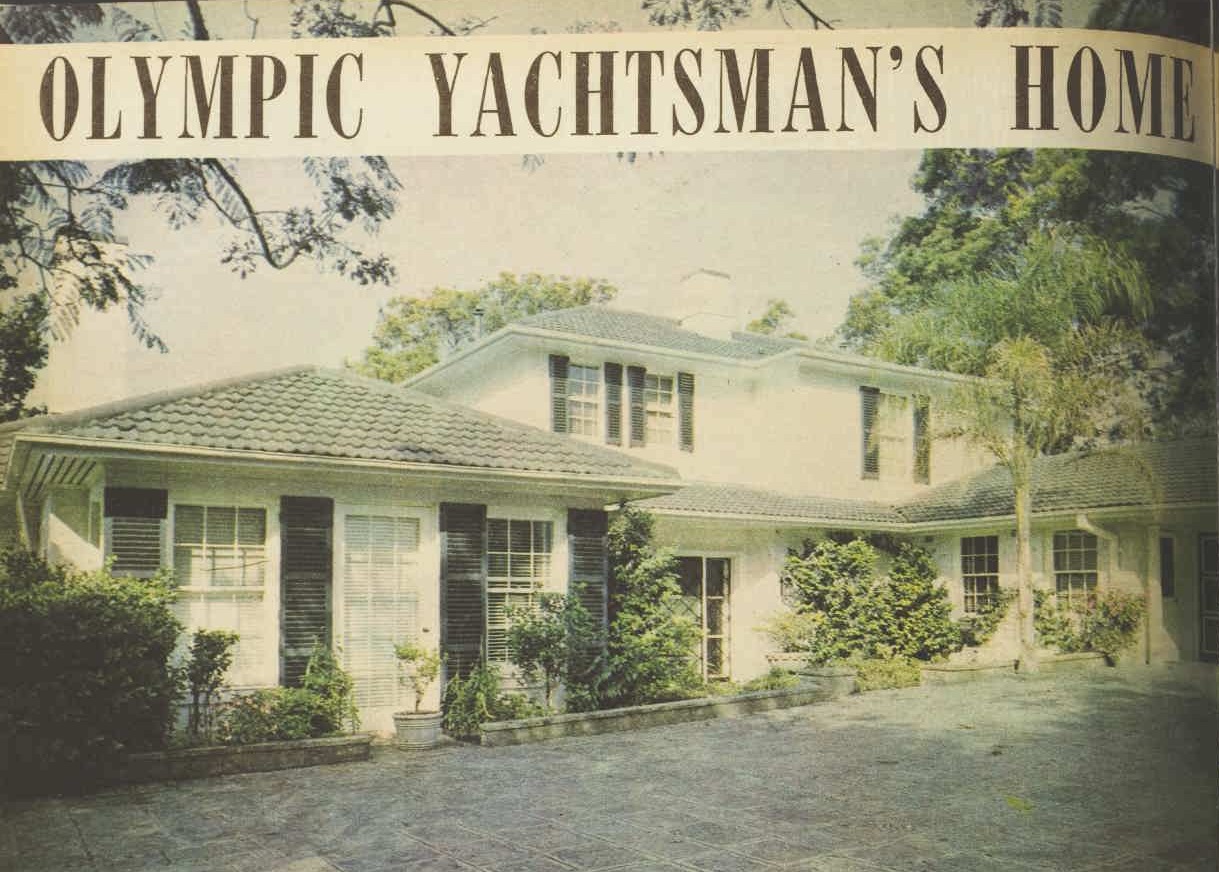
PAVED COURTYARD of sandstone (above) leads up to the entrance of "Hopton Lodge" the home of Mr. and Mrs. Bill Northam at Bayview, N.S.W. The house, which is painted white with grey shutters and a grey tiled roof, is set among beautiful gardens which are Mrs. Northam pride and joy. Other side of house looks over Pittwater.
.jpg?timestamp=1557025325751)
ENTRANCE HALL (left) is dominated by black and white floor and the beautiful multicolored circular rug which was purchased in Hong Kong especially for this hall. The walls are covered Japanese grass paper and the Chinese scroll is 18th century. At the bottom of the staircase is a bronze Chinese temple Painting at the end of the entrance is by Phillip Sutton.
.jpg?timestamp=1557025423075)
SUPERB VIEWS of Pittwater can be seen from the balcony (above), which overlooks sweeping lawns and beautiful gardens stretching almost to the water's edge. The charming balcony rail is creeper covered and has steps leading on to lawn. Above the balcony is a scene of terraces used for outdoor entertaining and summer parties.
.jpg?timestamp=1557025486742)
STUDY (below) reflects Mr. Northam's greatest love, sailing. Cups and trophies decorate the bookcases and mantelpiece and there is a model of a sailing vessel beside the portrait of Mr. Northam painted by noted Australian artist William Dargie. Desk is mahogany veneer and chairs are of hide.
.jpg?timestamp=1557025548825)
BEDROOM (above), where the all-white painted furniture is a foil for the clever toning of greens and yellows. Lemon walls belend with green silk day bed, end stool and chair. Curtains are a floral print. A bathroom leads off at right I THF i lnS-room and walk-in wardrobe are at left. BRIGHT DINING-ROOM (above) is a pleasing combination of soft tangerine and olive-green. Suite is pickle-finished wood with orange leather chairs, and the buffet is black lacquered wood with hand-painted orange doors. Olive-and-white striped curtains match carpet and wall. Painting over buffet is by Sali Herman.
.jpg?timestamp=1557025630367)
LIVING-ROOM (above) is a subtle combination of elegance and informality needed in a waterfront home. Silk curtains hide a huge window which looks out over wonderful view of Pittwater. Citron curved lounge is scattered with silk cushions. Sofas and armchairs are of floral printed chintz. Round table has a red leather top, coffee tables are of marble on brass frames. Cabinet contains Mrs. Northam's jade collection. OLYMPIC YACHTSMAN'S HOME (1964, September 2). The Australian Women's Weekly (1933 - 1982), p. 52. Retrieved from http://nla.gov.au/nla.news-article51394854
Hopton Lodge Sundial still in place in 2019
There are more in the article published by the same magazine as the Northam's are moving closer to town in 1981 - the description hasn't changed much though:
Sir William Northam's new 'voyage' from oceans of space to a harbour haven
by ROBIN AMADIO - Pictures: KEVIN BROWN
.Sir William Northam’s new 'voyage'
From oceans of space to a harbour haven
Moving house and changing one's life-style from living in a spacious 18-room mansion to living in a compact three-bedroomed unit can be quite an ordeal - especially when you are 75 years old.
But Sir William Northam and his charming wife Dulcie found Hopton Lodge, their magnificent, million-dollar mansion at Bayview, north of Sydney, "just too much to handle," and they are selling it this month.
To replace Hopton Lodge, set on 3155 square metres, they have chosen a three-bedroomed unit at Point Piper, Sydney, with, of course, a harbour view.
Sir William. Australia's first Olympic yachting gold medallist, is taking it all in his stride. "I have no regrets at all." he said about selling and leaving Hopton Lodge after 20 years.
Sir William, optimistic and cheerful, says he is used to changes late in his life - "after all, I was a grandfather and the oldest man at 60 ever to win an Olympic gold medal," he laughed.
Hopton Lodge, built by the late merino stud owner Sir Roy McCaughev and Lady McCaughey, is a big, white, rambling house with shutters framing the windows. It has a magnificent view north along Pittwater and beyond, taking in the yachtsman's landmark, Lion Island.
Upstairs the house is designed for family living with two master bedrooms and ensuite bathrooms. Downstairs the rooms are large with a guest wing.
The main reception vestibule has big, bold, black and white vinyl squares with a huge shaggy oval rug in autumn tonings. The vestibule leads to a sitting room opening to a sandstone terrace.
Folding louvred doors divide the sit-ting-room from the dining-room, which has a matching buffet sideboard unusually decorated with the 12 Zodiac signs.
Off the dining-room is the large kitchen leading to the flower preparation room, utility wine storage-room and three-ear lock-up garage.
There are minor difficulties with the big move. Problem number one: what to do with all the silver cups and trophies Sir William has won and collected over the years for golf, bowls, motor racing and yachting? And then there are all the photographs and paintings of famous friends and champions.
The trophies and cups gleam in the sunlight on one wall in the breakfast room. Everything else is in Sir William's "Me Room," an appropriate name for his
The dining-room, off the sitting-room, seats 12. The table has a matching buffet. 3^ 55 square I
large study and adjoining bar-room. In the "Me Room" is an excellent William Dargie painting of Sir William keeping! watchful eye on his Olympic gold med» More pictures overflow into the screened barbecue-room.
Lady Northam intends to set up another smaller "Me Room"' for her husband in the new unit - probably the third bedroom.
Sir William has no regrets about leaving his boathouse, slipway and jetty because he parted with his boats some time ago. He won't miss his filtered saltwater swimming pool either, because he will continue his daily exercise in the pool at his unit. -
The sitting-room is long and gracious, but is still colourful and modern. Trophies gleam in the breakfast-room, which has a lovely view over the garden.
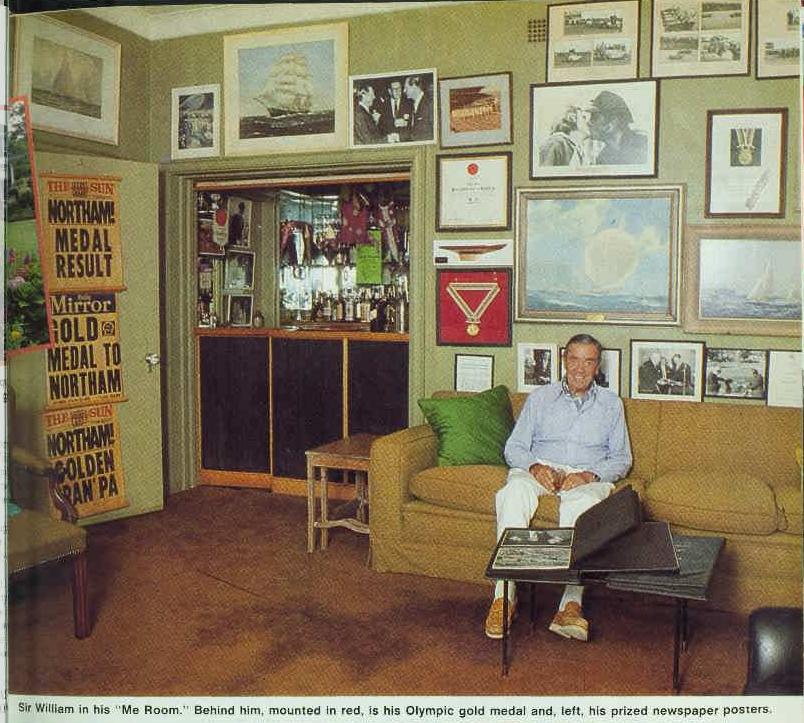
Sir William in his "Me Room." Behind him, mounted in red, is his Olympic gold medal and, left, his prized newspaper posters. Sir William Northam's new 'voyage' from oceans of space to a harbour haven (1981, March 11). The Australian Women's Weekly (1933 - 1982), p. 74. Retrieved from http://nla.gov.au/nla.news-article55458369
Hopton Lodge was owned by Howard and Ann Goddard from 1981 until 29th September 2000.
The property at 1758 Pittwater Road traded for $5.5 million in 2000, when it was bought by commercial property developer Max Delmege and his wife, Narelle. Owned by Max and Narelle Delmege from 29th September 2000 until 26th March 2007.
Owned by John and Caroline Forbes from 26th March 2007 until the present day, the home still hosts a fundraiser annually through Caroline's determination to do so and the garden is filled with countless varieties of original hibiscus plants. The Forbes focus on maintaining the garden and making it better has also been part of their keeping this old beauty as close as possible to how she was. The walls of the original section of Waiwera display old photographs of the area tracked down by the Forbes family, and John Forbes shares his knowledge and insights on sailing with the next generation, albeit a little more quietly than Sir Northam did, but just as effectively.
Waiwera and Hopton Lodge has been through the successive hands of some pretty amazing Australians. The historic 'Summer Cottage' and its stories remains safe in the current generations that look after this grand old beauty. The Forbes family, if the whole story could be told, are pretty amazing Australians themselves.
Definitely something to warm you up as it grows colder here - Summer is over - but this part of Pittwater, thanks to just one family, is not.
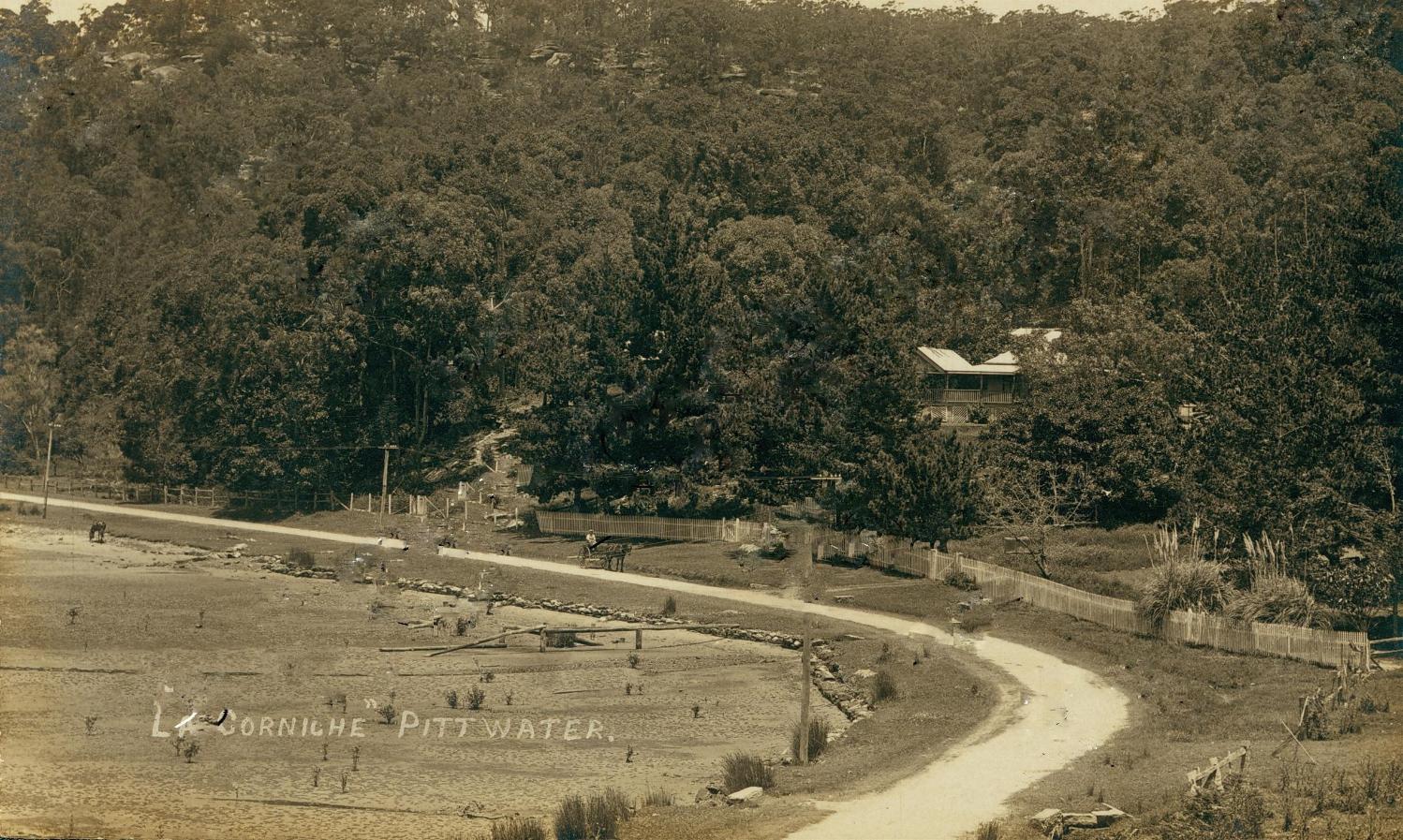
Fig Tree Flat La Corniche Bayview circa 1900 - 1910
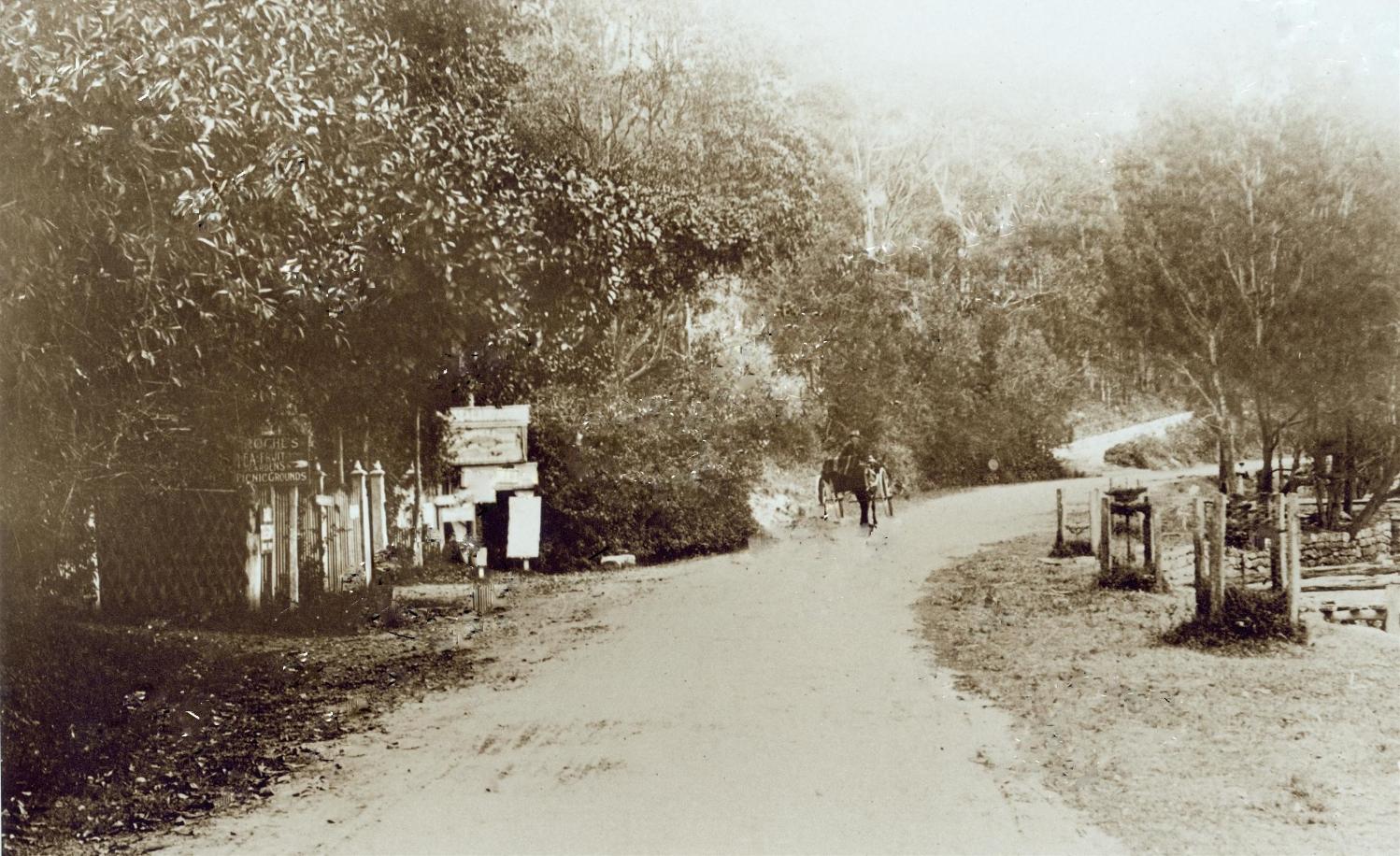
Hopton Lodge Book Library - decorated and installed by the Forbes
The View on a Sunday Afternoon on Pittwater in 2019
Left to right: Barbara and Margaret and Elizabeth Tink with John Forbes, April 2019.